NuSTAR (Nuclear Spectroscopic Telescope Array)
Non-EO
NASA-JPL
Quick facts
Overview
| Mission type | Non-EO |
| Agency | NASA-JPL |
| Launch date | 13 Jun 2012 |
NuSTAR (Nuclear Spectroscopic Telescope Array)
Spacecraft Launch Mission Status Sensor Complement Ground Segment References
NuSTAR is a NASA-funded SMEX (Small Explorer) mission that carries the first focusing hard X-ray (5 - 80 keV) telescope to orbit. NuSTAR will offer a factor 50 - 100 sensitivity improvement compared to previous collimated or coded mask imagers that have operated in this energy band. In addition, NuSTAR provides sub-arcminute imaging with good spectral resolution over a 12 arcminute FOV (Field of View).
NuSTAR will carry out a two-year primary science mission that focuses on four key programs: studying the evolution of massive black holes through surveys carried out in fields with excellent multiwavelength coverage, understanding the population of compact objects and the nature of the massive black hole in the center of the Milky Way, constraining explosion dynamics and nucleosynthesis in supernovae, and probing the nature of particle acceleration in relativistic jets in active galactic nuclei. 1) 2) 3) 4)
The NuSTAR program is managed for NASA by the JPL (Jet Propulsion Laboratory) in Pasadena, CA. The PI (Principal Investigatior) of the mission is Fiona A. Harrison of Caltech (California Institute of Technology). The NuSTAR spacecraft and its payload feature three key technologies to accomplish the mission: 5) 6)
• Hard X-ray optics
• Deployable mast (of SRTM heritage)
• CdZnTe (Cadmium Zinc Telluride) detector technology.
The NuSTAR Small Explorer mission will be the first astronomical telescope on-orbit to utilize the new generation of hard X-ray optics and detector technologies to carry out high-sensitivity observations at X-ray energies significantly greater than 10 keV. Figure 49 shows the total effective area for both telescopes as a function of energy, with a comparison to Chandra (NASA) and XMM-Newton (ESA).
In addition to its core science program, NuSTAR will offer opportunities for a broad range of science investigations, ranging from probing cosmic ray origins to studying the extreme physics around collapsed stars to mapping microflares on the surface of the sun.
Background: NuSTAR is a part of NASA's Explorer Program. While the mission was selected for a Phase A study in 2003 and for a further study in 2005, it was ultimately cancelled by NASA in February 2006 due to agency budget limitations. On September 21, 2007 it was announced that the program had been restarted, with an expected launch in August 2011, though this was later delayed to Q1 2012. 7)
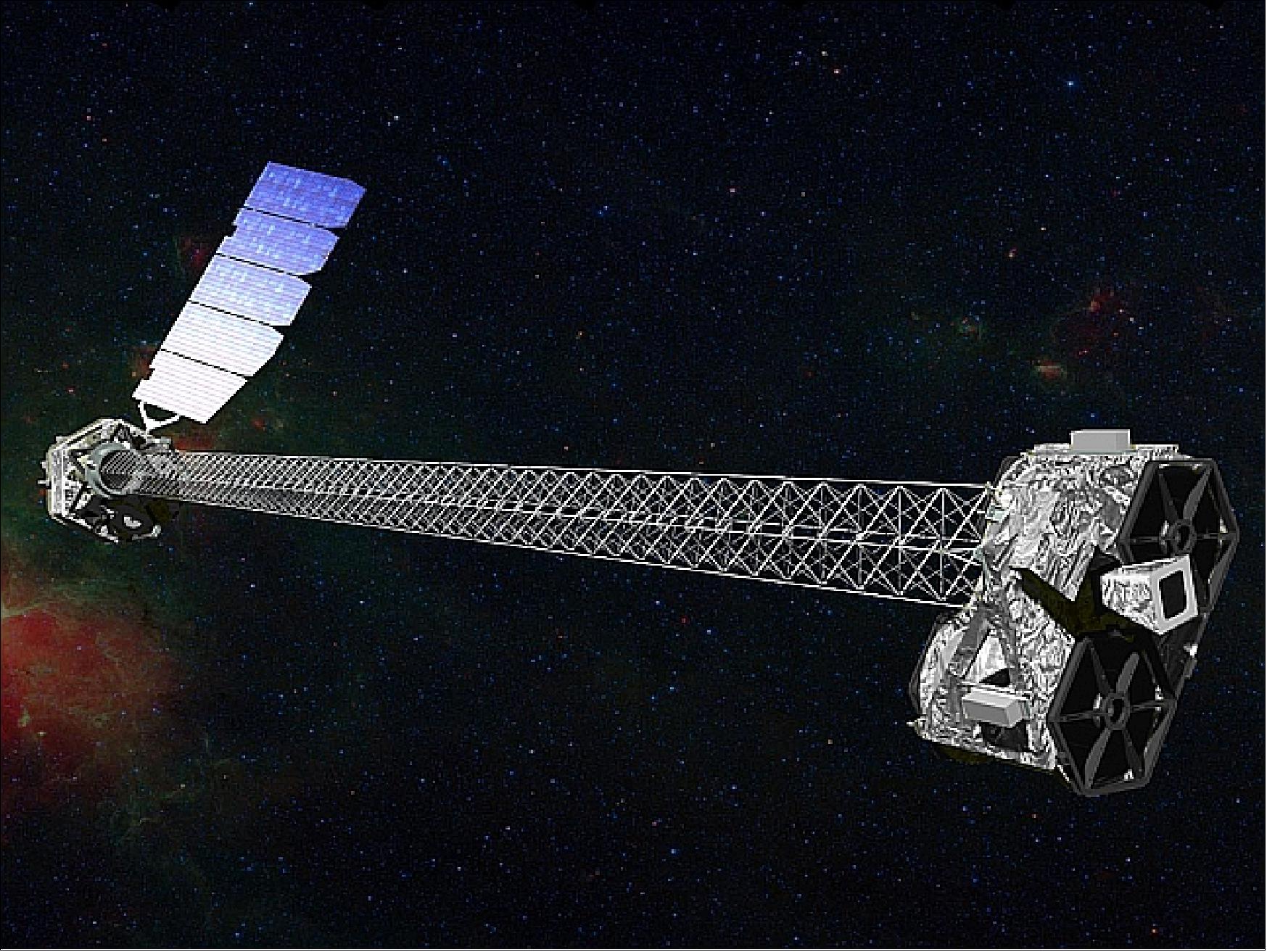
Legend to Figure 1: The spacecraft features a mast 10 m in length that deploys after launch to separate the optics modules (right) from the detectors in the focal plane (left).
Spacecraft
The NuSTAR minisatellite is based on OSC's (Orbital Sciences Corporation) proven LEOStar-2 bus design of Dulles, VA. The spacecraft is three-axis stabilized with a single articulating solar panel and relies predominantly upon a multi-head star camera (µASC) of DTU (Danish Technical University) for attitude sensing. This enables 80% of the sky to be accessed at any given time, which allows ToO (Target of Opportunity) viewing with few restrictions as well as aids in mission planning. 8)
RF communications: There will be daily downlinks via TDRSS, and uplinks will not be routinely required. The pointing strategy will emphasize long observations of survey fields, specific pointed observations and targets of opportunity.
Note: In 2010, the Malindi ground station of ASI in Kenya was added to the project. This station will be used as the primary downlink of NuSTAR (Ref. 82).
Spacecraft launch mass | 360 kg |
Redundancy | Single string |
Solar arrays | Articulated, power = 750 W (600 W average) |
Stabilization | 3-axis stabilized |
Mission design life | 2 years |
Expected orbital lifetime | ~10 years |
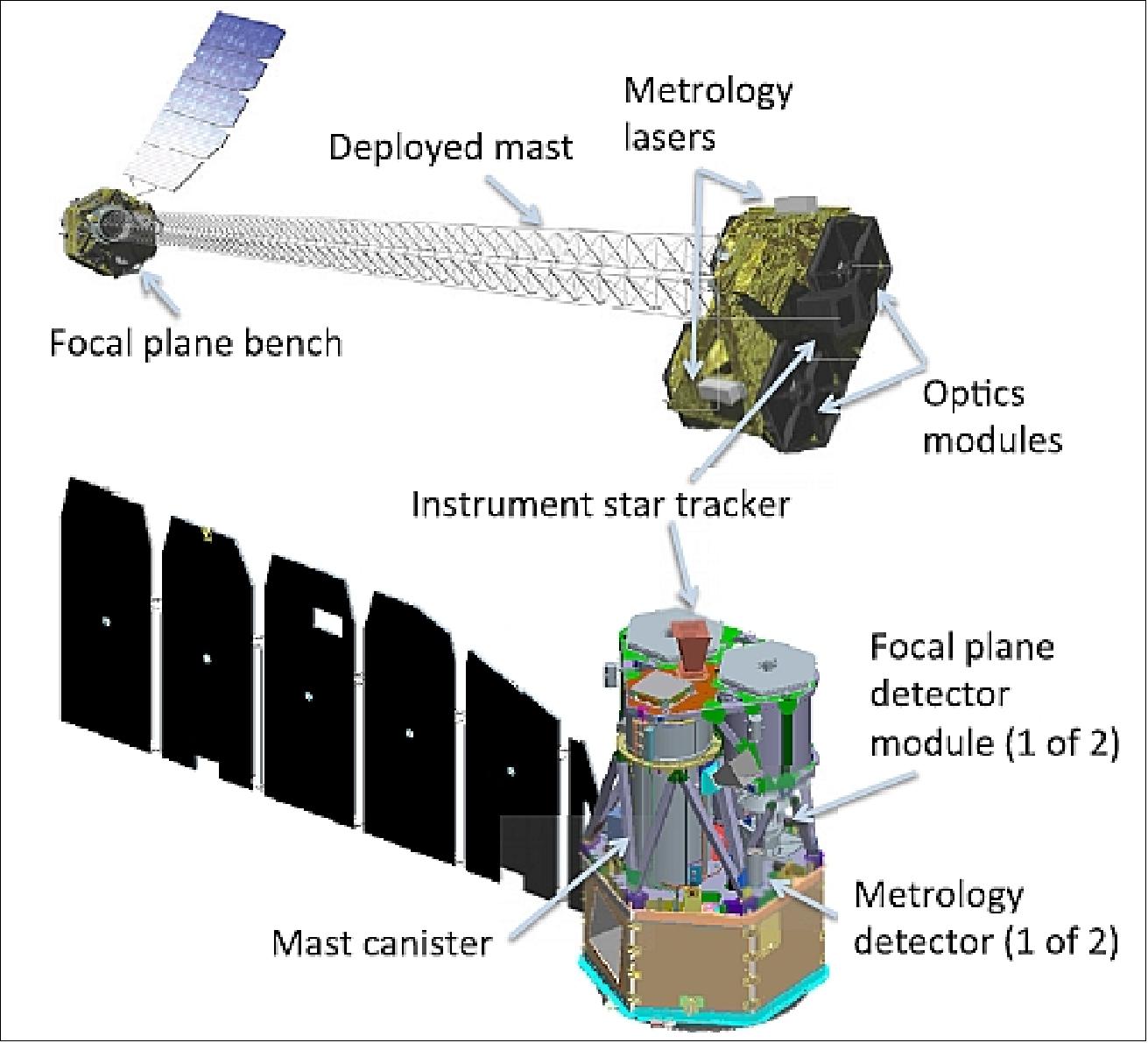
NuSTAR Metrology System
The NuSTAR X-ray telescope consists of two co-aligned grazing angle incidence x-ray mirrors, coated with depth-graded multilayers, focusing onto two cadmium-zinc-telluride pixel detectors that are separated from the mirrors by 10 m. The two telescopes are operated independently and the sensitivity of the mission is achieved by combining exposures from the two telescopes. The long focal length required by the hard X-ray optics demands the use of a 10 m extendable mast, manufactured by ATK Space Systems, Goleta, CA. 9)
The observatory must determine the origin (in celestial coordinates) of all detected X-ray photons during post processing, in order to produce sharp images. This task is complicated by distortions due to thermal bending and external forces acting on the mast during orbit.
To track the motion of this mast, the observatory carries two metrology laser subsystems, which are mounted on the bench with the X-ray optics. The metrology lasers are focused on two metrology detectors mounted on the bench with the X-ray detectors. These metrology detectors are based on PSD (Position Sensitive Detectors). To generate a unique aspect solution, the observatory also carries a star tracker camera on the optics (outboard) bench.
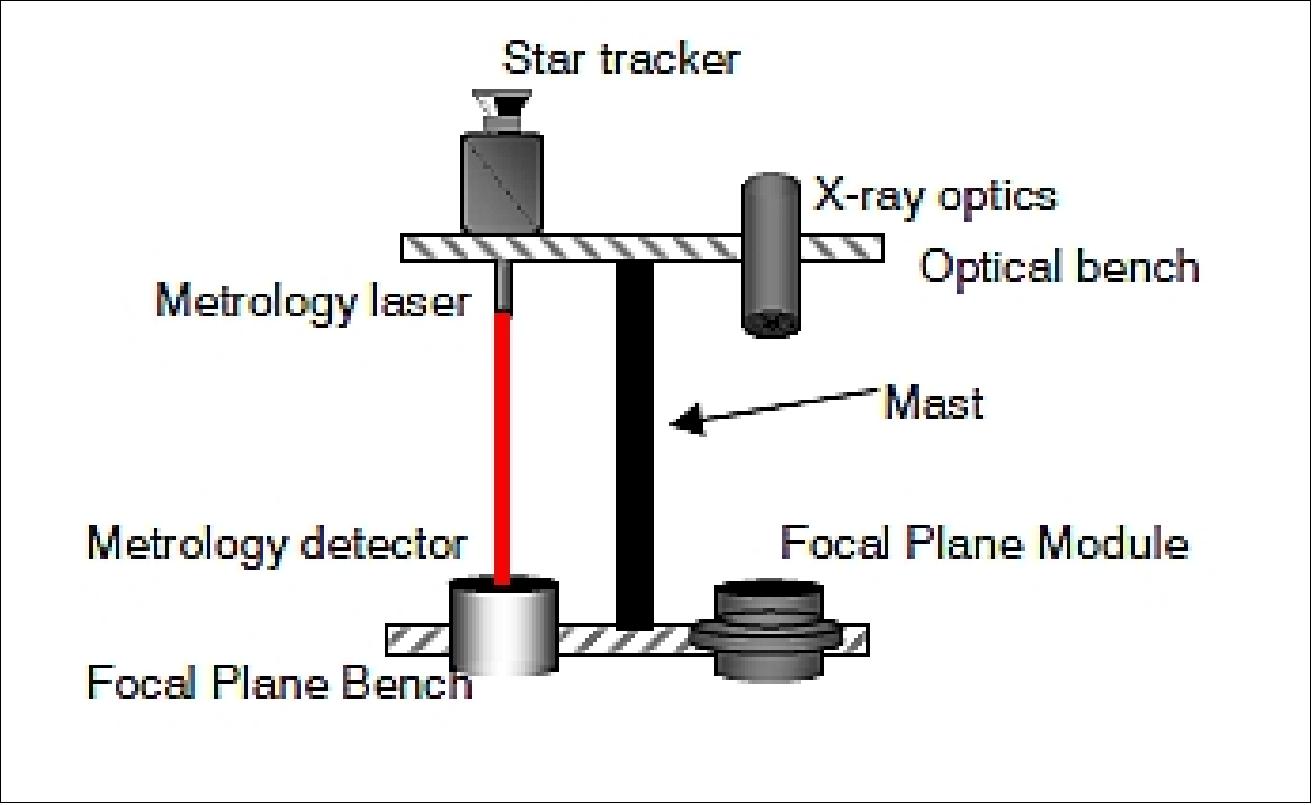
After spacecraft commissioning, a one-time in-flight calibration of the observatory is performed to establish the launch shifts and the deployed position of the mast. This is done by observing a bright X-ray source (with known celestial coordinates), and simultaneously logging the star tracker data, the laser metrology data and the X-ray detector data. A sketch of the metrology system diagrammed with the mast and a single telescope is shown in Figure 3.
During spacecraft operations, the positions of the laser beams on the PSD detectors are continually recorded at a frequency much higher than the mast oscillations. Also, all star tracker updates are recorded and the positions (and times) on the focal plane where the individual x-ray photons impinge are recorded. All this information is used to generate high-resolution images during on-ground post processing of the data.
The X-ray detectors detect single incoming X-ray photons. That is, the X-ray detectors are not integrating. The described metrology system would not work with an integrating detector (such as a CCD chip) that does not register the arrival time of the individual photons, since the unique aspect solution of the observatory at a certain instant could not be applied to a given detector read-out.
The metrology system is required to measure the translation in 2 axes (those directions transverse to the laser beams) and the clocking angle (rotation around the observatory boresight). Only these 3 DOFs (Degree of Freedom) have the potential to introduce errors large enough that they must be measured. Figure 4 illustrates the DOFs that need to be measured. - Regarding the thermal design, it is required that the metrology system survive a non-operating temperature range of -45ºC to 60ºC.
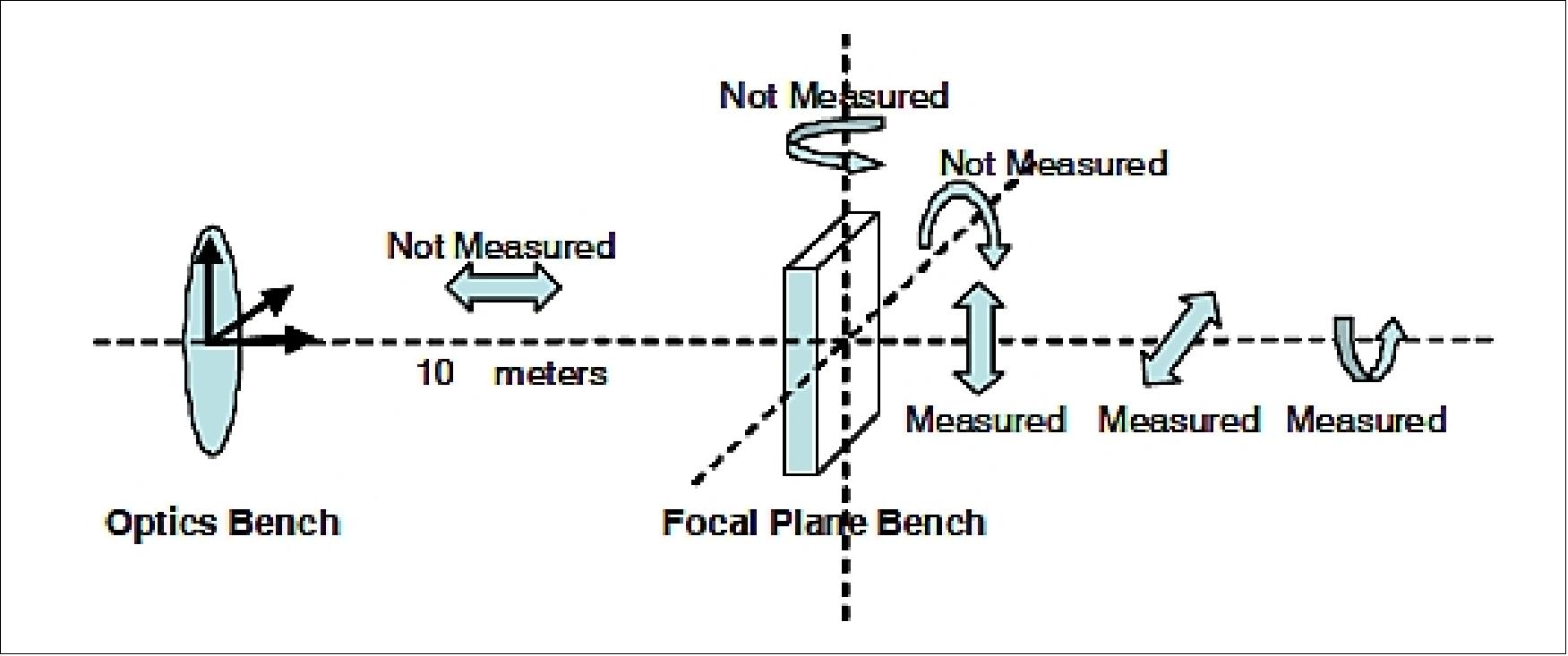
Legend to Figure 4: The sketch is utilizing a coordinate system that is fixed on the optical bench (where the star tracker is mounted).
The science requirement for the NuSTAR observatory that governs the metrology system performance is that the celestial coordinates of a detected bright X-ray source be determined to an accuracy of ~10 arcseconds.
The laser metrology system is implemented as two laser pointers mounted on a bench with the optics. The laser pointers are illuminating 2 PSD detectors mounted ~10 m away on a bench with the X-ray detectors. 10)
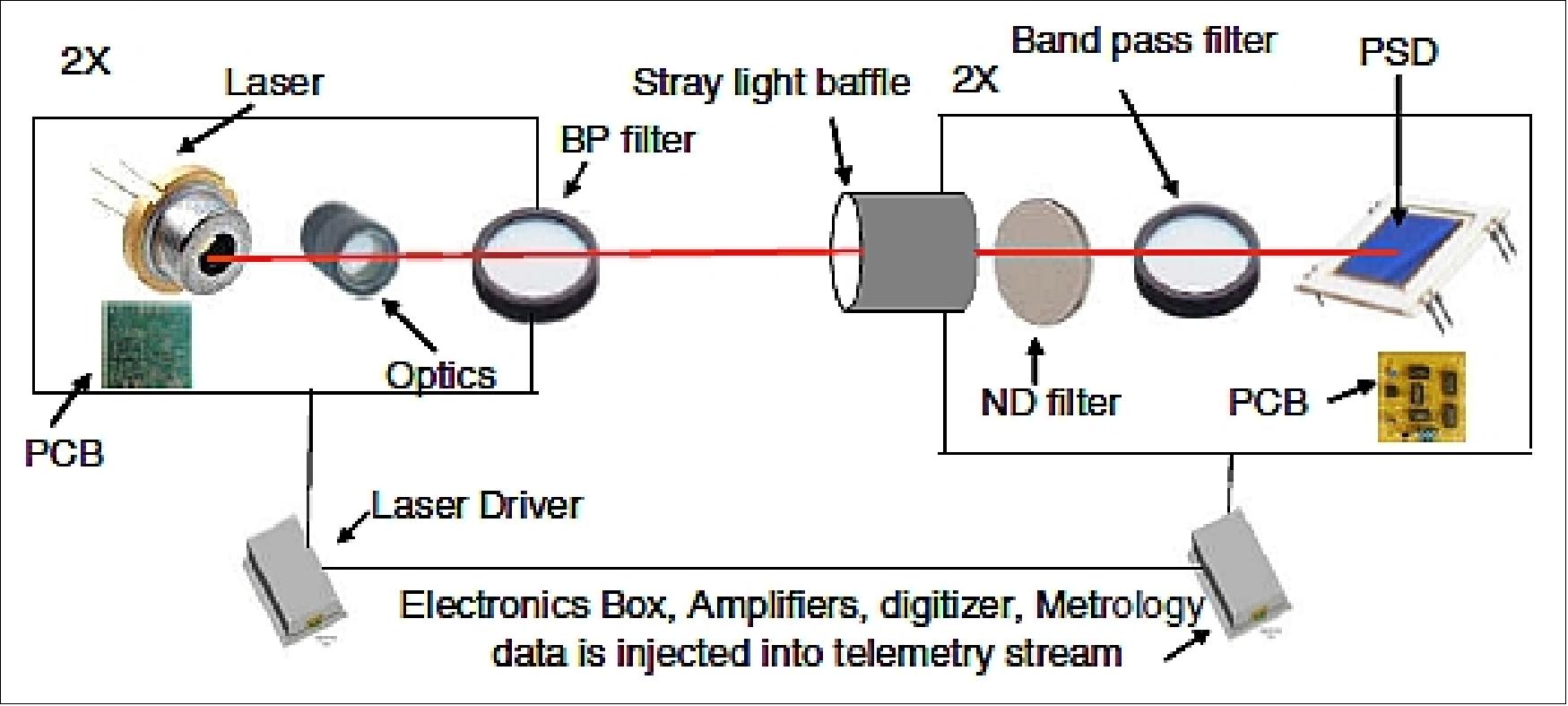
A block diagram of the electronics is shown in Figure 6. The lasers are driven by a processor, through analog laser drivers. The PSD detector is mounted on a PCB (Printed Circuit Board) along with 4 operational amplifiers. The 4 signals for each channel are routed to the main instrument processor where the signal is low pass filtered and multiplexed into a 14 bit A/D converter. The electronics components are space qualified. The electronics power cycle the lasers and make a background measurement 4 times a second to subtract out the background signal produced by dark current, the moon or the Earth in the FOV, sun stray light.
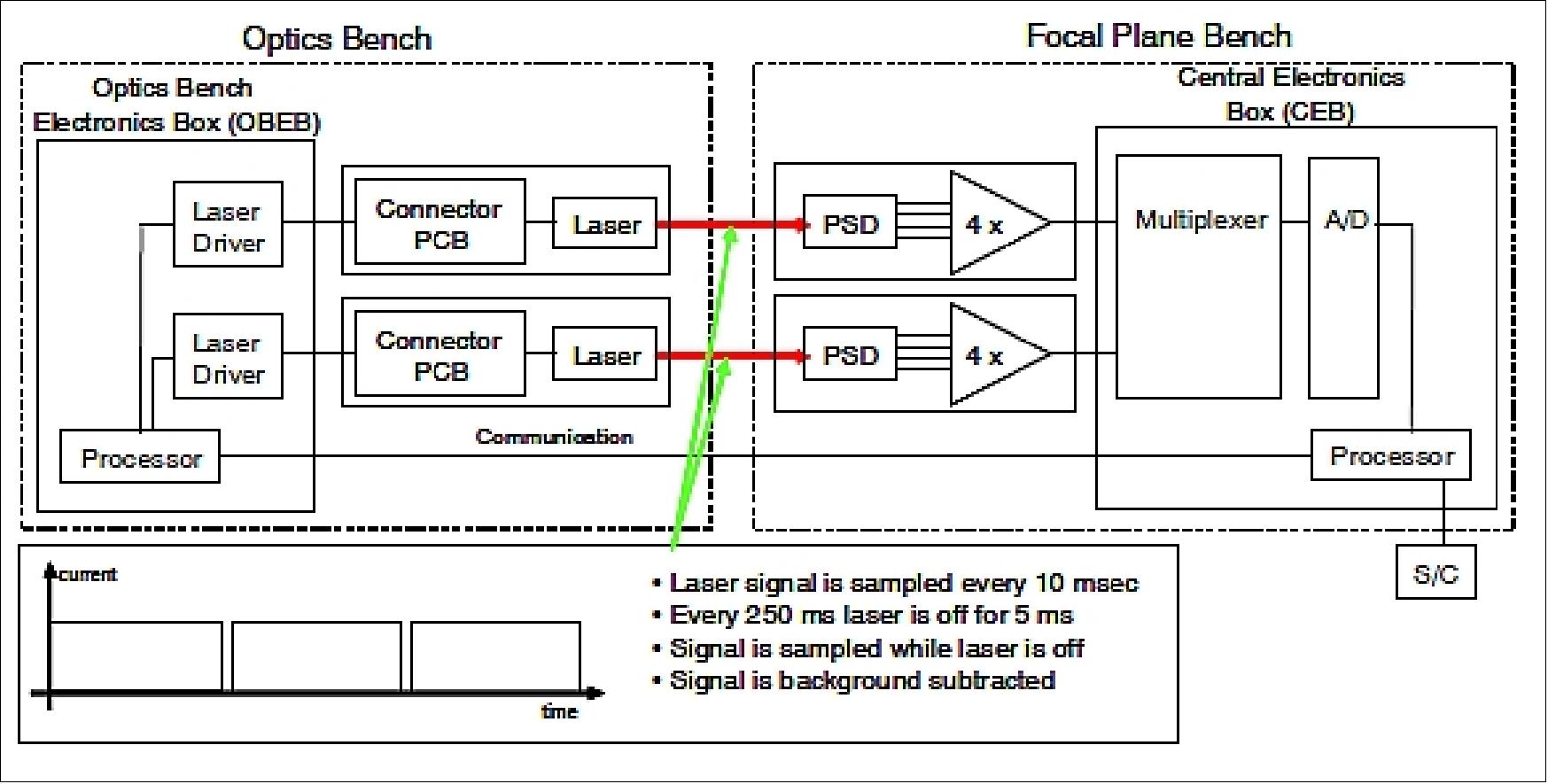
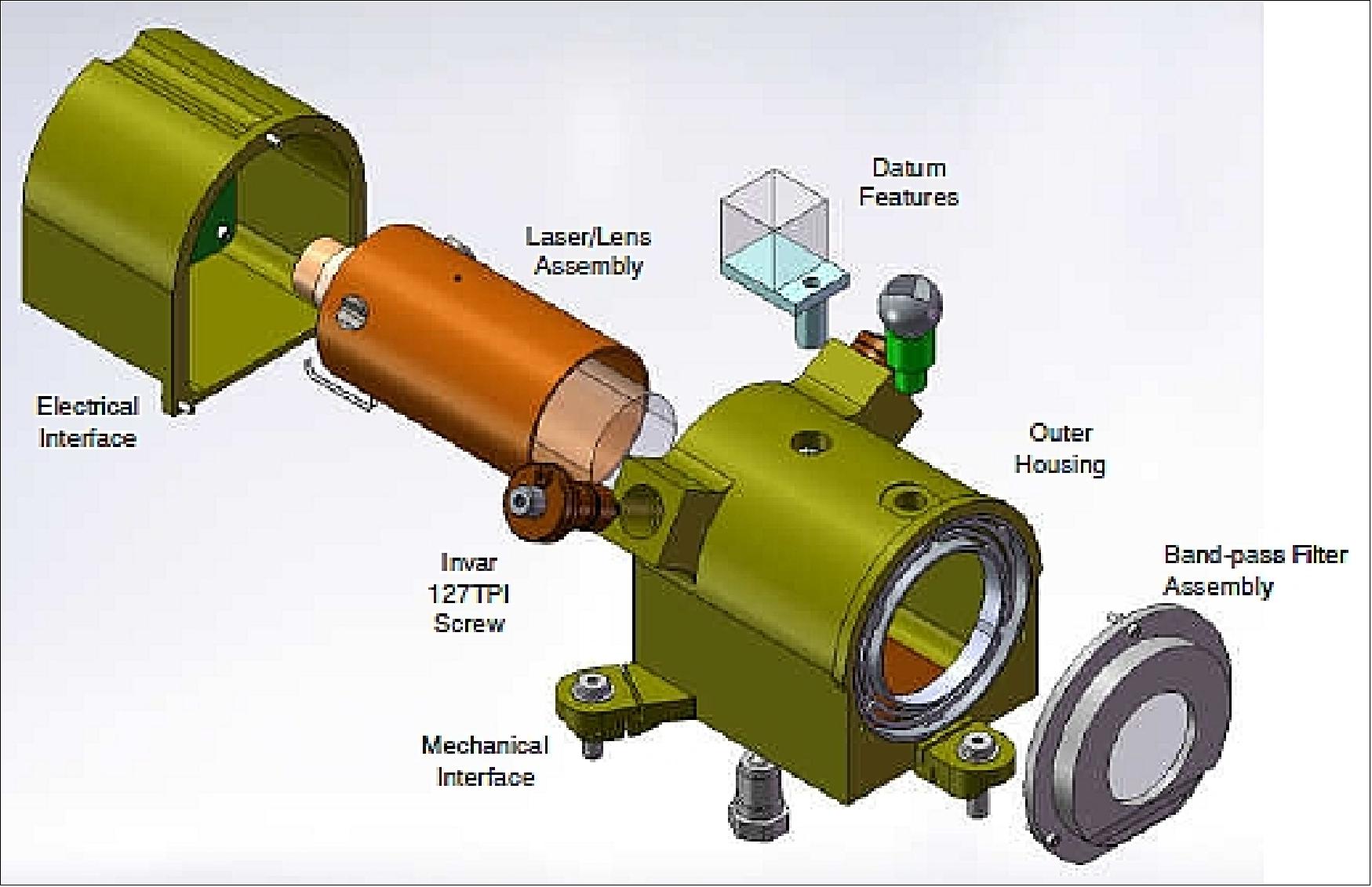
The requirements on the metrology laser call for a beam accuracy of ≤ 130 µm (at ~10 m) over all observatory orientations and orbits following the initial onetime calibration (this implies: "under all sun illumination circumstances"). Thermal stability is the key to achieving this requirement. To minimize the effect of the sun, the structure is primarily made of Invar 36, which has a low CTE (Coefficient of Thermal Expansion). The laser is mounted behind the optics in an invar barrel. This barrel is placed inside another invar barrel to mechanically hold it, to serve as a thermal shield, and to spread the thermal variation from the sun.
Mass (laser – detector pair) | ~ 1.5 kg |
Sun exclusion angle | < 15º |
Detector centroiding error | ~ 50 µm |
Detector translation | ~ 25 µm |
Positioning stability | ~ 80 µm |
Update rate | 100 Hz |
Operating range | ~ 6 mm |
The NuSTAR metrology system has space qualified two different laser diodes for its environment. Both brands of lasers have demonstrated their capability to be utilized as flight lasers for NuSTAR. It is expected that if one laser diode fails but the other laser diode survives the mission, it will be possible to recover scientific data. Therefore, since, 1) the laser are interchangeable, 2) since no laser diode illustrates any signs of superiority over the other and 3) it is more likely that one laser will survive if 2 different equally reliable lasers are chosen, a project decision was made to fly one laser diode from each vendor on the NuSTAR metrology system (Ref. 10).
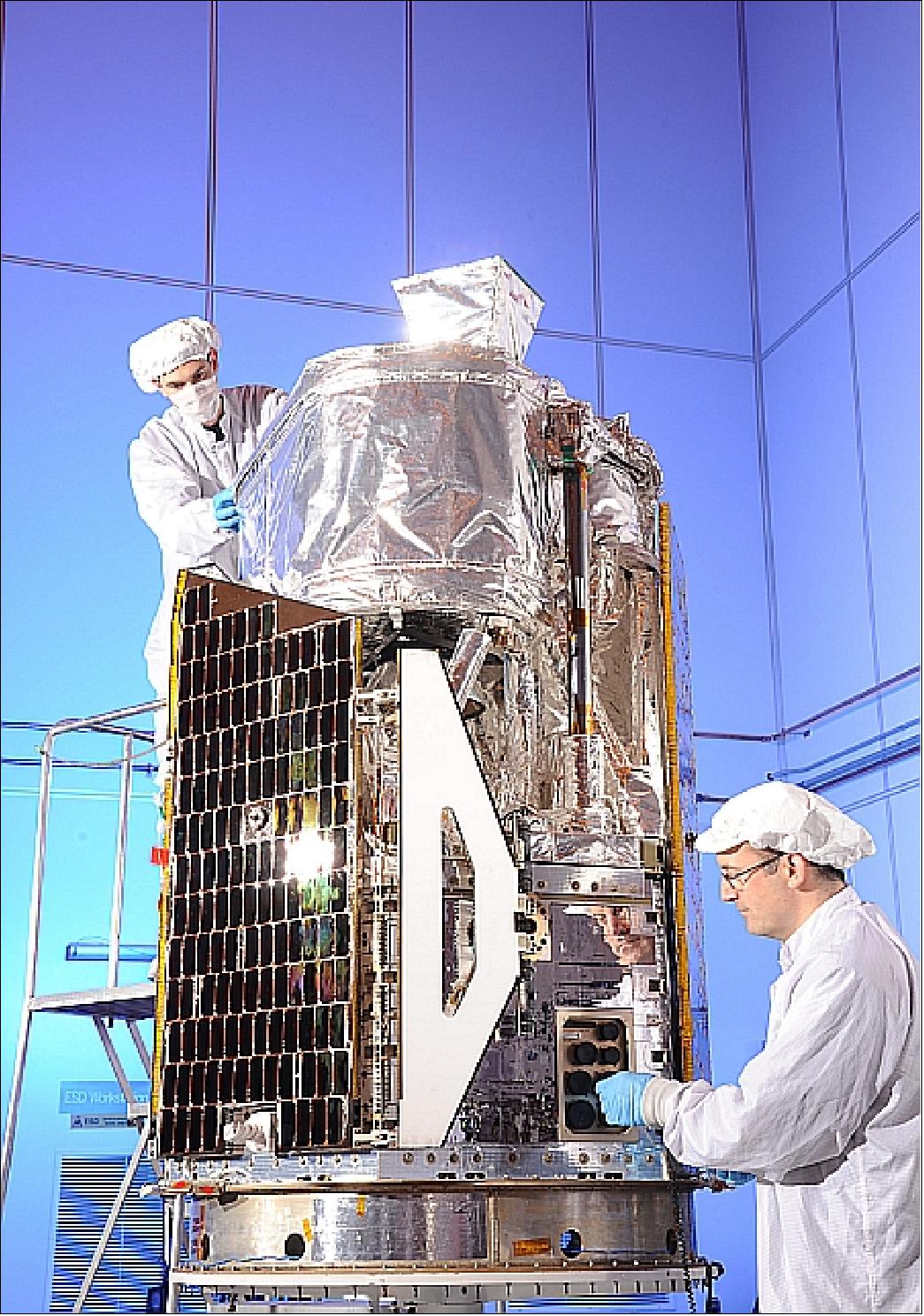
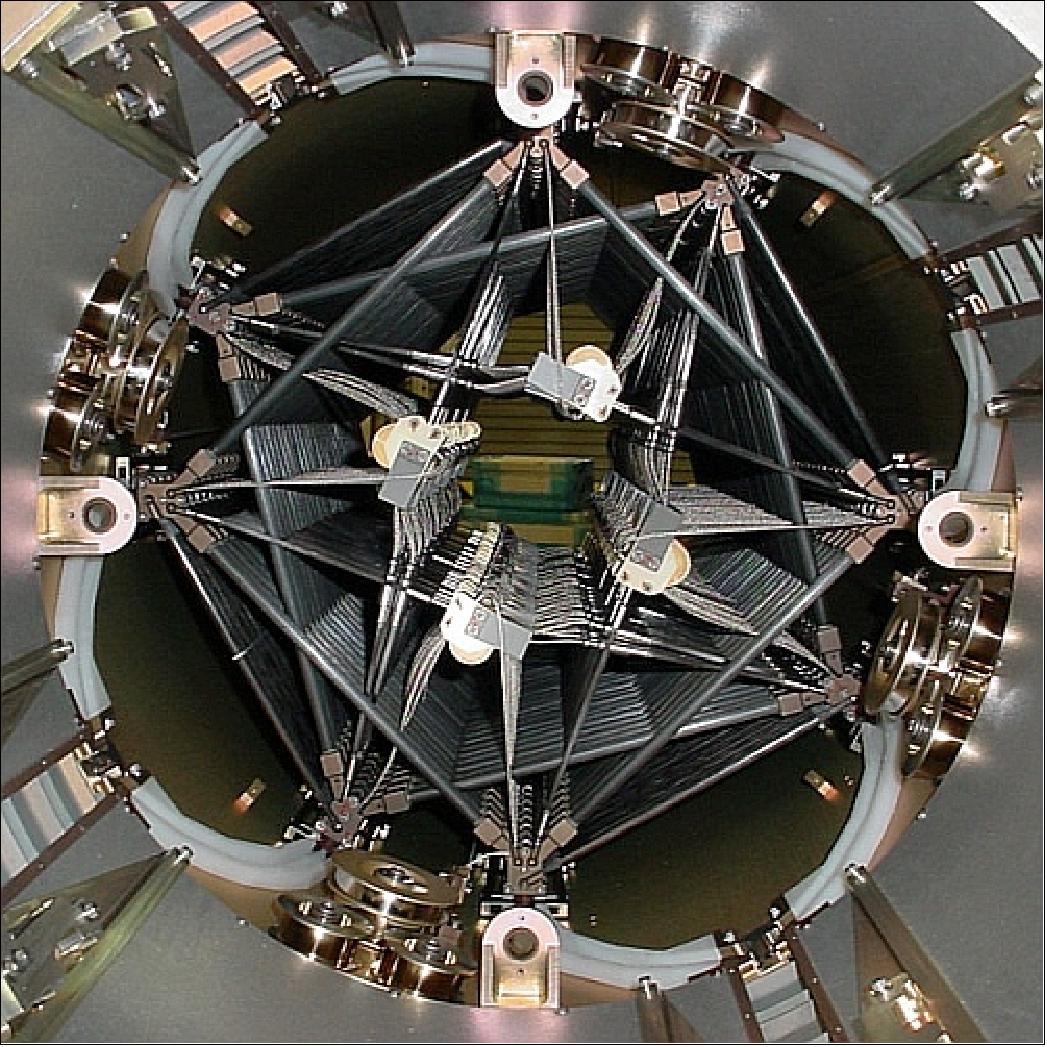
Launch
The NuSTAR spacecraft was launched on June 13, 2012 on a Pegasus-XL vehicle of OSC (air-launch on the Stargazer L-1011 aircraft). The launch site was the Kwajalein Atoll in the Marshall Islands (Pacific Ocean). 11)
The June launch came almost three months after a planned early March launch date. 12)

Orbit: Near equatorial circular orbit, altitude ~650 km x 610 km, inclination = 6º.
Mission Status
• June 9, 2022: After a decade of observing some of the hottest, densest, and most energetic regions in our universe, this small but powerful space telescope still has more to see (spacecraft, Figure 14). 13)
- NASA's Nuclear Spectroscopic Telescope Array (NuSTAR) is turning 10. Launched on June 13, 2012, this space telescope detects high-energy X-ray light and studies some of the most energetic objects and processes in the universe, from black holes devouring hot gas to the radioactive remains of exploded stars. Here are some of the ways NuSTAR has opened our eyes to the X-ray universe over the last decade.
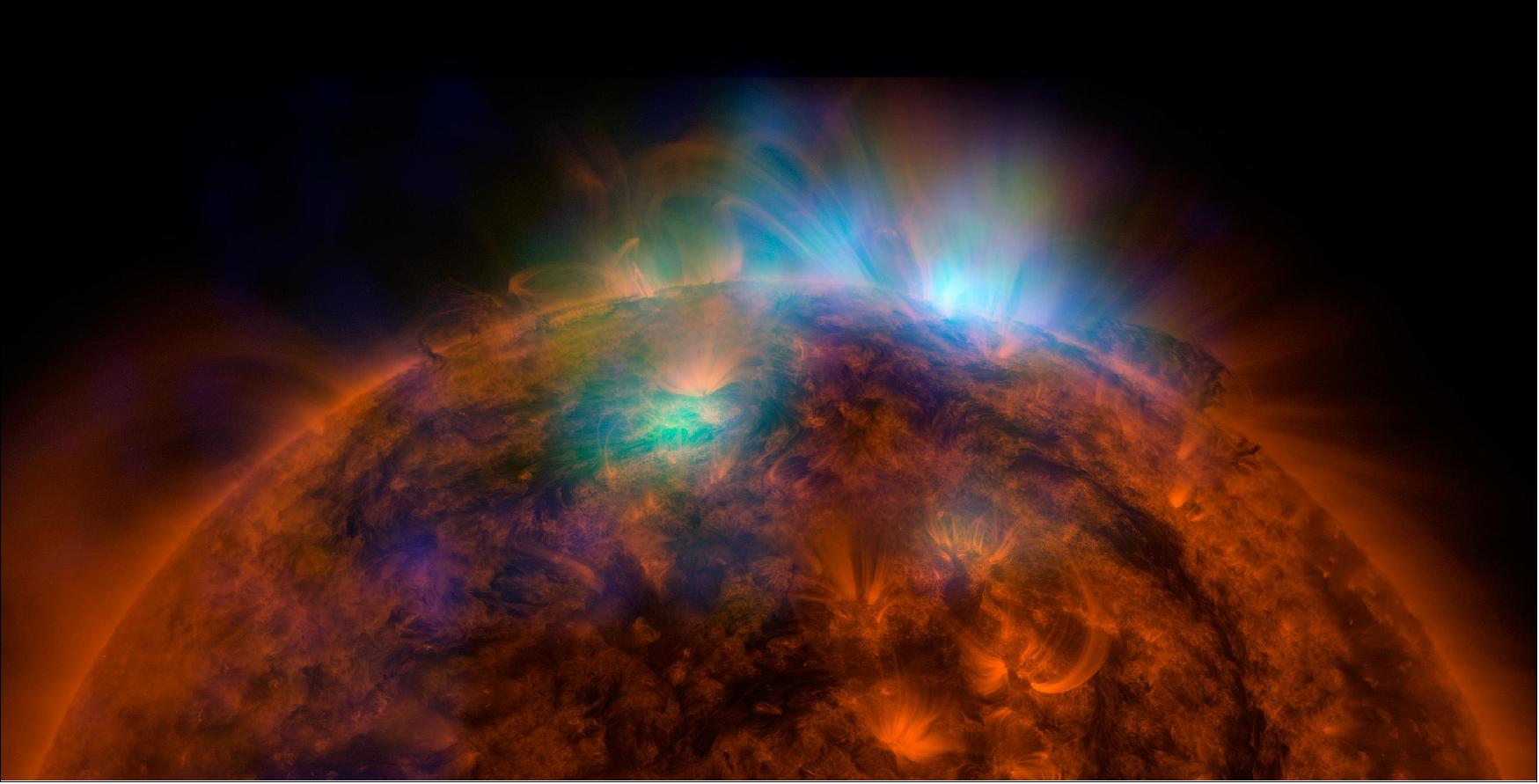
Seeing X-Rays Close to Home
- Different colors of visible light have different wavelengths and different energies; similarly, there is a range of X-ray light, or light waves with higher energies than those human eyes can detect. NuSTAR detects X-rays at the higher end of the range. There aren't many objects in our solar system that emit the X-rays NuSTAR can detect, but the Sun does: Its high-energy X-rays come from microflares, or small bursts of particles and light on its surface. NuSTAR's observations contribute to insights about the formation of bigger flares, which can cause harm to astronauts and satellites. These studies could also help scientists explain why the Sun's outer region, the corona, is many times hotter than its surface. NuSTAR also recently observed high-energy X-rays coming from Jupiter, solving a decades-old mystery about why they've gone undetected in the past.
Illuminating Black Holes
- Black holes don't emit light, but some of the biggest ones we know of are surrounded by disks of hot gas that glow in many different wavelengths of light. NuSTAR can show scientists what's happening to the material closest to the black hole, revealing how black holes produce bright flares and jets of hot gas that stretch for thousands of light-years into space. The mission has measured temperature variations in black hole winds that influence star formation in the rest of the galaxy. Recently, the Event Horizon Telescope (EHT) took the first-ever direct images of the shadows of black holes, and NuSTAR provided support. Along with other NASA telescopes, NuSTAR monitored the black holes for flares and changes in brightness that would influence EHT's ability to image the shadow cast by them.
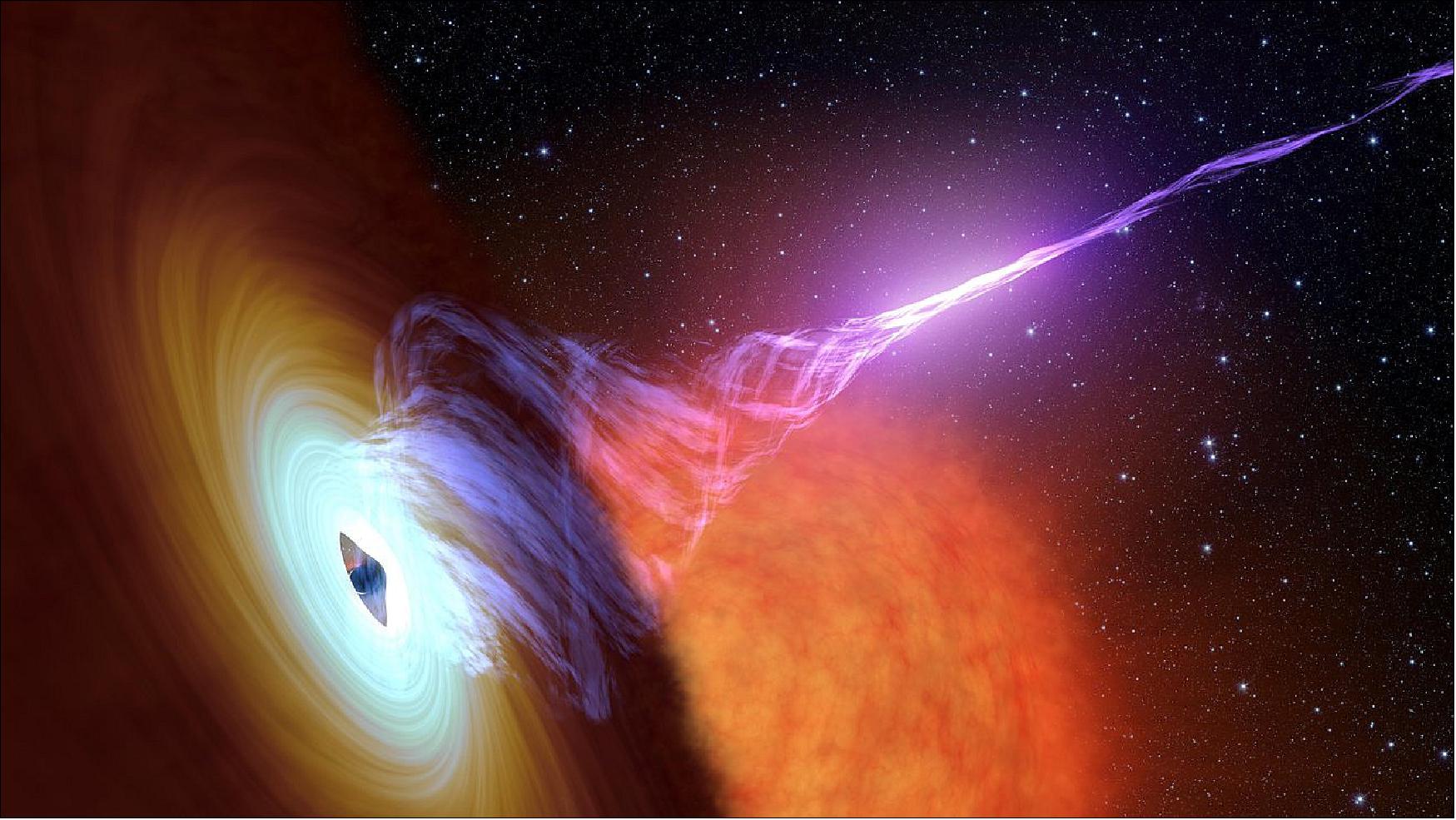
- One of NuSTAR's biggest accomplishments in this arena was making the first unambiguous measurement of a black hole's spin, which it did in collaboration with the ESA (European Space Agency) XMM-Newton mission. Spin is the degree to which a black hole's intense gravity warps the space around it, and the measurement helped confirm aspects of Albert Einstein's theory of general relativity.
Finding Hidden Black Holes
- NuSTAR has identified dozens of black holes hidden behind thick clouds of gas and dust. Visible light typically can't penetrate those clouds, but the high-energy X-ray light observed by NuSTAR can. This gives scientists a better estimate of the total number of black holes in the universe. In recent years scientists have used NuSTAR data to find out how these giants become surrounded by such thick clouds, how that process influences their development, and how obscuration relates to a black hole's impact on the surrounding galaxy.
Revealing the Power of ‘Undead' Stars
- NuSTAR is a kind of zombie hunter: It's deft at finding the undead corpses of stars. Known as neutron stars, these are dense nuggets of material left over after a massive star runs out of fuel and collapses. Though neutron stars are typically only the size of a large city, they are so dense that a teaspoon of one would weigh about a billion tons on Earth. Their density, combined with their powerful magnetic fields, makes these objects extremely energetic: One neutron star located in the galaxy M82 beams with the energy of 10 million Suns.
- Without NuSTAR, scientists wouldn't have discovered just how energetic neutron stars can be. When the object in M82 was discovered, researchers thought that only a black hole could generate so much power from such a small area. NuSTAR was able to confirm the object's true identity by detecting pulsations from the star's rotation – and has since shown that many of these ultraluminous X-ray sources, previously thought to be black holes, are in fact neutron stars. Knowing how much energy these can produce has helped scientists better understand their physical properties, which are unlike anything found in our solar system.
Solving Supernova Mysteries
- During their lives, stars are mostly spherical, but NuSTAR observations have shown that when they explode as supernovae, they become an asymmetrical mess. The space telescope solved a major mystery in the study of supernovae by mapping the radioactive material left over by two stellar explosions, tracing the shape of the debris and in both cases revealing significant deviations from a spherical shape. Because of NuSTAR's X-ray vision, astronomers now have clues about what happens in an environment that would be almost impossible to probe directly. The NuSTAR observations suggest that the inner regions of a star are extremely turbulent at the time of detonation.
More About the Mission
NuSTAR launched on June 13, 2012. The mission's principal investigator is Fiona Harrison, chair of the Division of Physics, Mathematics, and Astronomy at Caltech in Pasadena, California. A Small Explorer mission managed by the agency's Jet Propulsion Laboratory in Southern California for NASA's Science Mission Directorate in Washington, NuSTAR was developed in partnership with the Danish Technical University (DTU) and the Italian Space Agency (ASI). The telescope optics were built by Columbia University, NASA's Goddard Space Flight Center in Greenbelt, Maryland, and DTU. The spacecraft was built by Orbital Sciences Corp. in Dulles, Virginia. NuSTAR's mission operations center is at the University of California, Berkeley, and the official data archive is at NASA's High Energy Astrophysics Science Archive Research Center. ASI provides the mission's ground station and a mirror data archive. Caltech manages JPL for NASA.
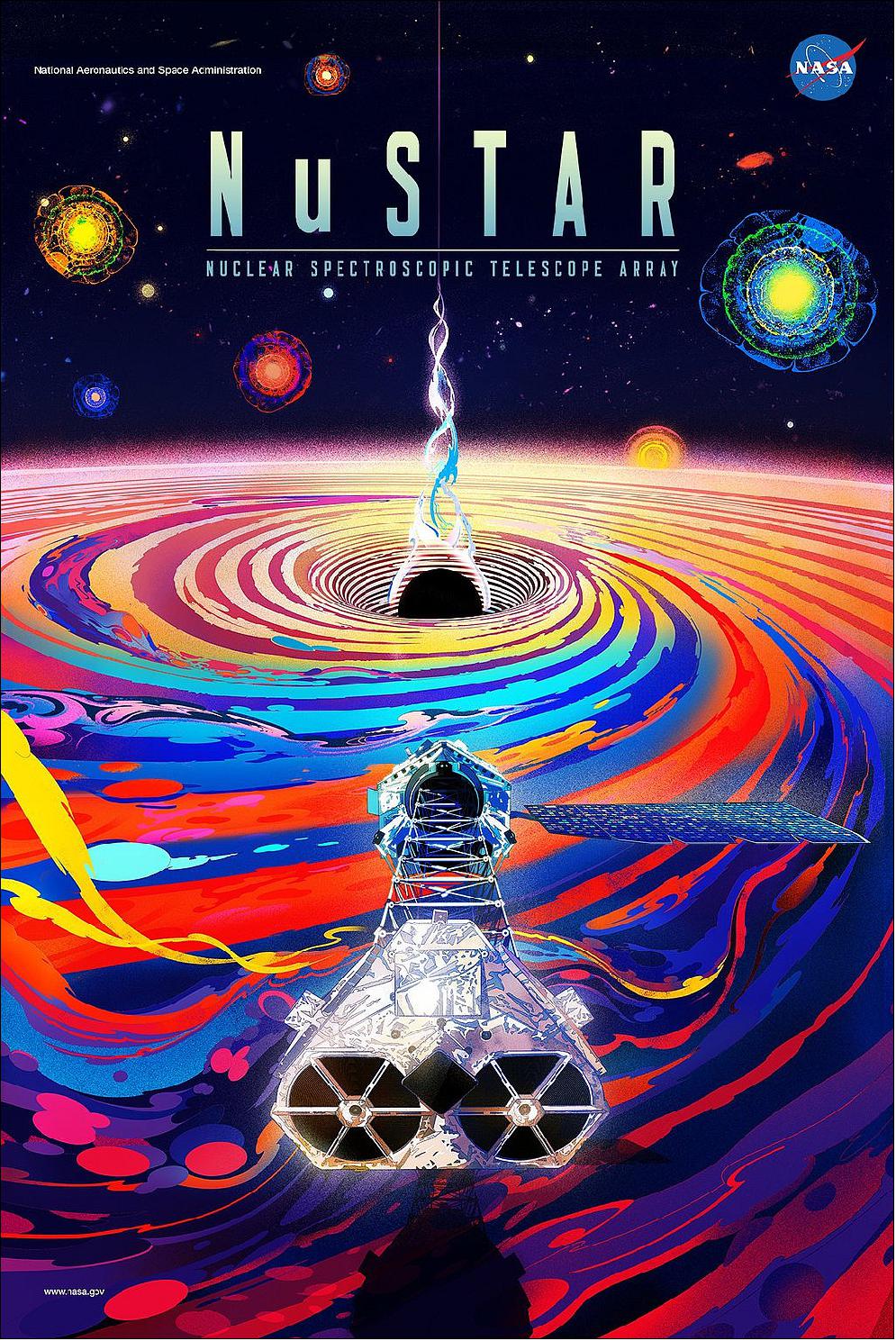
• March 1, 2022: A design quirk in the X-ray observatory has made it possible for astronomers to use previously unwanted light to study even more cosmic objects than before. 14)
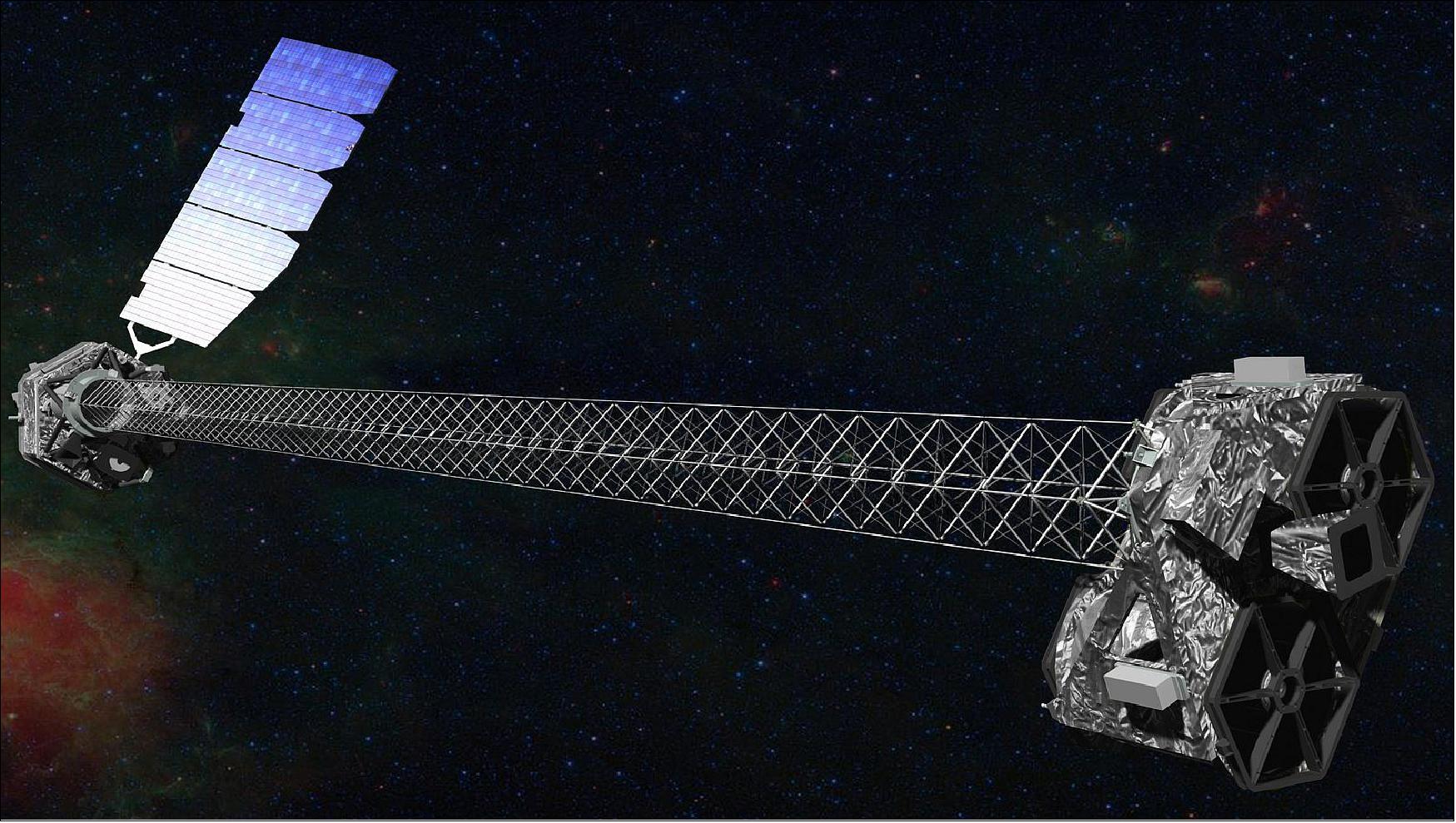
- For almost 10 years, NASA's NuSTAR (Nuclear Spectroscopic Telescope Array) X-ray space observatory has been studying some of the highest-energy objects in the universe, such as colliding dead stars and enormous black holes feasting on hot gas. During that time, scientists have had to deal with stray light leaking in through the sides of the observatory, which can interfere with observations much like external noise can drown out a phone call.
- But now team members have figured out how to use that stray X-ray light to learn about objects in NuSTAR's peripheral vision while also performing normal targeted observations. This development has the potential to multiply the insights that NuSTAR provides. A new science paper in the Astrophysical Journal describes the first use of NuSTAR's stray light observations to learn about a cosmic object – in this case, a neutron star. 15)
- Nuggets of material left over after a star collapses, neutron stars are some of the densest objects in the universe, second only to black holes. Their powerful magnetic fields trap gas particles and funnel them toward the neutron star's surface. As the particles are accelerated and energized, they release high-energy X-rays that NuSTAR can detect.
- The new study describes a system called SMC X-1, which consists of a neutron star orbiting a living star in one of two small galaxies orbiting the Milky Way (Earth's home galaxy). The brightness of SMC X-1's X-ray output appears to vary wildly when viewed by telescopes, but decades of direct observations by NuSTAR and other telescopes have revealed a pattern to the fluctuations. Scientists have pinpointed several reasons why SMC X-1 changes in brightness when studied by X-ray telescopes. For example, the X-rays' brightness dims as the neutron star dips behind the living star with each orbit. According to the paper, the stray light data was sensitive enough to pick up on some of those well-documented changes.
- "I think this paper shows that this stray light approach is reliable, because we observed brightness fluctuations in the neutron star in SMC X-1 that we have already confirmed through direct observations," said McKinley Brumback, an astrophysicist at Caltech in Pasadena, California, and lead author of the new study. "Going forward, it would be great if we could use the stray light data to look at objects when we don't already know if they're regularly changing in brightness and potentially use this approach to detect changes."
Form and Function
- The new approach is possible because of NuSTAR's shape, which is similar to dumbbell or dog bone: It has two bulky components at either end of a narrow, 33-foot-long (10-meter-long) structure called a deployable mast, or boom. Typically, researchers point one of the bulky ends – which contains the optics, or the hardware that collects X-rays – at the object they want to study. The light travels along the boom to the detectors, located at the other end of the spacecraft. The distance between the two is necessary to focus the light.
- But stray light also reaches the detectors by entering through the sides of the boom, bypassing the optics. It appears in NuSTAR's field of view along with light from whatever object the telescope directly observes, and is often fairly easy to identify by eye: It forms a circle of faint light emerging from the sides of the image. (Unsurprisingly, stray light is a problem for many other space- and ground-based telescopes.)
- A group of NuSTAR team members has spent the last few years separating the stray light from various NuSTAR observations. After identifying bright, known X-ray sources in the periphery of each observation, they used computer models to predict how much stray light should appear based on which bright object was nearby. They also looked at almost every NuSTAR observation to confirm the telltale sign of stray light. The team created a catalog of about 80 objects for which NuSTAR had collected stray light observations, naming the collection "StrayCats."
- "Imagine sitting in a quiet movie theater, watching a drama, and hearing the explosions in the action movie playing next door," said Brian Grefenstette, senior research scientist at Caltech and the NuSTAR team member leading the StrayCats work. "In the past, that's what the stray light was like – a distraction from what we were trying to focus on. Now we have the tools to turn that extra noise into useful data, opening an entire new way of using NuSTAR to study the universe."
- Of course, the stray light data can't replace direct observations by NuSTAR. Aside from stray light being unfocused, many objects that NuSTAR can observe directly are too faint to appear in the stray light catalog. But Grefenstette said multiple Caltech students have combed through the data and found instances of rapid brightening from peripheral objects, which might be any number of dramatic events, such as thermonuclear explosions on the surfaces of neutron stars. Observing the frequency and intensity of a neutron star's changes in brightness can help scientists decipher what's happening to those objects.
- "If you're trying to look for a pattern in the long-term behavior or brightness of an X-ray source, the stray light observations could be a great way to check in more often and establish a baseline," said Renee Ludlam, a NASA Hubble Fellowship Program Einstein fellow at Caltech and member of the StrayCats team. "They could also let us catch odd behaviors in these objects when we don't expect them or when we wouldn't normally be able to point NuSTAR directly at them. The stray light observations don't replace direct observations, but more data is always good."
More About the Mission
- NuSTAR launched on June 13, 2012. A Small Explorer mission led by Caltech and managed by JPL for NASA's Science Mission Directorate in Washington, it was developed in partnership with the Danish Technical University (DTU) and the Italian Space Agency (ASI). The telescope optics were built by Columbia University, NASA's Goddard Space Flight Center in Greenbelt, Maryland, and DTU. The spacecraft was built by Orbital Sciences Corp. in Dulles, Virginia. NuSTAR's mission operations center is at the University of California, Berkeley, and the official data archive is at NASA's High Energy Astrophysics Science Archive Research Center. ASI provides the mission's ground station and a mirror data archive. Caltech manages JPL for NASA.
• February 10, 2022: The planet's auroras are known to produce low-energy X-ray light. A new study finally reveals higher-frequency X-rays and explains why they eluded another mission 30 years ago. 16)
- Scientists have been studying Jupiter up close since the 1970s, but the gas giant is still full of mysteries. New observations by NASA's NuSTAR space observatory have revealed the highest-energy light ever detected from Jupiter. The light, in the form of X-rays that NuSTAR can detect, is also the highest-energy light ever detected from a solar system planet other than Earth. A paper in the journal Nature Astronomy reports the finding and solves a decades-old mystery: Why the Ulysses mission saw no X-rays when it flew past Jupiter in 1992. 17)
- X-rays are a form of light, but with much higher energies and shorter wavelengths than the visible light human eyes can see. NASA's Chandra X-ray Observatory and the ESA (European Space Agency) XMM-Newton observatory have both studied low-energy X-rays from Jupiter's auroras – light shows near the planet's north and south poles that are produced when volcanoes on Jupiter's moon Io shower the planet with ions (atoms stripped of their electrons). Jupiter's powerful magnetic field accelerates these particles and funnels them toward the planet's poles, where they collide with its atmosphere and release energy in the form of light.
- Electrons from Io are also accelerated by the planet's magnetic field, according to observations by NASA's Juno spacecraft, which arrived at Jupiter in 2016. Researchers suspected that those particles should produce even higher-energy X-rays than what Chandra and XMM-Newton observed, and NuSTAR (short for Nuclear Spectroscopic Telescope Array) is the first observatory to confirm that hypothesis.
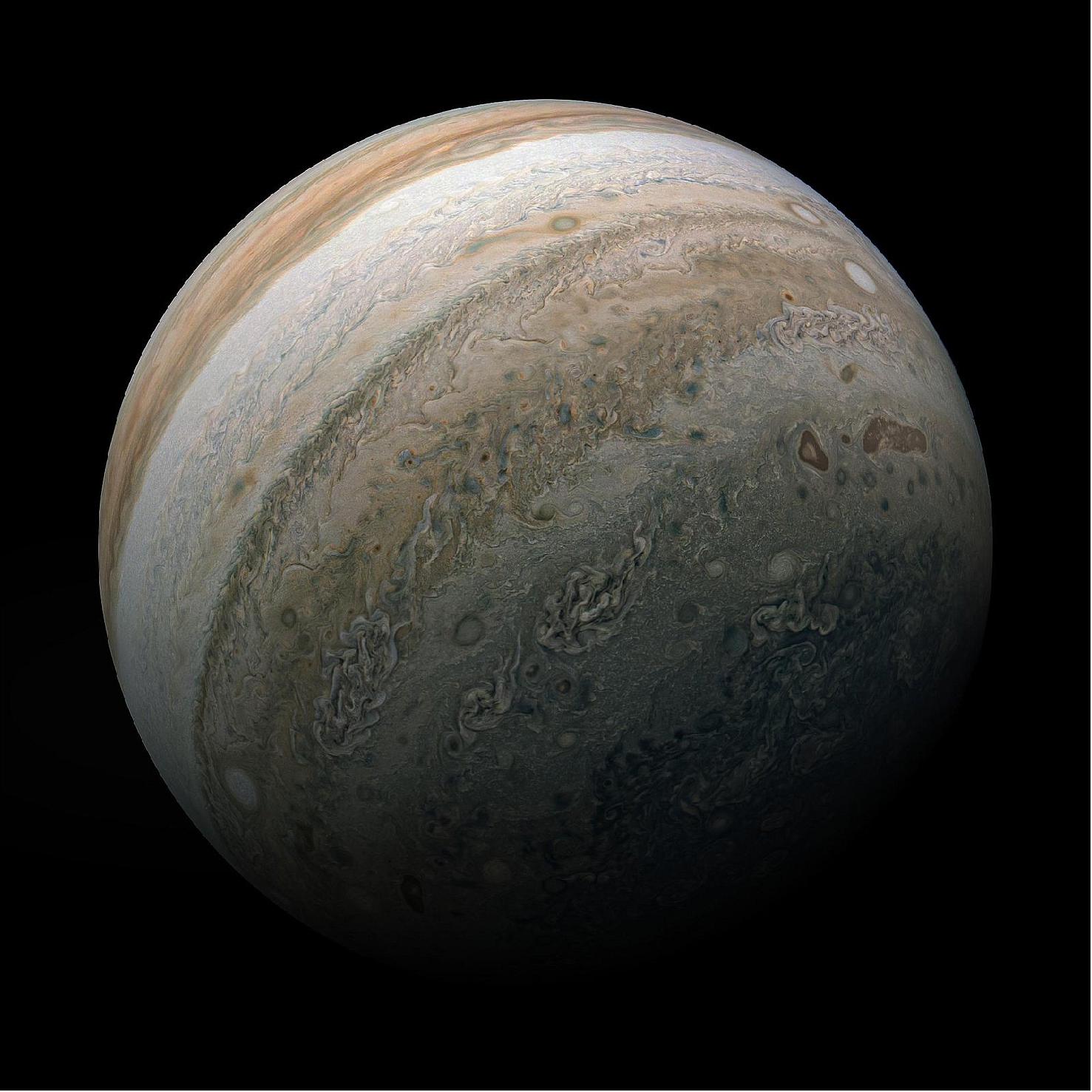
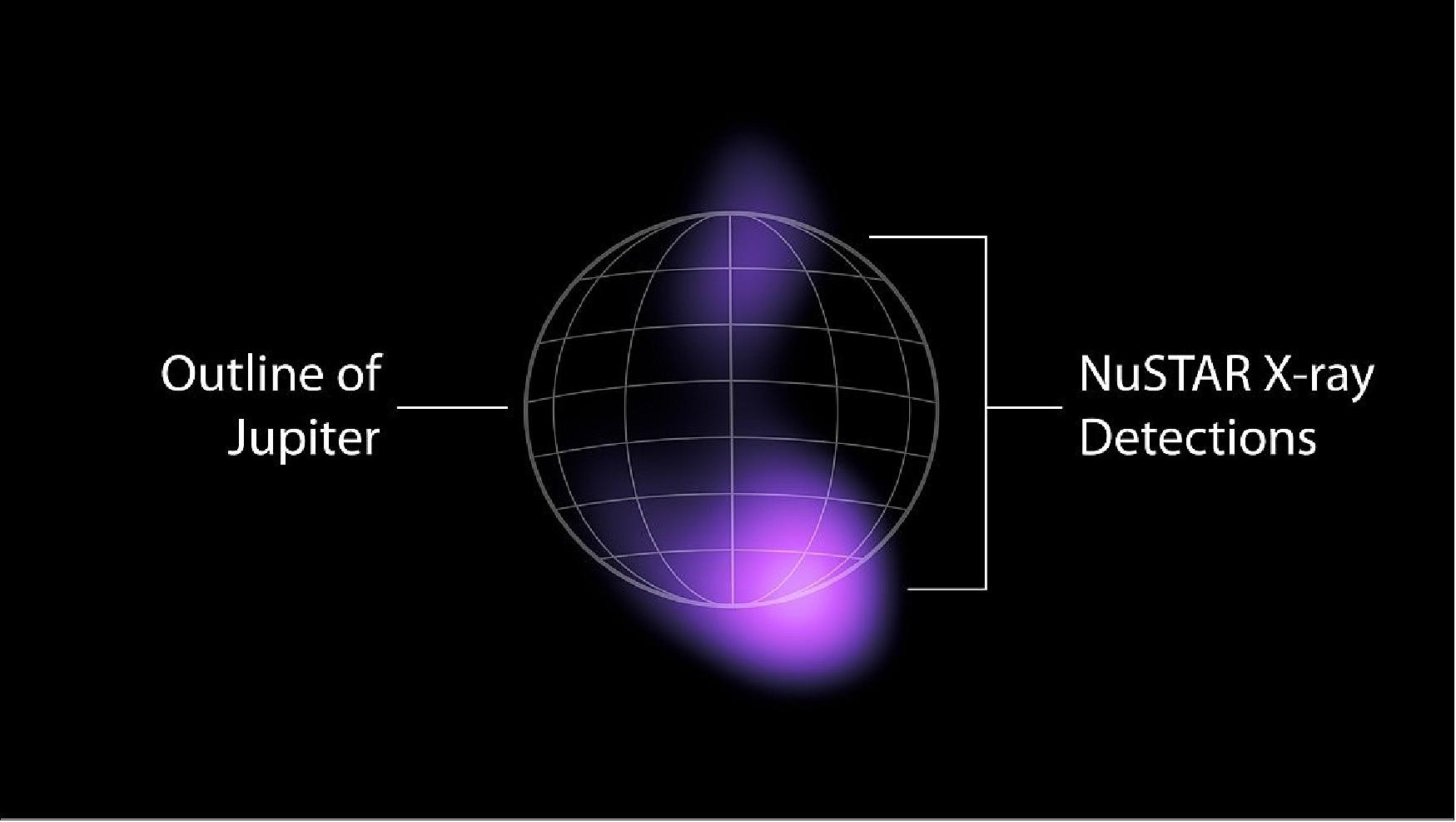
- "It's quite challenging for planets to generate X-rays in the range that NuSTAR detects," said Kaya Mori, an astrophysicist at Columbia University and lead author of the new study. "But Jupiter has an enormous magnetic field, and it's spinning very quickly. Those two characteristics mean that the planet's magnetosphere acts like a giant particle accelerator, and that's what makes these higher-energy emissions possible."
- Researchers faced multiple hurdles to make the NuSTAR detection: For example, the higher-energy emissions are significantly fainter than the lower-energy ones. But none of the challenges could explain the nondetection by Ulysses, a joint mission between NASA and ESA that was capable of sensing higher-energy X-rays than NuSTAR. The Ulysses spacecraft launched in 1990 and, after multiple mission extensions, operated until 2009.
- The solution to that puzzle, according to the new study, lies in the mechanism that produces the high-energy X-rays. The light comes from the energetic electrons that Juno can detect with its Jovian Auroral Distributions Experiment (JADE) and Jupiter Energetic-particle Detector Instrument (JEDI), but there are multiple mechanisms that can cause particles to produce light. Without a direct observation of the light that the particles emit, it's almost impossible to know which mechanism is responsible.
- In this case, the culprit is something called bremsstrahlung emission. When the fast-moving electrons encounter charged atoms in Jupiter's atmosphere, they are attracted to the atoms like magnets. This causes the electrons to rapidly decelerate and lose energy in the form of high-energy X-rays. It's like how a fast-moving car would transfer energy to its braking system to slow down; in fact, bremsstrahlung means "braking radiation" in German. (The ions that produce the lower-energy X-rays emit light through a process called atomic line emission.)
- Each light-emission mechanism produces a slightly different light profile. Using established studies of bremsstrahlung light profiles, the researchers showed that the X-rays should get significantly fainter at higher energies, including in Ulysses' detection range.
- "If you did a simple extrapolation of the NuSTAR data, it would show you that Ulysses should have been able to detect X-rays at Jupiter," said Shifra Mandel, a Ph.D. student in astrophysics at Columbia University and a co-author of the new study. "But we built a model that includes bremsstrahlung emission, and that model not only matches the NuSTAR observations, it shows us that at even higher energies, the X-rays would have been too faint for Ulysses to detect."
- The conclusions of the paper relied on simultaneous observations of Jupiter by NuSTAR, Juno, and XMM-Newton.
New Chapters
- On Earth, scientists have detected X-rays in Earth's auroras with even higher energies than what NuSTAR saw at Jupiter. But those emissions are extremely faint – much fainter than Jupiter's – and can only be spotted by small satellites or high-altitude balloons that get extremely close to the locations in the atmosphere that generate those X-rays. Similarly, observing these emissions in Jupiter's atmosphere would require an X-ray instrument close to the planet with greater sensitivity than those carried by Ulysses in the 1990s.
- "The discovery of these emissions does not close the case; it's opening a new chapter," said William Dunn, a researcher at the University College London and a co-author of the paper. "We still have so many questions about these emissions and their sources. We know that rotating magnetic fields can accelerate particles, but we don't fully understand how they reach such high speeds at Jupiter. What fundamental processes naturally produce such energetic particles?"
- Scientists also hope that studying Jupiter's X-ray emissions can help them understand even more extreme objects in our universe. NuSTAR typically studies objects outside our solar system, such as exploding stars and disks of hot gas accelerated by the gravity of massive black holes.
- The new study is the first example of scientists being able to compare NuSTAR observations with data taken at the source of the X-rays (by Juno). This enabled researchers to directly test their ideas about what creates these high-energy X-rays. Jupiter also shares a number of physical similarities with other magnetic objects in the universe – magnetars, neutron stars, and white dwarfs – but researchers don't fully understand how particles are accelerated in these objects' magnetospheres and emit high-energy radiation. By studying Jupiter, researchers may unveil details of distant sources we cannot yet visit.
• July 9, 2021: Known as ultraluminous X-ray sources, the emitters are easy to spot when viewed straight on, but they might be hidden from view if they point even slightly away from Earth. 18)
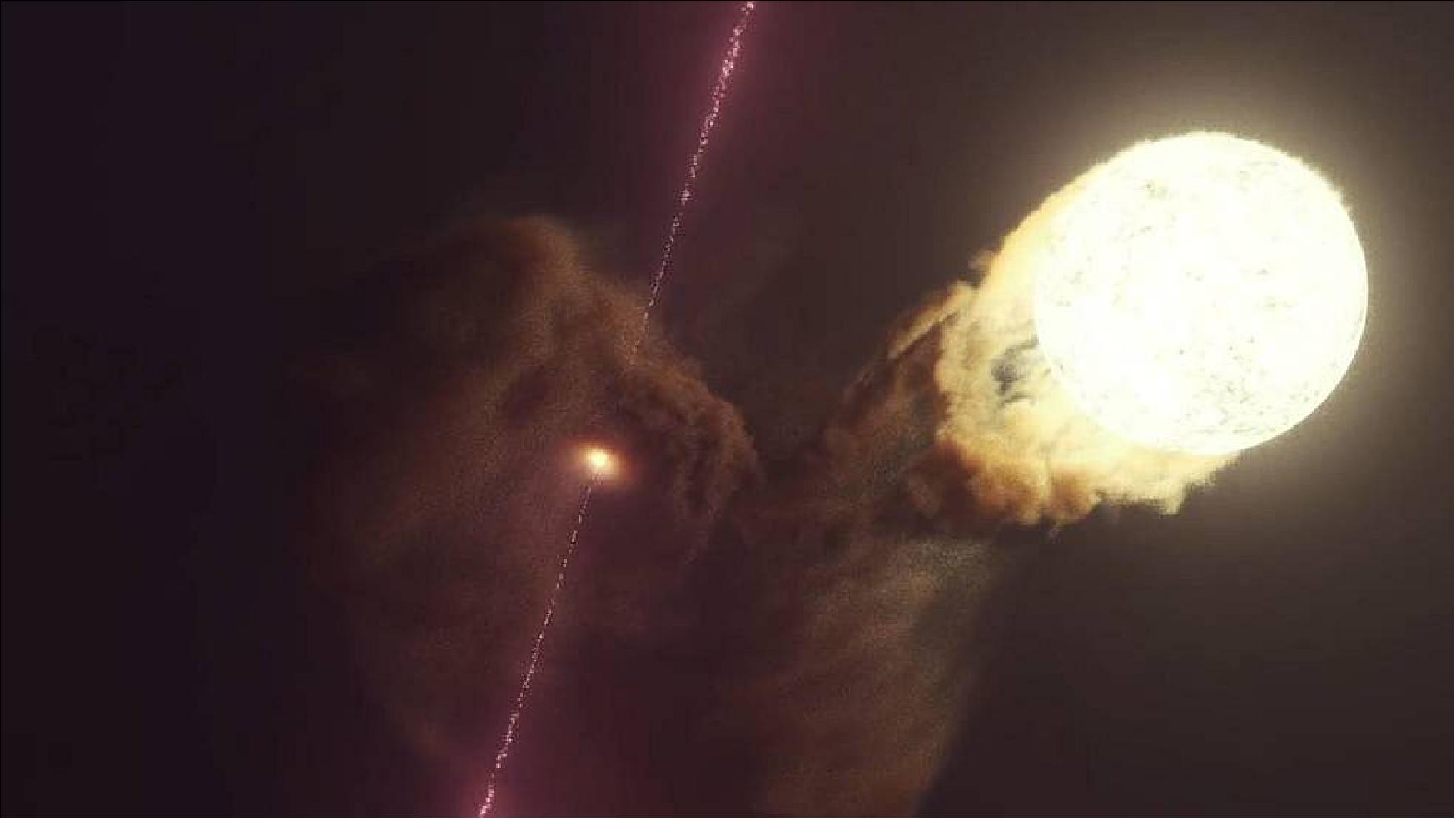
- It's hard to miss a flashlight beam pointed straight at you. But that beam viewed from the side appears significantly dimmer. The same holds true for some cosmic objects: Like a flashlight, they radiate primarily in one direction, and they look dramatically different depending on whether the beam points away from Earth (and nearby space telescopes) or straight at it.
- New data from NASA's NuSTAR space observatory indicates that this phenomenon holds true for some of the most prominent X-ray emitters in the local universe: ultraluminous X-ray sources, or ULXs. Most cosmic objects, including stars, radiate little X-ray light, particularly in the high-energy range seen by NuSTAR. ULXs, by contrast, are like X-ray lighthouses cutting through the darkness. To be considered a ULX, a source must have an X-ray luminosity that is about a million times brighter than the total light output of the Sun (at all wavelengths). ULXs are so bright, they can be seen millions of light-years away, in other galaxies.
- The new study shows that the object known as SS 433, located in the Milky Way galaxy and only about 20,000 light-years from Earth, is a ULX, even though it appears to be about 1,000 times dimmer than the minimum threshold to be considered one.
- This faintness is a trick of perspective, according to the study: The high-energy X-rays from SS 433 are initially confined within two cones of gas extending outward from opposite sides of the central object. These cones are similar to a mirrored bowl that surrounds a flashlight bulb: They corral the X-ray light from SS 433 into a narrow beam, until it escapes and is detected by NuSTAR. But because the cones are not pointing directly at Earth, NuSTAR can't see the object's full brightness.
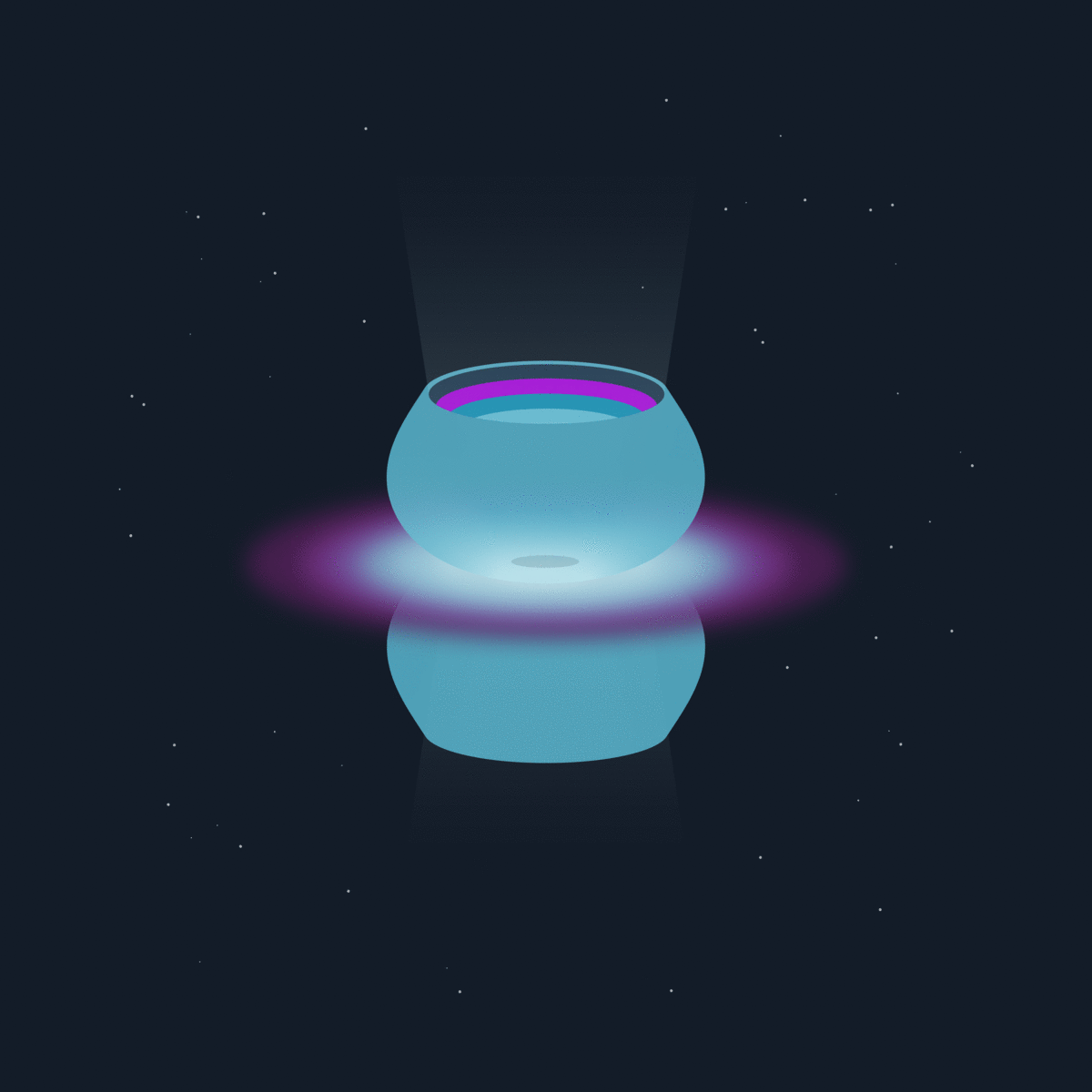
- "We've long suspected that some ULXs emit light in narrow columns, rather than in every direction like a bare lightbulb," said Matt Middleton, a professor of astrophysics at the University of Southampton in the United Kingdom and the study's lead author. "In our study, we confirm this hypothesis by showing that SS 433 would qualify as a ULX to a face-on observer."
- If a ULX relatively close to Earth can hide its true brightness because of how it is oriented, then there are likely more ULXs – particularly in other galaxies – disguised in a similar way. That means the total ULX population should be far larger than scientists currently observe.
Cone of Darkness
- About 500 ULXs have been found in other galaxies, and their distance from Earth means it's often nearly impossible to tell what type of object generates the X-ray emission. The X-rays likely come from a large amount of gas being heated to extreme temperatures as it is pulled in by the gravity of a very dense object. That object could be either a neutron star (the remains of a collapsed star) or a small black hole, one that is no more than about 30 times the mass of our Sun. The gas forms a disk around the object, like water circling a drain. Friction in the disk drives up the temperature, causing it to radiate, sometimes growing so hot that the system erupts with X-rays. The faster the material falls onto the central object, the brighter the X-rays.
- Astronomers suspect that the object at the heart of SS 433 is a black hole about 10 times the mass of our Sun. What's known for sure is that it is cannibalizing a large nearby star, its gravity siphoning away material at a rapid rate: In a single year SS 433 steals the equivalent of about 30 times the mass of Earth from its neighbor, which makes it the greediest black hole or neutron star known in our galaxy.
- "It's been known for a long time that this thing is eating at a phenomenal rate," said Middleton. "This is what sets ULXs apart from other objects, and it's likely the root cause of the copious amounts of X-rays we see from them."
- The object in SS 433 has eyes bigger than its stomach: It's stealing more material than it can consume. Some of the excess material gets blown off the disk and forms two hemispheres on opposite sides of the disk. Within each one is a cone-shaped void that opens up into space. These are the cones that corral the high-energy X-ray light into a beam. Anyone looking straight down one of the cones would see an obvious ULX. Though composed only of gas, the cones are so thick and massive that they act like lead paneling in an X-ray screening room and block X-rays from passing through them out to the side.
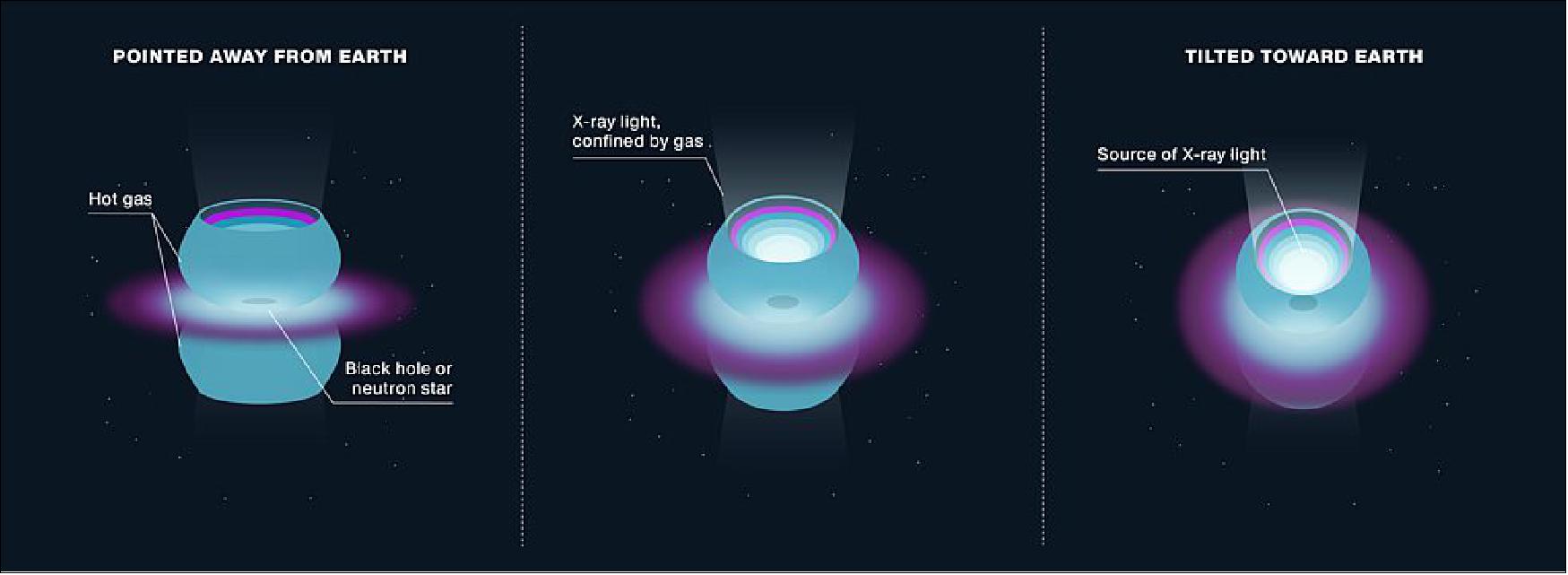
- Scientists have suspected that some ULXs might be hidden from view for this reason. SS 433 provided a unique chance to test this idea because, like a top, it wobbles on its axis – a process astronomers call precession.
- Most of the time, both of SS 433's cones point well away from Earth. But because of the way SS 433 precesses, one cone periodically tilts slightly toward Earth, so scientists can see a little bit of the X-ray light coming out of the top of the cone. In the new study, the scientists looked at how the X-rays seen by NuSTAR change as SS 433 moves. They show that if the cone continued to tilt toward Earth so that scientists could peer straight down it, they would see enough X-ray light to officially call SS 433 a ULX.
- Black holes that feed at extreme rates have shaped the history of our universe. Supermassive black holes, which are millions to billions of times the mass of the Sun, can profoundly affect their host galaxy when they feed. Early in the universe's history, some of these massive black holes may have fed as fast as SS 433, releasing huge amounts of radiation that reshaped local environments. Outflows (like the cones in SS 433) redistributed matter that could eventually form stars and other objects.
- But because these quickly consuming behemoths reside in incredibly distant galaxies (the one at the heart of the Milky Way isn't currently eating much), they remain difficult to study. With SS 433, scientists have found a miniature example of this process, much closer to home and much easier to study, and NuSTAR has provided new insights into the activity occurring there.
- "When we launched NuSTAR, I don't think anyone expected that ULXs would be such a rich area of research for us," said Fiona Harrison, principal investigator for NuSTAR and a professor of physics at Caltech in Pasadena, California. "But NuSTAR is unique in that it can see almost the whole range of X-ray wavelengths emitted by these objects, and that gives us insight into the extreme processes that must be driving them."
• June 17, 2020: Astronomers tend to have a slightly different sense of time than the rest of us. They regularly study events that happened millions or billions of years ago, and objects that have been around for just as long. That's partly why the recently discovered neutron star known as Swift J1818.0-1607 is remarkable: A new study in the journal Astrophysical Journal Letters estimates that it is only about 240 years old — a veritable newborn by cosmic standards. 19)
- NASA's Neil Gehrels Swift Observatory spotted the young object on March 12, when it released a massive burst of X-rays. Follow-up studies by the European Space Agency's XMM-Newton observatory and NASA's NuSTAR telescope, which is led by Caltech and managed by the agency's Jet Propulsion Laboratory, revealed more of the neutron star's physical characteristics, including those used to estimate its age.
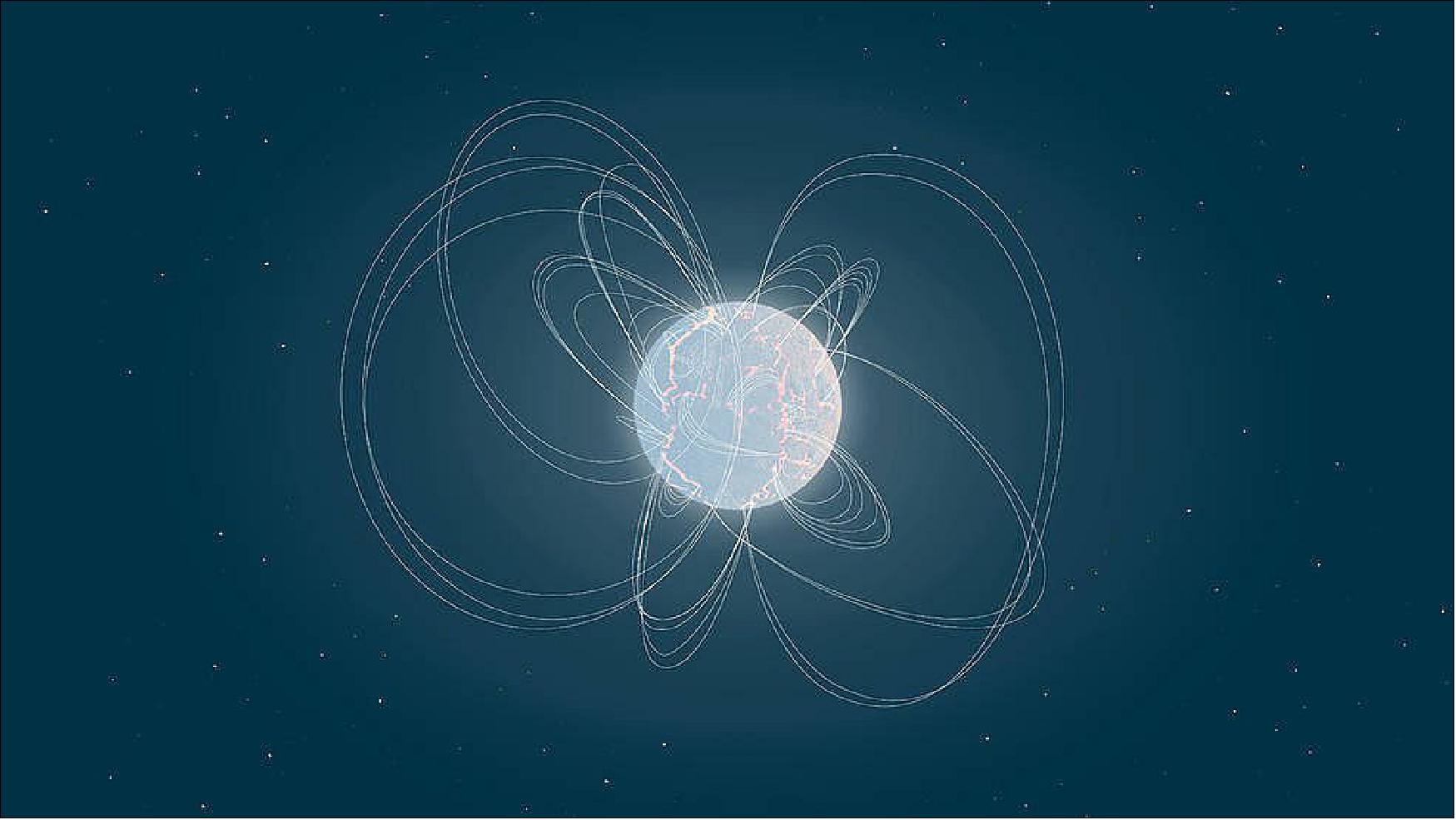
- A neutron star is an incredibly dense nugget of stellar material left over after a massive star goes supernova and explodes. In fact, they're some of the densest objects in the universe (second only to black holes): A teaspoon of neutron star material would weigh 4 billion tons on Earth. The atoms inside a neutron star are smashed together so tightly, they behave in ways not found anywhere else. Swift J1818.0-1607 packs twice the mass of our Sun into a volume more than one trillion times smaller.
- With a magnetic field up to 1,000 times stronger than a typical neutron star — and about 100 million times stronger than the most powerful magnets made by humans — Swift J1818.0-1607 belongs to a special class of objects called magnetars, which are the most magnetic objects in the universe. And it appears to be the youngest magnetar ever discovered. If its age is confirmed, that means light from the stellar explosion that formed it would have reached Earth around the time that George Washington became the first president of the United States.
- "This object is showing us an earlier time in a magnetar's life than we've ever seen before, very shortly after its formation," said Nanda Rea, a researcher at the Institute of Space Sciences in Barcelona and principal investigator on the observation campaigns by XMM Newton and NuSTAR (Nuclear Spectroscopic Telescope Array).
- While there are over 3,000 known neutron stars, scientists have identified just 31 confirmed magnetars — including this newest entry. Because their physical properties can't be re-created on Earth, neutron stars (including magnetars) are natural laboratories for testing our understanding of the physical world.
- "Maybe if we understand the formation story of these objects, we'll understand why there is such a huge difference between the number of magnetars we've found and the total number of known neutron stars," Rea said.
- Swift J1818.0-1607 is located in the constellation Sagittarius and is relatively close to Earth — only about 16,000 light-years away. (Because light takes time to travel these cosmic distances, we are seeing light that the neutron star emitted about 16,000 years ago, when it was about 240 years old.) Many scientific models suggest that the physical properties and behaviors of magnetars change as they age and that magnetars may be most active when they are younger. So finding a younger sample close by like this will help refine those models.
Going to Extremes
- Though neutron stars are only about 10 to 20 miles (15 to 30 kilometers) wide, they can emit huge bursts of light on par with those of much larger objects. Magnetars in particular have been linked to powerful eruptions bright enough to be seen clear across the universe. Considering the extreme physical characteristics of magnetars, scientists think there are multiple ways that they can generate such huge amounts of energy.
- The Swift mission spotted Swift J1818.0-1607 when it began outbursting. In this phase, its X-ray emission became at least 10 times brighter than normal. Outbursting events vary in their specifics, but they usually begin with a sudden increase in brightness over the course of days or weeks that is followed by a gradual decline over months or years as the magnetar returns to its normal brightness.
- That's why astronomers have to act fast if they want to observe the period of peak activity from one of these events. The Swift mission alerted the global astronomy community to the event, and XMM-Newton (which has NASA participation) and NuSTAR performed quick follow-up studies.
- In addition to X-rays, magnetars have been known to release great bursts of gamma rays, the highest energy form of light in the universe. They can also emit steady beams of radio waves, the lowest energy form of light in the universe. (Neutron stars that emit long-lived radio beams are called radio pulsars; Swift J1818.0-1607 is one of five known magnetars that are also radio pulsars.)
- "What's amazing about [magnetars] is they're quite diverse as a population," said Victoria Kaspi, director of the McGill Space Institute at McGill University in Montreal and a former member of the NuSTAR team, who was not involved with the study. "Each time you find one it's telling you a different story. They're very strange and very rare, and I don't think we've seen the full range of possibilities."
- The new study was led by Paolo Esposito with the School for Advanced Studies (IUSS) in Pavia, Italy.
About the Missions
- NuSTAR recently celebrated eight years in space, having launched on June 13, 2012. A Small Explorer mission led by Caltech and managed by JPL for NASA's Science Mission Directorate in Washington, NuSTAR was developed in partnership with the Danish Technical University and the Italian Space Agency (ASI). The spacecraft was built by Orbital Sciences Corp. in Dulles, Virginia. NuSTAR's mission operations center is at the University of California, Berkeley, and the official data archive is at NASA's High Energy Astrophysics Science Archive Research Center. ASI provides the mission's ground station and a mirror archive. Caltech manages JPL for NASA.
- ESA's XMM-Newton observatory was launched in December 1999 from Kourou, French Guiana. NASA funded elements of the XMM-Newton instrument package and provides the NASA Guest Observer Facility at Goddard, which supports use of the observatory by U.S. astronomers.
- NASA's Goddard Space Flight Center manages the Swift mission in collaboration with Penn State in University Park, the Los Alamos National Laboratory in New Mexico and Northrop Grumman Innovation Systems in Dulles, Virginia. Other partners include the University of Leicester and Mullard Space Science Laboratory of the University College London in the United Kingdom, Brera Observatory and ASI.
• September 4, 2019: Pops of bright blue and green in this image of the Fireworks galaxy (NGC 6946) show the locations of extremely bright sources of X-ray light captured by NASA's NuSTAR space observatory. Generated by some of the most energetic processes in the universe, these X-ray sources are rare compared to the many visible light sources in the background image. A new study, published in the Astrophysical Journal, offers some possible explanations for the surprise appearance of the green source near the center of the galaxy, which came into view and disappeared in a matter of weeks. 20)
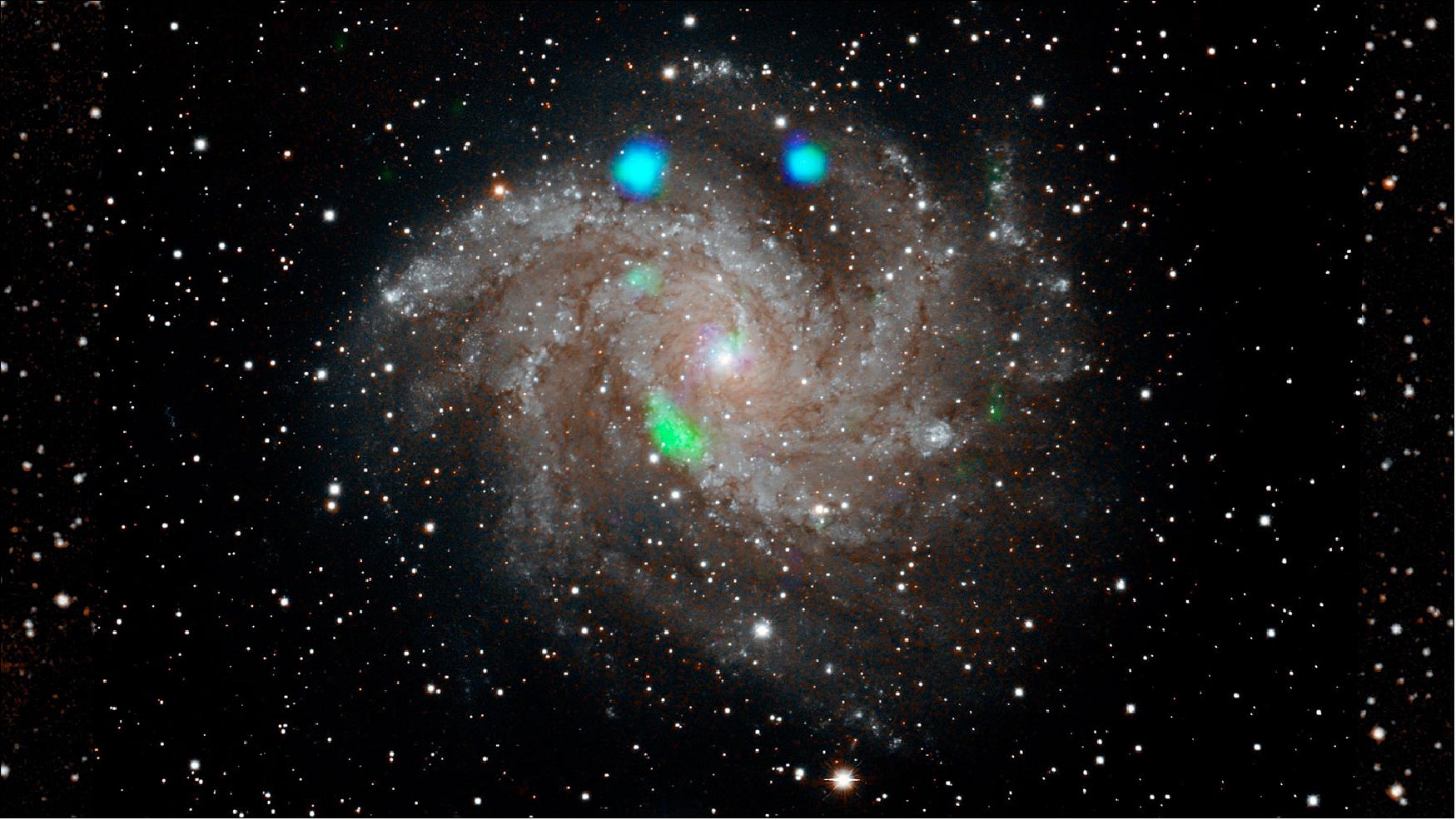
- The primary objective of the NuSTAR observations was to study the supernova - the explosion of a star much more massive than our Sun - that appears as a bright blue-green spot at upper right. These violent events can briefly produce enough visible light to outshine entire galaxies consisting of billions of stars. They also generate many of the chemical elements in our universe that are heavier than iron.
- The green blob near the bottom of the galaxy wasn't visible during the first NuSTAR observation but was burning bright at the start of a second observation 10 days later. NASA's Chandra X-ray Observatory later observed that the source - known as an ULX (Ultraluminous X-ray source) - had disappeared just as quickly. The object has since been named ULX-4 because it is the fourth ULX identified in this galaxy. No visible light was detected with the X-ray source, a fact that most likely rules out the possibility that it is also a supernova.
- "Ten days is a really short amount of time for such a bright object to appear," said Hannah Earnshaw, a postdoctoral researcher at Caltech in Pasadena, California, and lead author on the new study. "Usually with NuSTAR, we observe more gradual changes over time, and we don't often observe a source multiple times in quick succession. In this instance, we were fortunate to catch a source changing extremely quickly, which is very exciting."
Possible Black Hole
- The new study explores the possibility that the light came from a black hole consuming another object, such as a star. If an object gets too close to a black hole, gravity can pull that object apart, bringing the debris into a close orbit around the black hole. Material at the inner edge of this newly formed disk starts moving so fast that it heats up to millions of degrees and radiates X-rays. (The surface of the Sun, by comparison, is about 10,000 degrees Fahrenheit, or 5,500 degrees Celsius.)
- Most ULXs are typically long-lived because they're created by a dense object, like a black hole, that "feeds" on the star for an extended period of time. Short-lived, or "transient," X-ray sources like ULX-4 are far more rare, so a single dramatic event - like a black hole quickly destroying a small star - might explain the observation.
- However, ULX-4 might not be a one-off event, and the paper's authors explored other potential explanations for this object. One possibility: The source of ULX-4 could be a neutron star. Neutron stars are extremely dense objects formed from the explosion of a star that wasn't massive enough to form a black hole. With about the same mass as our Sun but packed into an object about the size of a large city, neutron stars can, like black holes, draw in material and create a fast-moving disk of debris. These can also generate slow-feeding ultraluminous X-ray sources, although the X-ray light is produced through slightly different processes than in ULXs created by black holes.
- Neutron stars generate magnetic fields so strong they can create "columns" that channel material down to the surface, generating powerful X-rays in the process. But if the neutron star spins especially fast, those magnetic fields can create a barrier, making it impossible for material to reach the star's surface.
- "It would kind of be like trying to jump onto a carousel that's spinning at thousands of miles per hour," said Earnshaw.
- The barrier effect would prevent the star from being a bright source of X-rays except for those times when the magnetic barrier might waver briefly, allowing material to slip through and fall onto the neutron star's surface. This could be another possible explanation for the sudden appearance and disappearance of ULX-4. If the same source were to light up again, it might support this hypothesis.
- "This result is a step towards understanding some of the rarer and more extreme cases in which matter accretes onto black holes or neutron stars," Earnshaw said.
- NuSTAR is a Small Explorer mission led by Caltech and managed by JPL for NASA's Science Mission Directorate in Washington. NuSTAR was developed in partnership with the Danish Technical University and the Italian Space Agency (ASI). The spacecraft was built by Orbital Sciences Corp. in Dulles, Virginia. NuSTAR's mission operations center is at the University of California Berkeley, and the official data archive is at NASA's High Energy Astrophysics Science Archive Research Center. ASI provides the mission's ground station and a mirror archive. Caltech manages JPL for NASA.
• February 20, 2019: In the nearby Whirlpool galaxy and its companion galaxy, M51b, two supermassive black holes heat up and devour surrounding material. These two monsters should be the most luminous X-ray sources in sight, but a new study using observations from NASA's NuSTAR (Nuclear Spectroscopic Telescope Array) mission shows that a much smaller object is competing with the two behemoths. 21) 22)
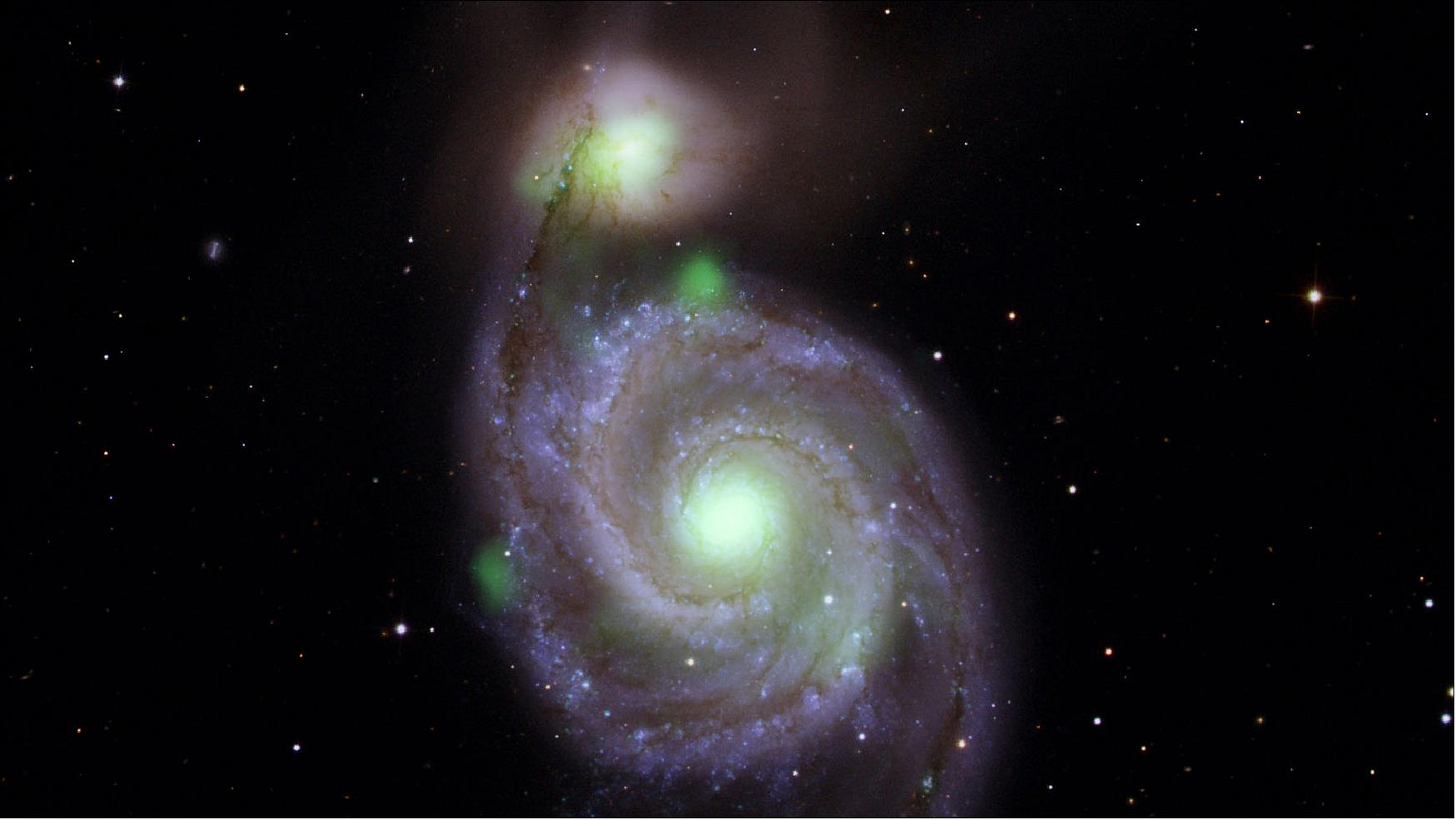
- The most stunning features of the Whirlpool galaxy - officially known as M51a - are the two long, star-filled "arms" curling around the galactic center like ribbons. The much smaller M51b clings like a barnacle to the edge of the Whirlpool. Collectively known as M51, the two galaxies are merging.
- At the center of each galaxy is a supermassive black hole millions of times more massive than the Sun. The galactic merger should push huge amounts of gas and dust into those black holes and into orbit around them. In turn, the intense gravity of the black holes should cause that orbiting material to heat up and radiate, forming bright disks around each that can outshine all the stars in their galaxies.
- But neither black hole is radiating as brightly in the X-ray range as scientists would expect during a merger. Based on earlier observations from satellites that detect low-energy X-rays, such as NASA's Chandra X-ray Observatory, scientists believed that layers of gas and dust around the black hole in the larger galaxy were blocking extra emission. But the new study, published in the Astrophysical Journal, used NuSTAR's high-energy X-ray vision to peer below those layers and found that the black hole is still dimmer than expected.
- "I'm still surprised by this finding," said study lead author Murray Brightman, a researcher at Caltech in Pasadena, California. "Galactic mergers are supposed to generate black hole growth, and the evidence of that would be strong emission of high-energy X-rays. But we're not seeing that here."
- Brightman thinks the most likely explanation is that black holes "flicker" during galactic mergers rather than radiate with a more or less constant brightness throughout the process.
- "The flickering hypothesis is a new idea in the field," said Daniel Stern, a research scientist at NASA's Jet Propulsion Laboratory in Pasadena and the project scientist for NuSTAR. "We used to think that the black hole variability occurred on timescales of millions of years, but now we're thinking those timescales could be much shorter. Figuring out how short is an area of active study."
Small but Brilliant
- Along with the two black holes radiating less than scientists anticipated in M51a and M51b, the former also hosts an object that is millions of times smaller than either black hole yet is shining with equal intensity. The two phenomena are not connected, but they do create a surprising X-ray landscape in M51.
- The small X-ray source is a neutron star, an incredibly dense nugget of material left over after a massive star explodes at the end of its life. A typical neutron star is hundreds of thousands of times smaller in diameter than the Sun - only as wide as a large city - yet has one to two times the mass. A teaspoon of neutron star material would weigh more than 1 billion tons.
- Despite their size, neutron stars often make themselves known through intense light emissions. The neutron star found in M51 is even brighter than average and belongs to a newly discovered class known as ultraluminous neutron stars. Brightman said some scientists have proposed that strong magnetic fields generated by the neutron star could be responsible for the luminous emission; a previous paper by Brightman and colleagues about this neutron star supports that hypothesis. Some of the other bright, high-energy X-ray sources seen in these two galaxies could also be neutron stars.
- NuSTAR is a Small Explorer mission led by Caltech and managed by JPL for NASA's Science Mission Directorate in Washington. NuSTAR was developed in partnership with the Danish Technical University and the Italian Space Agency (ASI). The spacecraft was built by Orbital Sciences Corporation in Dulles, Virginia (now part of Northrop Grumman). NuSTAR's mission operations center is at UC Berkeley, and the official data archive is at NASA's High Energy Astrophysics Science Archive Research Center. ASI provides the mission's ground station and a mirror archive. Caltech manages JPL for NASA
• July 3, 2018: A new study using data from NASA's NuSTAR space telescope suggests that Eta Carinae, the most luminous and massive stellar system within 10,000 light-years, is accelerating particles to high energies — some of which may reach Earth as cosmic rays. 23)
- "We know the blast waves of exploded stars can accelerate cosmic ray particles to speeds comparable to that of light, an incredible energy boost," said Kenji Hamaguchi, an astrophysicist at NASA's Goddard Space Flight Center in Greenbelt, Maryland, and the lead author of the study. "Similar processes must occur in other extreme environments. Our analysis indicates Eta Carinae is one of them."
- Astronomers know that cosmic rays with energies greater than 1 billion electron volts (eV) come to us from beyond our solar system. But because these particles — electrons, protons and atomic nuclei — all carry an electrical charge, they veer off course whenever they encounter magnetic fields. This scrambles their paths and masks their origins.
- Eta Carinae, located about 7,500 light-years away in the southern constellation of Carina, is famous for a 19th century outburst that briefly made it the second-brightest star in the sky. This event also ejected a massive hourglass-shaped nebula, but the cause of the eruption remains poorly understood.
- The system contains a pair of massive stars whose eccentric orbits bring them unusually close every 5.5 years. The stars contain 90 and 30 times the mass of our Sun and pass 140 million miles (225 million kilometers) apart at their closest approach — about the average distance separating Mars and the Sun.
- "Both of Eta Carinae's stars drive powerful outflows called stellar winds," said team member Michael Corcoran, also at Goddard. "Where these winds clash changes during the orbital cycle, which produces a periodic signal in low-energy X-rays we've been tracking for more than two decades."
- NASA's Fermi Gamma-ray Space Telescope also observes a change in gamma rays — light packing far more energy than X-rays — from a source in the direction of Eta Carinae. But Fermi's vision isn't as sharp as X-ray telescopes, so astronomers couldn't confirm the connection.
- To bridge the gap between low-energy X-ray monitoring and Fermi observations, Hamaguchi and his colleagues turned to NuSTAR. Launched in 2012, NuSTAR can focus X-rays of much greater energy than any previous telescope. Using both newly taken and archival data, the team examined NuSTAR observations acquired between March 2014 and June 2016, along with lower-energy X-ray observations from the European Space Agency's XMM-Newton satellite over the same period.
- Eta Carinae's low-energy, or soft, X-rays come from gas at the interface of the colliding stellar winds, where temperatures exceed 70 million degrees Fahrenheit (40 million degrees Celsius). But NuSTAR detects a source emitting X-rays above 30,000 eV, some three times higher than can be explained by shock waves in the colliding winds. For comparison, the energy of visible light ranges from about 2 to 3 eV.
- The team's analysis, presented in a paper published on Monday, July 2, in Nature Astronomy, shows that these "hard" X-rays vary with the binary orbital period and show a similar pattern of energy output as the gamma rays observed by Fermi. 24)
- The researchers say that the best explanation for both the hard X-ray and the gamma-ray emission is electrons accelerated in violent shock waves along the boundary of the colliding stellar winds. The X-rays detected by NuSTAR and the gamma rays detected by Fermi arise from starlight given a huge energy boost by interactions with these electrons.
- Some of the superfast electrons, as well as other accelerated particles, must escape the system and perhaps some eventually wander to Earth, where they may be detected as cosmic rays.
- "We've known for some time that the region around Eta Carinae is the source of energetic emission in high-energy X-rays and gamma rays", said Fiona Harrison, the principal investigator of NuSTAR and a professor of astronomy at Caltech in Pasadena, California. "But until NuSTAR was able to pinpoint the radiation, show it comes from the binary and study its properties in detail, the origin was mysterious."
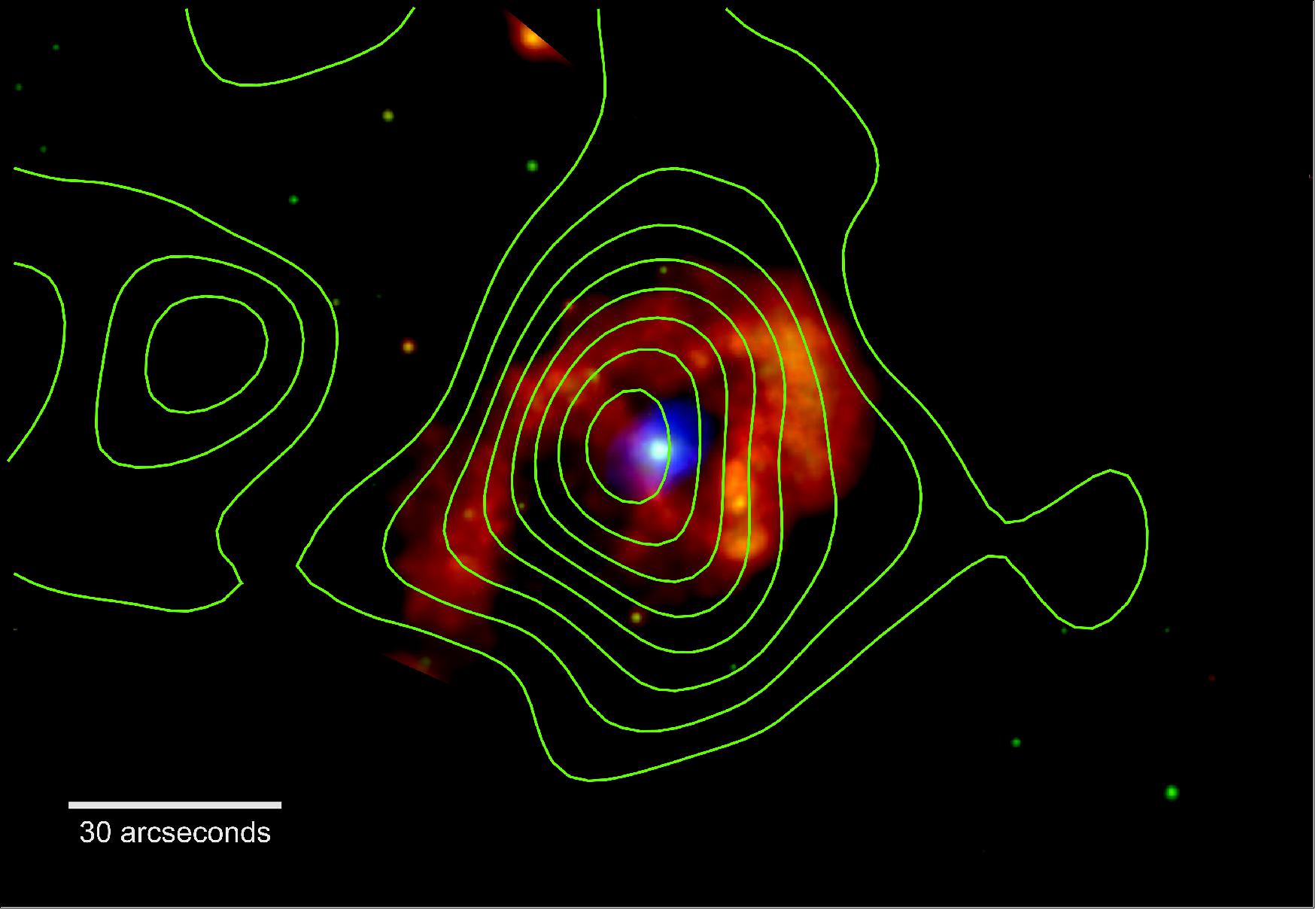
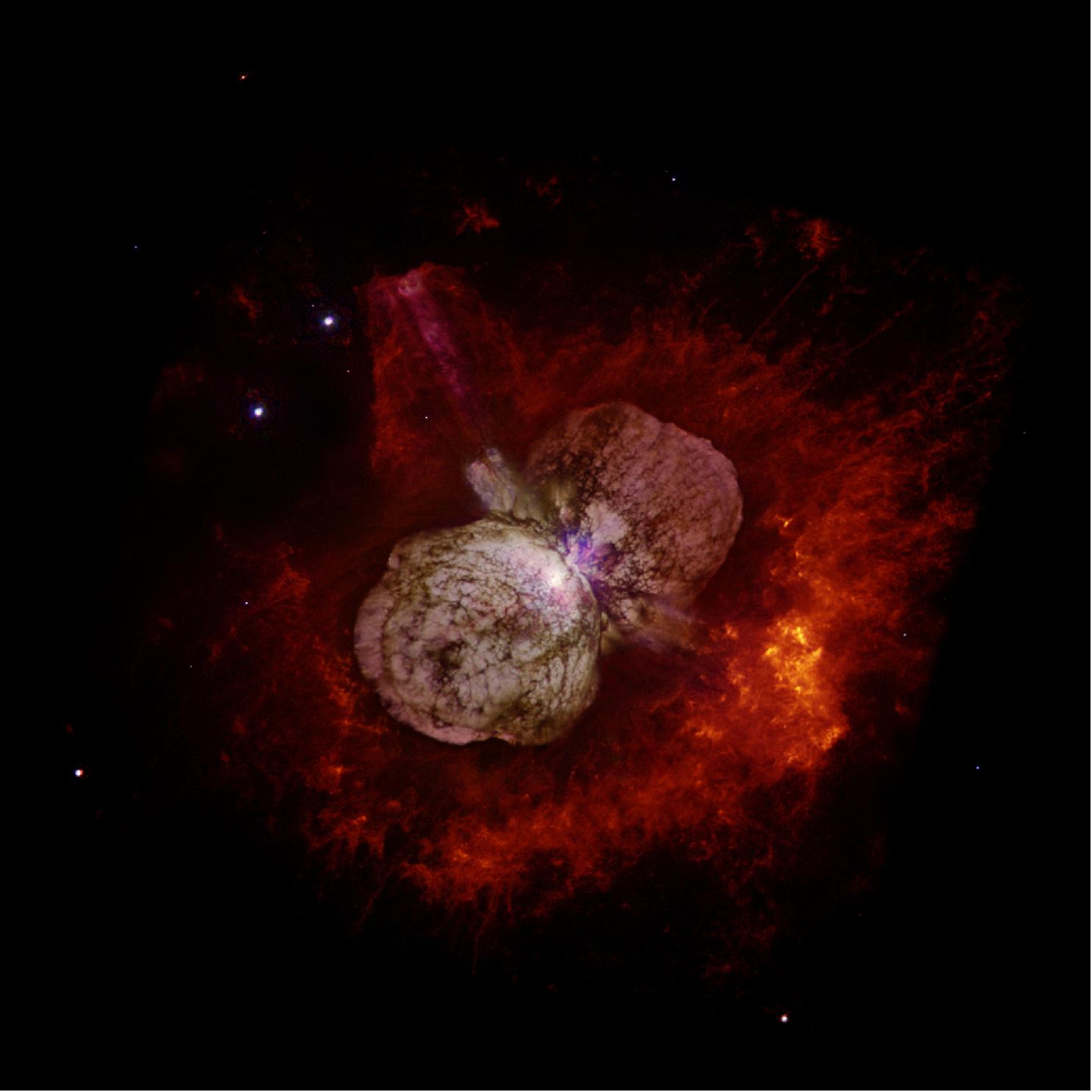
• October 30, 2017: Black holes are famous for being ravenous eaters, but they do not eat everything that falls toward them. A small portion of material gets shot back out in powerful jets of hot gas, called plasma, that can wreak havoc on their surroundings. Along the way, this plasma somehow gets energized enough to strongly radiate light, forming two bright columns along the black hole's axis of rotation. Scientists have long debated where and how this happens in the jet. 25)
- Astronomers have new clues to this mystery. Using NASA's NuSTAR space telescope and a fast camera called ULTRACAM on the William Herschel Observatory in La Palma, Spain, scientists have been able to measure the distance that particles in jets travel before they "turn on" and become bright sources of light. This distance is called the "acceleration zone." The study is published in the journal Nature Astronomy. 26)
- Scientists looked at two systems in the Milky Way called "X-ray binaries," each consisting of a black hole feeding off of a normal star. They studied these systems at different points during periods of outburst — which is when the accretion disk — a flat structure of material orbiting the black hole — brightens because of material falling in.
- One system, called V404 Cygni, had reached nearly peak brightness when scientists observed it in June 2015. At that time, it experienced the brightest outburst from an X-ray binary seen in the 21st century. The other, called GX 339-4,was less than 1 percent of its maximum expected brightness when it was observed. The star and black hole of GX 339-4 are much closer together than in the V404 Cygni system.
- Despite their differences, the systems showed similar time delays - about one-tenth of a second — between when NuSTAR first detected X-ray light and ULTRACAM detected flares in visible light slightly later. That delay is less than the blink of an eye, but significant for the physics of black hole jets.
- "One possibility is that the physics of the jet is not determined by the size of the disc, but instead by the speed, temperature and other properties of particles at the jet's base," said Poshak Gandhi, lead author of the study and astronomer at the University of Southampton, United Kingdom.
- The best theory scientists have to explain these results is that the X-ray light originates from material very close to the black hole. Strong magnetic fields propel some of this material to high speeds along the jet. This results in particles colliding near light-speed, energizing the plasma until it begins to emit the stream of optical radiation caught by ULTRACAM.
- Where in the jet does this occur? The measured delay between optical and X-ray light explains this. By multiplying this amount of time by the speed of the particles, which is nearly the speed of light, scientists determine the maximum distance traveled.
- This expanse of about 30,000 km represents the inner acceleration zone in the jet, where plasma feels the strongest acceleration and "turns on" by emitting light. That's just under three times the diameter of Earth, but tiny in cosmic terms, especially considering the black hole in V404 Cygni weighs as much as 3 million Earths put together.
- "Astronomers hope to refine models for jet powering mechanisms using the results of this study," said Daniel Stern, study co-author and astronomer based at NASA's Jet Propulsion Laboratory, Pasadena, California.
- Making these measurements wasn't easy. X-ray telescopes in space and optical telescopes on the ground have to look at the X-ray binaries at exactly the same time during outbursts for scientists to calculate the tiny delay between the telescopes' detections. Such coordination requires complex planning between the observatory teams. In fact, coordination between NuSTAR and ULTRACAM was only possible for about an hour during the 2015 outburst, but that was enough to calculate the groundbreaking results about the acceleration zone.
- The results also appear to connect with scientists' understanding of supermassive black holes, much bigger than the ones in this study. In one supermassive system called BL Lacertae, weighing 200 million times the mass of our Sun, scientists have inferred time delays millions of times greater than what this study found. That means the size of the acceleration area of the jets is likely related to the mass of the black hole.
- "We are excited because it looks as though we have found a characteristic yardstick related to the inner workings of jets, not only in stellar-mass black holes like V404 Cygni, but also in monster supermassive ones," Gandhi said.
- The next steps are to confirm this measured delay in observations of other X-ray binaries, and to develop a theory that can tie together jets in black holes of all sizes.
- "Global ground and space telescopes working together were key to this discovery. But this is only a peek, and much remains to be learned. The future is really bright for understanding the extreme physics of black holes," said Fiona Harrison, principal investigator of NuSTAR and professor of astronomy at Caltech in Pasadena.
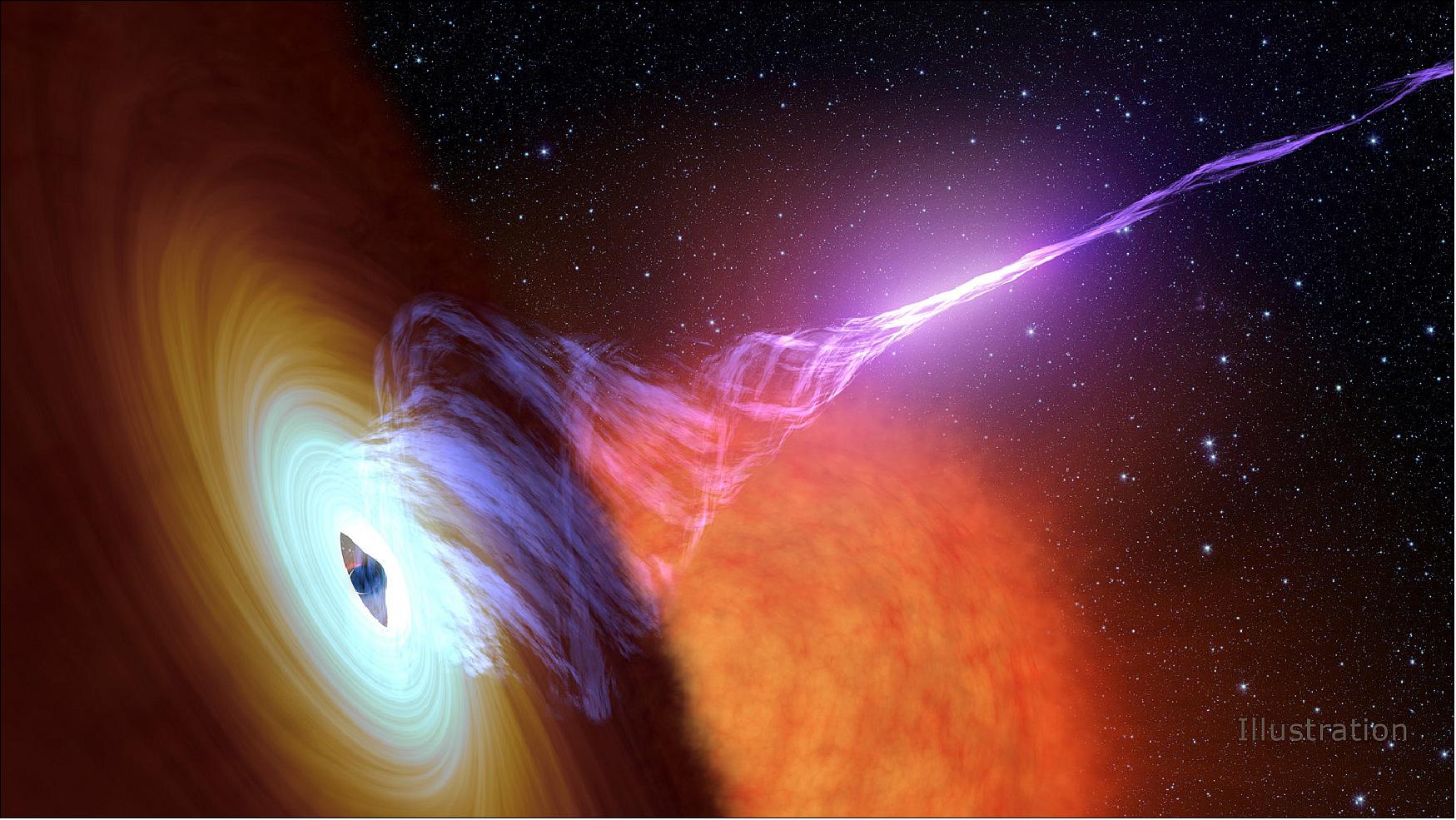
• On June 13, 2017, the NuSTAR spacecraft was 5 years on Orbit. 27)
• May 9, 2017: Black holes get a bad rap in popular culture for swallowing everything in their environments. In reality, stars, gas and dust can orbit black holes for long periods of time, until a major disruption pushes the material in. -A merger of two galaxies is one such disruption. As the galaxies combine and their central black holes approach each other, gas and dust in the vicinity are pushed onto their respective black holes. An enormous amount of high-energy radiation is released as material spirals rapidly toward the hungry black hole, which becomes what astronomers call an AGN (Active Galactic Nucleus). 28)
- A study using NASA's NuSTAR telescope shows that in the late stages of galaxy mergers, so much gas and dust falls toward a black hole that the extremely bright AGN is enshrouded. The combined effect of the gravity of the two galaxies slows the rotational speeds of gas and dust that would otherwise be orbiting freely. This loss of energy makes the material fall onto the black hole.
- "The further along the merger is, the more enshrouded the AGN will be," said Claudio Ricci, lead author of the study published in the Monthly Notices Royal Astronomical Society. "Galaxies that are far along in the merging process are completely covered in a cocoon of gas and dust." 29)
- Ricci and colleagues observed the penetrating high-energy X-ray emission from 52 galaxies. About half of them were in the later stages of merging. Because NuSTAR is very sensitive to detecting the highest-energy X-rays, it was critical in establishing how much light escapes the sphere of gas and dust covering an AGN.
- The study was published in the Monthly Notices of the Royal Astronomical Society. Researchers compared NuSTAR observations of the galaxies with data from NASA's Swift and Chandra and ESA's XMM-Newton observatories, which look at lower energy components of the X-ray spectrum. If high-energy X-rays are detected from a galaxy, but low-energy X-rays are not, that is a sign that an AGN is heavily obscured.
- The study helps confirm the longstanding idea that an AGN's black hole does most of its eating while enshrouded during the late stages of a merger. "A supermassive black hole grows rapidly during these mergers," Ricci said. "The results further our understanding of the mysterious origins of the relationship between a black hole and its host galaxy."
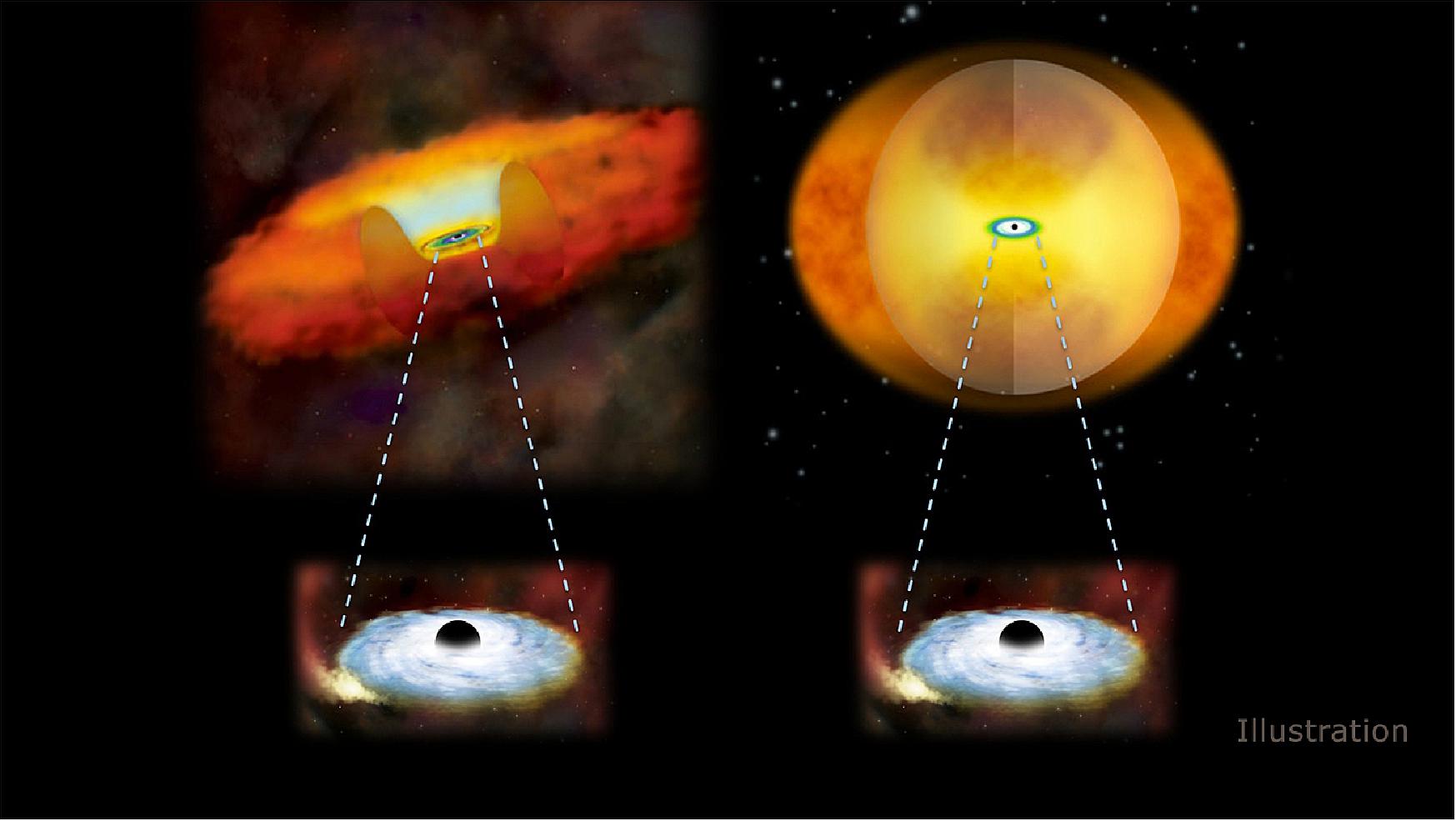
• March 27, 2017: A supermassive black hole inside a tiny galaxy is challenging scientists' ideas about what happens when two galaxies become one. 30)
- Was 49 is the name of a system consisting of a large disk galaxy, referred to as Was 49a, merging with a much smaller "dwarf" galaxy called Was 49b. The dwarf galaxy rotates within the larger galaxy's disk, about 26,000 light-years from its center. Thanks to NASA's NuSTAR mission, scientists have discovered that the dwarf galaxy is so luminous in high-energy X-rays, it must host a supermassive black hole much larger and more powerful than expected.
- "This is a completely unique system and runs contrary to what we understand of galaxy mergers," said Nathan Secrest, lead author of the study and postdoctoral fellow at the U.S. NRL (Naval Research Laboratory) in Washington.
- Data from NuSTAR and the Sloan Digital Sky Survey suggest that the mass of the dwarf galaxy's black hole is huge, compared to similarly sized galaxies, at more than 2% of the galaxy's own mass. "We didn't think that dwarf galaxies hosted supermassive black holes this big," Secrest said. "This black hole could be hundreds of times more massive than what we would expect for a galaxy of this size, depending on how the galaxy evolved in relation to other galaxies."
- The dwarf galaxy's black hole is the engine of an AGN (Active Galactic Nucleus), a cosmic phenomenon in which extremely high-energy radiation bursts forth as a black hole devours gas and dust. This particular AGN appears to be covered by a donut-shaped structure made of gas and dust. NASA's Chandra and Swift missions were used to further characterize the X-ray emission.
- Normally, when two galaxies start to merge, the larger galaxy's central black hole becomes active, voraciously gobbling gas and dust, and spewing out high-energy X-rays as matter gets converted into energy. That is because, as galaxies approach each other, their gravitational interactions create a torque that funnels gas into the larger galaxy's central black hole. But in this case, the smaller galaxy hosts a more luminous AGN with a more active supermassive black hole, and the larger galaxy's central black hole is relatively quiet.
- An optical image of the Was 49 system, compiled using observations from the Discovery Channel Telescope in Happy Jack, Arizona, uses the same color filters as the Sloan Digital Sky Survey. Since Was 49 is so far away, these colors are optimized to separate highly-ionized gas emission, such as the pink-colored region around the feeding supermassive black hole, from normal starlight, shown in green. This allowed astronomers to more accurately determine the size of the dwarf galaxy that hosts the supermassive black hole.
- The pink-colored emission stands out in a new image because of the intense ionizing radiation emanating from the powerful AGN. Buried within this region of intense ionization is a faint collection of stars, believed to be part of the galaxy surrounding the enormous black hole. These striking features lie on the outskirts of the much larger spiral galaxy Was 49a, which appears greenish in the image due to the distance to the galaxy and the optical filters used.
- Scientists are still trying to figure out why the supermassive black hole of dwarf galaxy Was 49b is so big. It may have already been large before the merger began, or it may have grown during the very early phase of the merger.
- "This study is important because it may give new insight into how supermassive black holes form and grow in such systems," Secrest said. "By examining systems like this, we may find clues as to how our own galaxy's supermassive black hole formed." - In several hundred million years, the black holes of the large and small galaxies will merge into one enormous beast.
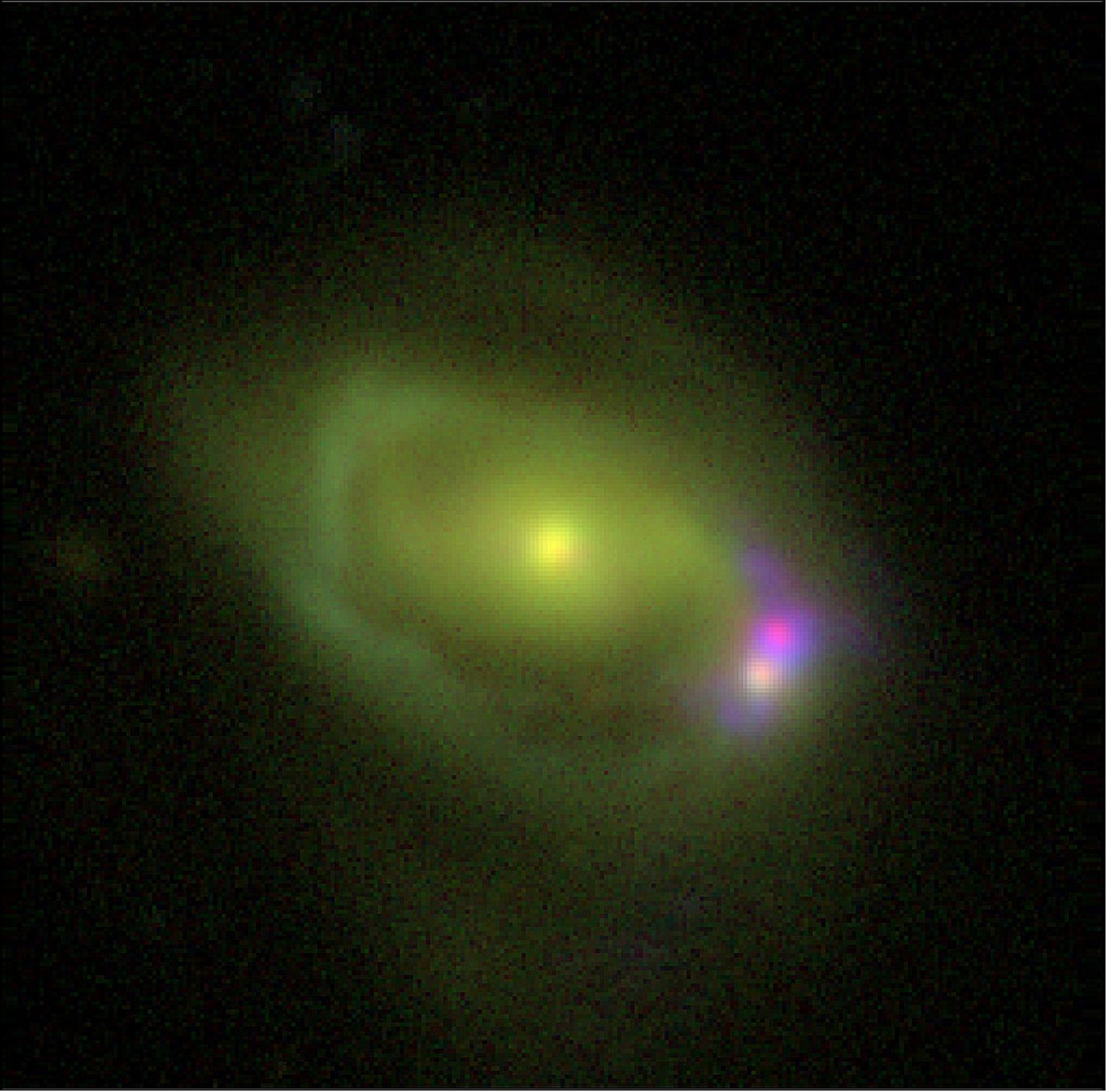
Legend to Figure 27: The dark pink-colored emission stands out because of the intense ionizing radiation emanating from the powerful active galactic nucleus of the dwarf galaxy. Buried within this region of intense ionization is a faint collection of stars, shown in light pink, believed to be part of the galaxy surrounding the enormous black hole. These striking features lie on the outskirts of the much larger spiral galaxy Was 49a, which appears greenish in the image due to the distance to the galaxy and the optical filters used. — Since Was 49 is so far away, the colors in this image are optimized to separate highly-ionized gas emission, such as the pink-colored region around the feeding supermassive black hole, from normal starlight, shown in green. This allowed astronomers to more accurately determine the size of the dwarf galaxy that hosts the supermassive black hole.
• March 23, 2017: The Milky Way's close neighbor, Andromeda, features a dominant source of high-energy X-ray emission, but its identity was mysterious until now. As reported in a new study, NASA's NuSTAR (Nuclear Spectroscopic Telescope Array) mission has pinpointed an object responsible for this high-energy radiation. 31)
- The object, called Swift J0042.6+4112, is a possible pulsar, the dense remnant of a dead star that is highly magnetized and spinning, researchers say. This interpretation is based on its emission in high-energy X-rays, which NuSTAR is uniquely capable of measuring. The object's spectrum is very similar to known pulsars in the Milky Way.
- It is likely in a binary system, in which material from a stellar companion gets pulled onto the pulsar, spewing high-energy radiation as the material heats up. "We didn't know what it was until we looked at it with NuSTAR," said Mihoko Yukita, lead author of a study about the object, based at JHU (Johns Hopkins University) in Baltimore. The study is published in The Astrophysical Journal. 32)
- This candidate pulsar is shown as a blue dot in a NuSTAR X-ray image of Andromeda (also called M31), where the color blue is chosen to represent the highest-energy X-rays. It appears brighter in high-energy X-rays than anything else in the galaxy.
- The study brings together many different observations of the object from various spacecraft. In 2013, NASA's Swift satellite reported it as a high-energy source, but its classification was unknown, as there are many objects emitting low energy X-rays in the region. The lower-energy X-ray emission from the object turns out to be a source first identified in the 1970s by NASA's Einstein Observatory. Other spacecraft, such as NASA's Chandra X-ray Observatory and ESA's XMM-Newton had also detected it. However, it wasn't until the new study by NuSTAR, aided by supporting Swift satellite data, that researchers realized it was the same object as this likely pulsar that dominates the high energy X-ray light of Andromeda.
- Traditionally, astronomers have thought that actively feeding black holes, which are more massive than pulsars, usually dominate the high-energy X-ray light in galaxies. As gas spirals closer and closer to the black hole in a structure called an accretion disk, this material gets heated to extremely high temperatures and gives off high-energy radiation. This pulsar, which has a lower mass than any of Andromeda's black holes, is brighter at high energies than the galaxy's entire black hole population.
- Even the supermassive black hole in the center of Andromeda does not have significant high-energy X-ray emission associated with it. It is unexpected that a single pulsar would instead be dominating the galaxy in high-energy X-ray light.
- "NuSTAR has made us realize the general importance of pulsar systems as X-ray-emitting components of galaxies, and the possibility that the high energy X-ray light of Andromeda is dominated by a single pulsar system only adds to this emerging picture," said Ann Hornschemeier, co-author of the study and based at NASA's Goddard Space Flight Center, Greenbelt, Maryland.
- Andromeda is a spiral galaxy slightly larger than the Milky Way. It resides 2.5 million light-years from our own galaxy, which is considered very close, given the broader scale of the universe. Stargazers can see Andromeda without a telescope on dark, clear nights.
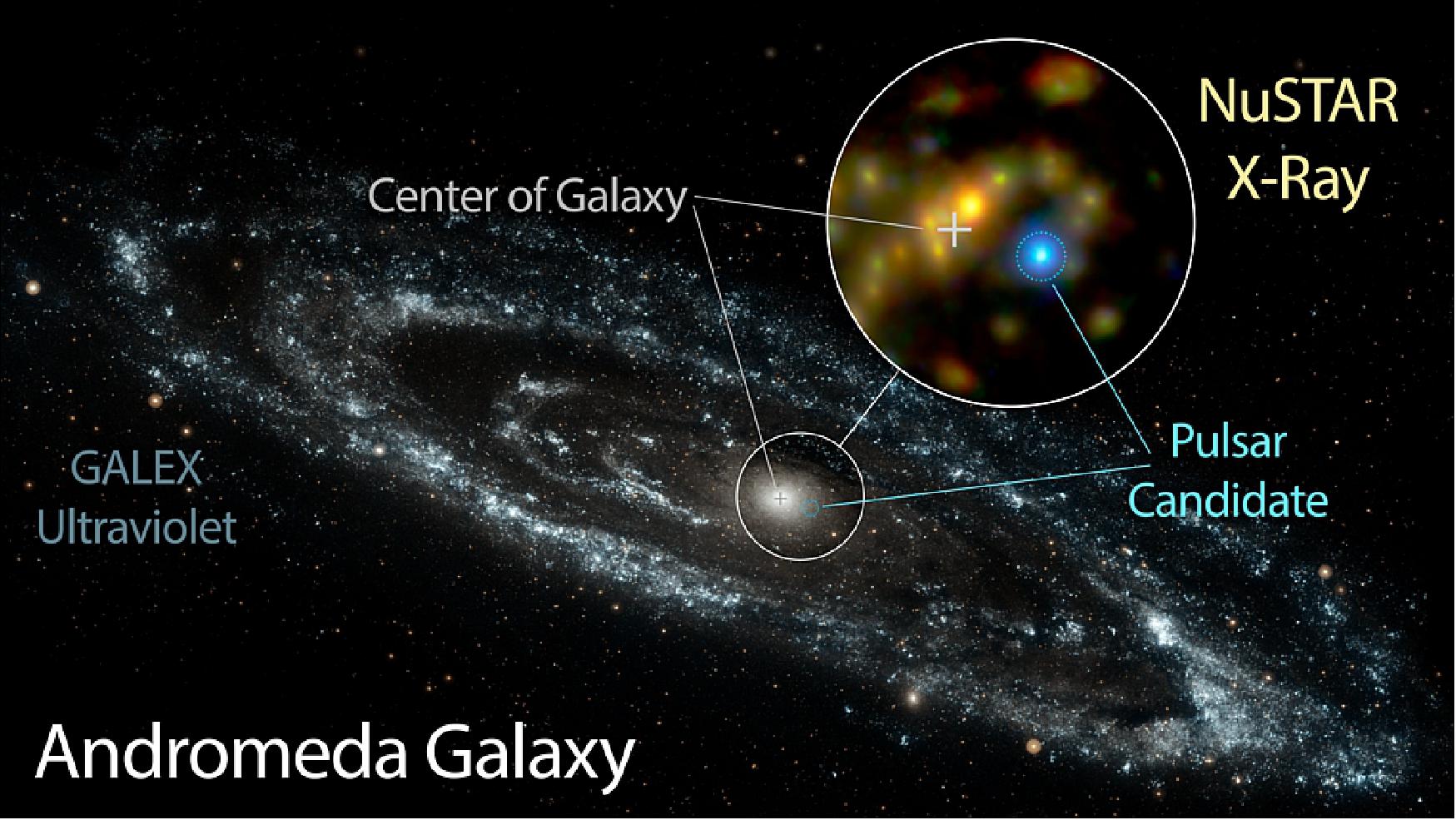
• February 28, 2017: There's a new record holder for brightest pulsar ever found — and astronomers are still trying to figure out how it can shine so brightly. It's now part of a small group of mysterious bright pulsars that are challenging astronomers to rethink how pulsars accumulate, or accrete, material. 33)
- A pulsar is a spinning, magnetized neutron star that sweeps regular pulses of radiation in two symmetrical beams across the cosmos. If aligned well enough with Earth, these beams act like a lighthouse beacon — appearing to flash on and off as the pulsar rotates. Pulsars were previously massive stars that exploded in powerful supernovae, leaving behind these small, dense stellar corpses.
- The brightest pulsar, as reported in the journal Science, is called NGC 5907 ULX. In one second, it emits the same amount of energy as our sun does in 3.5 years. The ESA XMM-Newton satellite found the pulsar and, independently, NASA's NuSTAR (Nuclear Spectroscopic Telescope Array) mission also detected the signal. This pulsar is 50 million light years away, which means its light dates back to a time before humans roamed Earth. It is also the farthest known neutron star. 34)
- "This object is really challenging our current understanding of the accretion process for high-luminosity pulsars," said Gian Luca Israel, from INAF-Osservatorio Astronomica di Roma, Italy, lead author of the Science paper. "It is 1,000 times more luminous than the maximum thought possible for an accreting neutron star, so something else is needed in our models in order to account for the enormous amount of energy released by the object."
- The previous record holder for brightest pulsar was reported in October 2014. NuSTAR had identified M82 X-2, located about 12 million light-years away in the "Cigar Galaxy" galaxy Messier 82 (M82), as a pulsar rather than a black hole. The pulsar reported in Science, NGC 5907 ULX, is 10 times brighter.
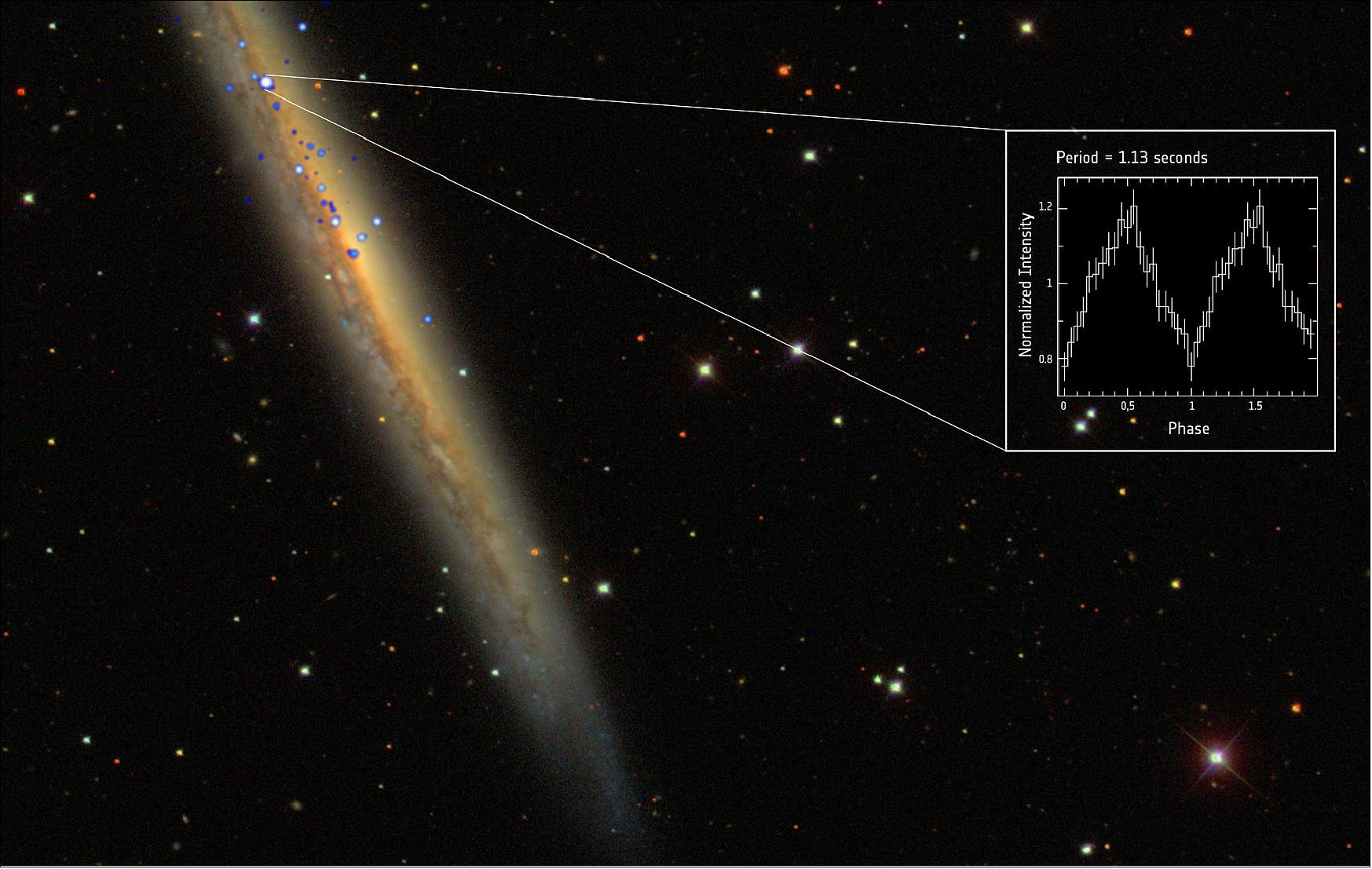
• January 31, 2017: Scientists observing a neutron star in the "Rapid Burster" system may have solved a 40-year-old mystery surrounding its puzzling X-ray bursts. 35)
- Discovered in the 1970s, the Rapid Burster is a binary system comprising a low-mass star in its prime and a neutron star — the compact remnant of a massive star's demise. The gravitational pull of the neutron star strips its companion of some of its gas, which then forms an accretion disk and spirals toward the neutron star.
- Most neutron star binary systems continuously release large amounts of X-rays, punctuated by additional X-ray flashes every few hours or days. But scientists have wondered for decades about what accounts for the Rapid Burster's sudden, erratic and extremely intense X-ray emissions — a phenomenon seen only in one other binary system.
- In the new study, researchers discovered that the neutron star's magnetic field creates a gap between the star and the disk around it, largely preventing it from feeding on matter from its stellar companion. Gas builds up until, under certain conditions, it hits the neutron star all at once, producing intense flashes of X-rays.
- The new results provide the first evidence for what causes these so-called "type-II" bursts. The discovery was made with the European Space Agency's XMM-Newton mission and NASA's NuSTAR (Nuclear Spectroscopic Telescope Array) and Swift missions. 36) 37)
- In such a binary system, the gravitational pull of the dense neutron star is stripping gas away from its stellar companion (a low-mass star, not shown in the images of Figure 30). The gas forms an accretion disk and spirals towards the neutron star.
- Before the burst, the fast-spinning magnetic field of the neutron star keeps the gas flowing from the companion star at bay, preventing it from reaching closer to the neutron star and effectively creating an inner edge at the center of the disk (top left of Figure 30). During this phase, only small amounts of gas leak towards the neutron star.
- However, as the gas continues to flow and accumulate near this edge, it spins faster and faster (top right), and eventually catches up with the spinning velocity of the magnetic field (bottom left and right of Figure 30).
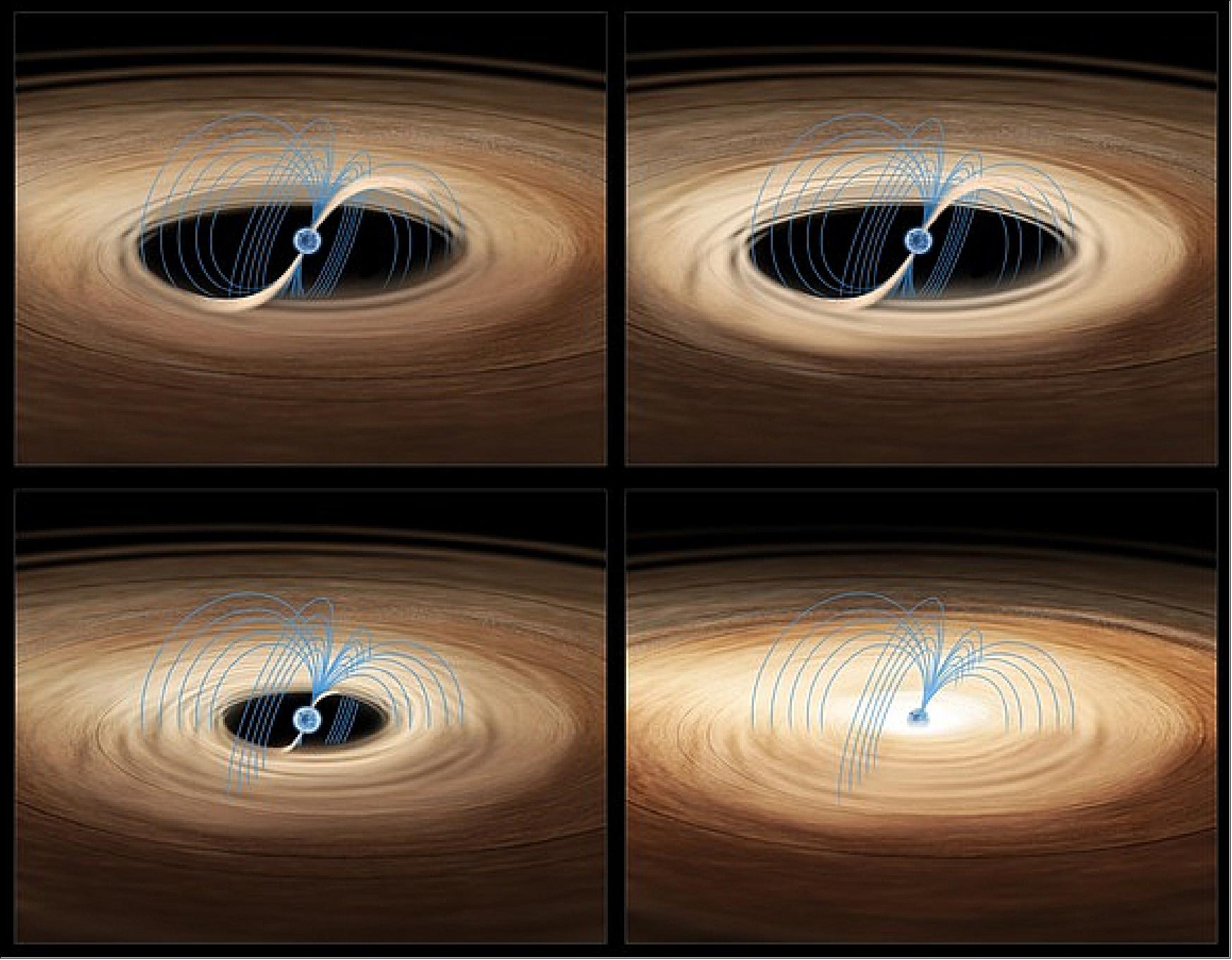
• Sept. 8, 2016: The central energy source of enigmatic pulsating ULX (Ultra Luminous X-ray ) sources could be a neutron star according to numerical simulations performed by a research group led by Tomohisa Kawashima at NAOJ (National Astronomical Observatory of Japan) . 38) 39)
- ULXs, which are remarkably bright X-ray sources, were thought to be powered by black holes. But in October 2014, the X-ray space telescope "NuSTAR" detected unexpected periodic pulsed emissions in a ULX named M82 X-2. The discovery of this object named "ULX-pulsar" has puzzled astrophysicists. Black holes can be massive enough to provide the energy needed to create ULXs, but black holes shouldn't be able to produce pulsed emissions. In contrast, "pulsars," a kind of neutron star, are named for the pulsed emissions they produce, but they are much fainter than ULXs. A new theory is needed to explain "ULX-pulsar."
- ULXs are thought to be caused by an object with strong gravity accreting gas from a companion star. As the gas falls towards the object, it collides with other gas. These collisions heat the gas until it gets hot enough to start glowing. The photons (in this case X-rays) emitted by this luminous gas are what astronomers actually observe. But as the photons travel away from the center, they push against the incoming gas, slowing the flow of gas towards the center. This force is called the radiation pressure force. As more gas falls onto the object, it becomes hotter and brighter, but if it becomes too bright the radiation pressure slows the infalling gas so much that it creates a "traffic jam." This traffic jam limits the rate at which new gas can add additional energy to the system and prevents it from getting any brighter. This luminosity upper limit, at which the radiation pressure balances the gravitational force, is called the Eddington luminosity.
- The Eddington luminosity is determined by the mass of the object. Because pulsars have masses hundreds of thousands of times less than the black holes thought to be powering ULXs, their Eddington luminosities are much lower than what would be needed to account for bright ULXs. But Kawashima and his team started to wonder if there might be a way for pulsars to avoid the traffic jam caused by the Eddington luminosity. "The astrophysicists have been so puzzled," he explains, "It may be difficult to sustain super-critical accretion onto neutron stars because neutron stars have solid surfaces, unlike black holes. It was a grand challenge to elucidate how to realize super-critical accretion onto neutron stars exhibiting pulsed emissions."
- For normal pulsars, researchers use an "accretion columns" model where the infalling gas is guided by the pulsar's strong magnetic field so that it lands on the magnetic poles. If the magnetic pole is misaligned with the neutron star's rotation axis (much like how 'magnetic north' is different from 'true north' on Earth), then the location of the magnetic pole will revolve around the rotation axis as the neutron star spins. If the magnetic pole points towards Earth, it appears bright to us, but when it rotates away, the emissions seem to disappear. This is similar to how a lighthouse seems to blink as the direction of its beam rotates.
- In order to address the mystery of ULX-pulsar, Kawashima and his team performed simulations to see if there is some way the accretion columns of gas could flow smoothly without a traffic jam and become hundreds of times brighter than the Eddington luminosity. "No one knew if super-critical column accretion could actually be realized on a neutron star," explains Shin Mineshige at Kyoto University, "It was a tough problem because we needed to simultaneously solve the equations of hydrodynamics and radiative transfer, which required advanced numerical techniques and computational power." In the 1970's, a few astrophysicists briefly addressed the calculation of moderately (not extremely) super-critical accretion columns, however they had to make many assumptions to make the calculations workable. "But thanks to recent developments in techniques and computer resources," says Ken Ohsuga at NAOJ, "we are now at the dawn of the radiation-hydrodynamic simulations era." The codes are already used for studies focused on black hole simulations. Thus, prompted by the discovery of ULX-pulsar, this team applied their radiation-hydrodynamic code to simulate super-critical accretion columns onto neutron stars, and carried out the simulations on the NAOJ supercomputer "ATERUI."
- The team found that it actually is possible for the infalling gas to avoid an Eddington luminosity induced traffic jam in super-critical column accretion. In their simulations, the accreting gas forms a shock front near the neutron star. Here, a huge amount of the kinetic energy of the infalling gas is converted to thermal energy. The gas just below the shock surface is rapidly heated by this energy and emits a huge number of photons. But rather than pushing back against the infalling gas as the previous models suggested, the photons are directed out the sides of the column. This means without a traffic jam, more gas can fall in rapidly, be heated by the shock front and produce more photons, so that the process isn't forced to slow down.
- The NAOJ team's model can account for the observed characteristics of ULX-pulsar: a high luminosity and directed beams of photons which will appear to blink as the neutron star rotates. Surprisingly, the direction of the photon beams is at a right angle to the polar beams expected in a standard pulsar model. This is the first simulation to support the idea that the central engine of the ULX-pulsar is a neutron star. This team is planning to further develop their work by using this new lighthouse model to study the detailed observational features of the ULX-pulsar M82 X-2, and to explore other ULX-pulsar candidates.
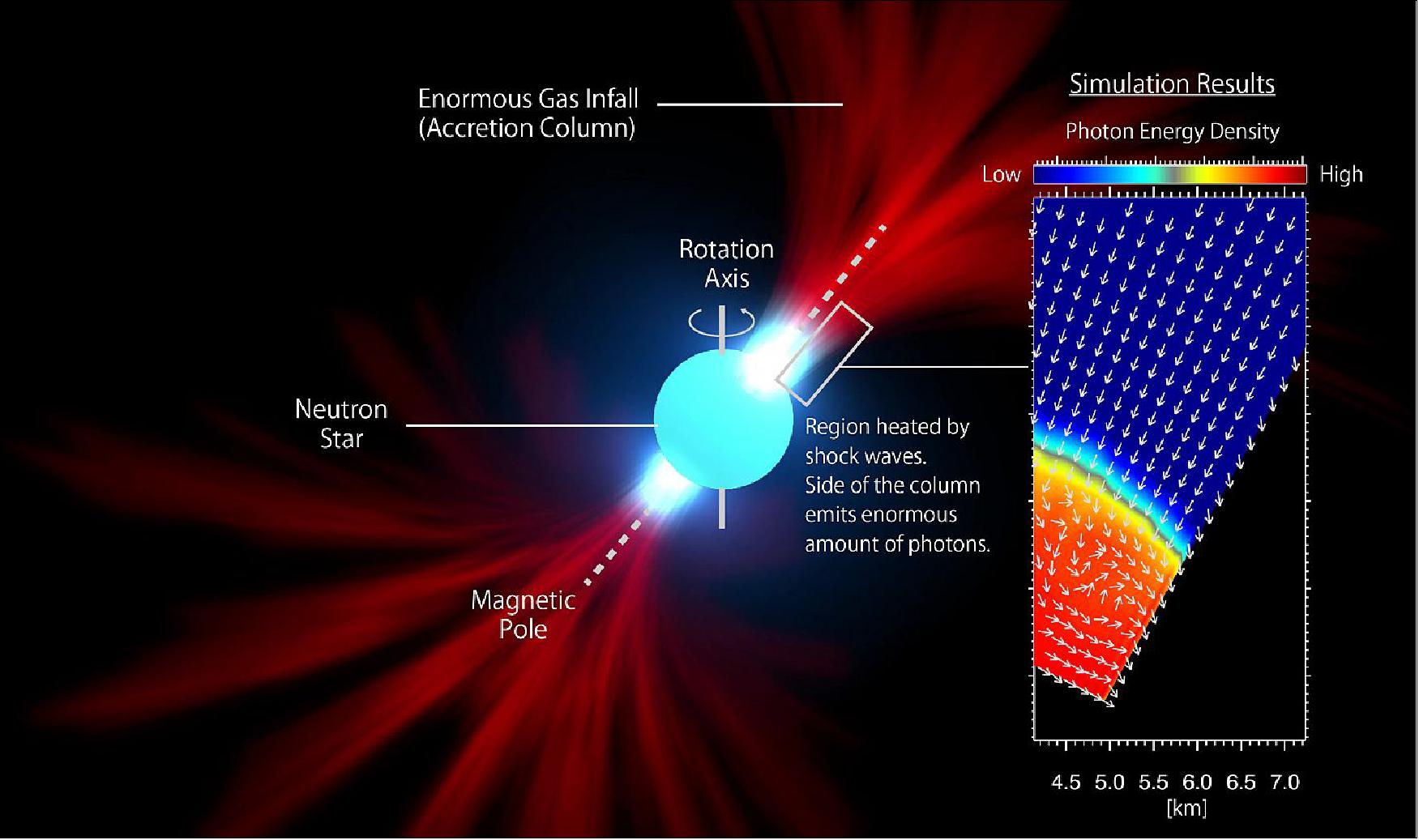
• July 28, 2016: Supermassive black holes in the universe are like a raucous choir singing in the language of X-rays. When black holes pull in surrounding matter, they let out powerful X-ray bursts. This song of X-rays, coming from a chorus of millions of black holes, fills the entire sky — a phenomenon astronomers call the cosmic X-ray background. 40)
- NASA's Chandra mission has managed to pinpoint many of the so-called active black holes contributing to this X-ray background, but the ones that let out high-energy X-rays — those with the highest-pitched "voices" — have remained elusive.
- New data from NASA's NuSTAR have for the first time, begun to pinpoint large numbers of the black holes belting out the high-energy X-rays. Or, in astronomer-speak, NuSTAR has made significant progress in resolving the high-energy X-ray background (Figure 32).
- "We've gone from resolving just two percent of the high-energy X-ray background to 35 percent," said Fiona Harrison, the principal investigator of NuSTAR at Caltech in Pasadena and lead author of a new study describing the findings in an upcoming issue of The Astrophysical Journal. "We can see the most obscured black holes, hidden in thick gas and dust."
- The results will ultimately help astronomers understand how the feeding patterns of supermassive black holes change over time. This is a key factor in the growth of not only black holes, but also the galaxies that host them. The supermassive black hole at the center of our Milky Way galaxy is dormant now, but at some point in the past, it too would have siphoned gas and bulked up in size.
- As black holes grow, their intense gravity pulls matter toward them. The matter heats up to scorching temperatures, and particles get boosted to close to the speed of light. Together, these processes make the black hole surroundings glow with X-rays. A supermassive black hole with a copious supply of fuel, or gas, will give off more high-energy X-rays. — NuSTAR is the first telescope capable of focusing these high-energy X-rays into sharp pictures.
- "Before NuSTAR, the X-ray background in high energies was just one blur with no resolved sources," said Harrison. "To untangle what's going on, you have to pinpoint and count up the individual sources of the X-rays."
- "We knew this cosmic choir had a strong high-pitched component, but we still don't know if it comes from a lot of smaller, quiet singers, or a few with loud voices," said co-author Daniel Stern, the project scientist for NuSTAR at NASA's Jet Propulsion Laboratory in Pasadena, California. "Now, thanks to NuSTAR, we're gaining a better understanding of the black holes and starting to address these questions."
- High-energy X-rays can reveal what lies around the most buried supermassive black holes, which are otherwise hard to see. In the same way that medical X-rays can travel through your skin to reveal pictures of bones, NuSTAR can see through the gas and dust around black holes, to get a deeper view of what's going on inside.
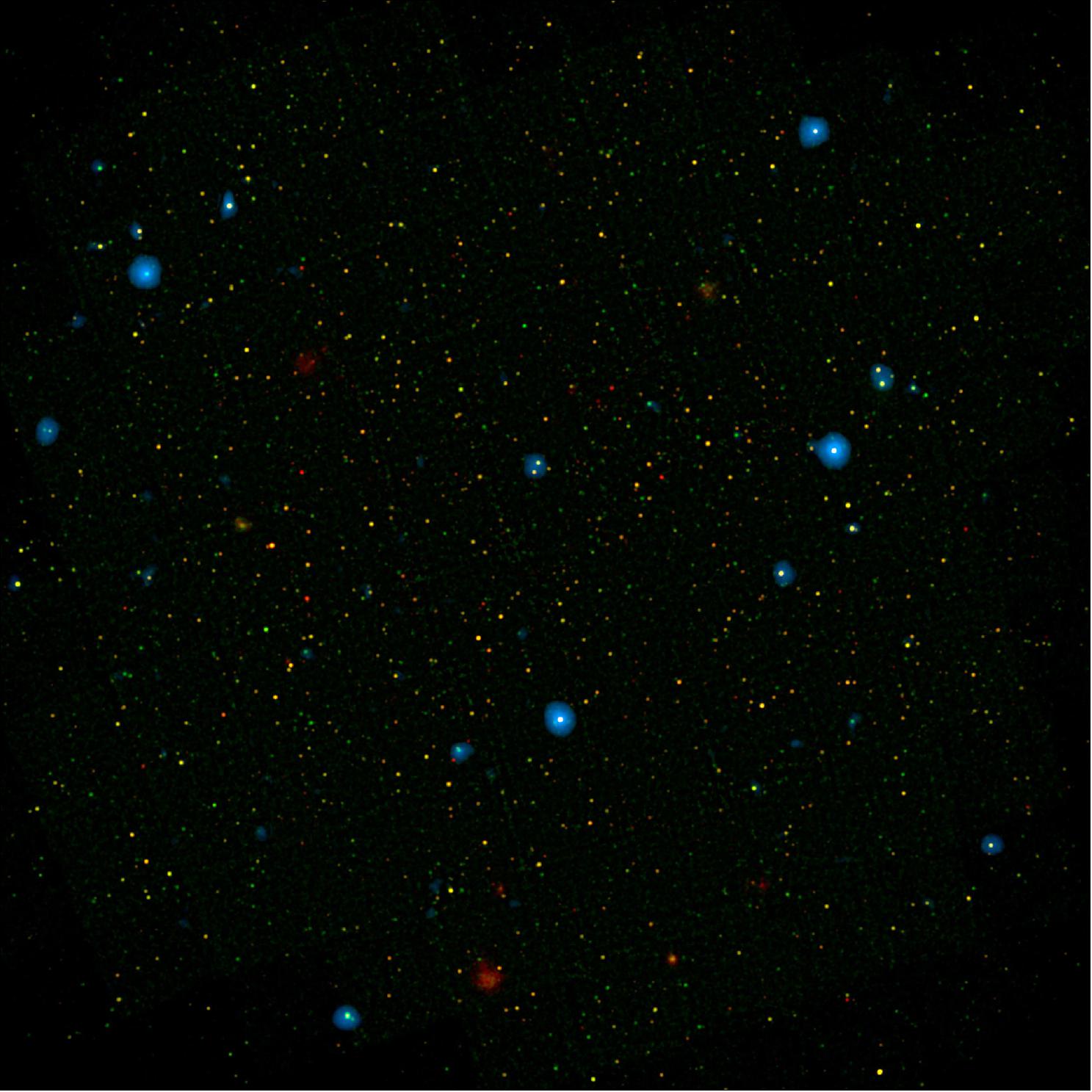
Legend to Figure 32: The other colored dots are galaxies that host black holes emitting lower-energy X-rays, and were spotted by NASA's Chandra X-ray Observatory. Chandra data show X-rays with energies between 0.5 to 7 keV, while NuSTAR data show X-rays between 8 to 24 keV.
• Jan. 5, 2016: NuSTAR has captured the best high-energy X-ray view yet of a portion of our nearest large, neighboring galaxy, Andromeda. The space mission has observed 40 "X-ray binaries" — intense sources of X-rays comprised of a black hole or neutron star that feeds off a stellar companion. The results will ultimately help researchers better understand the role of X-ray binaries in the evolution of our universe. According to astronomers, these energetic objects may play a critical role in heating the intergalactic bath of gas in which the very first galaxies formed. 41)
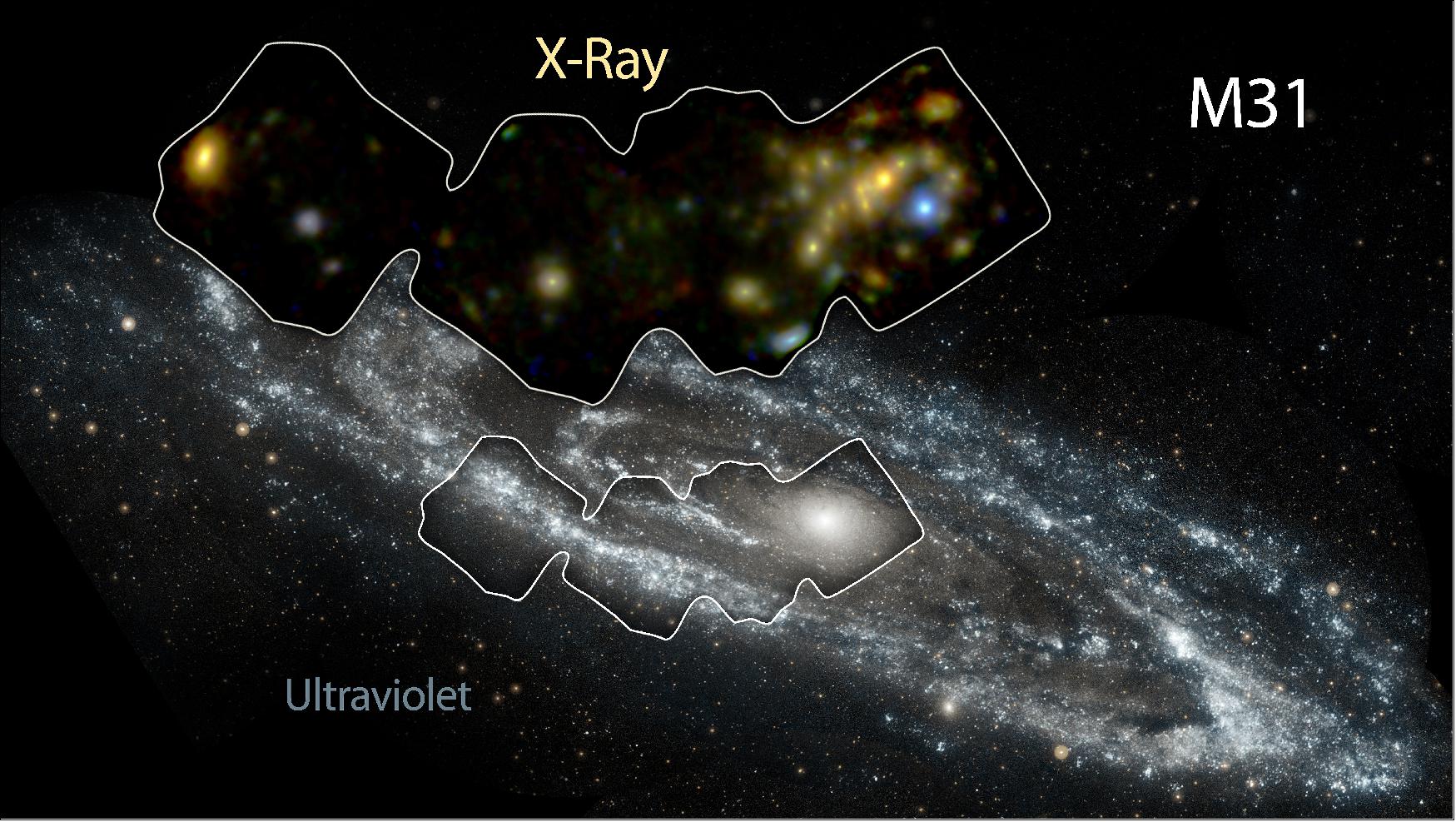
- Andromeda, also known as M31, can be thought of as the big sister to our own Milky Way galaxy. Both galaxies are spiral in shape, but Andromeda is slightly larger than the Milky Way in size. Lying 2.5 million light-years away, Andromeda is relatively nearby in cosmic terms. It can even be seen by the naked eye in dark, clear skies.
- Other space missions, such as NASA's Chandra X-ray Observatory, have obtained crisper images of Andromeda at lower X-ray energies than the high-energy X-rays detected by NuSTAR. The combination of Chandra and NuSTAR provides astronomers with a powerful tool for narrowing in on the nature of the X-ray binaries in spiral galaxies.
- In X-ray binaries, one member is always a dead star or remnant formed from the explosion of what was once a star much more massive than the sun. Depending on the mass and other properties of the original giant star, the explosion may produce either a black hole or neutron star. Under the right circumstances, material from the companion star can "spill over" its outermost edges and then be caught by the gravity of the black hole or neutron star. As the material falls in, it is heated to blazingly high temperatures, releasing a huge amount of X-rays.
• Dec. 17, 2015: NuSTAR finds a cosmic clumpy doughnut around a black hole. The most massive black holes in the universe are often encircled by thick, doughnut-shaped disks of gas and dust. This deep-space doughnut material ultimately feeds and nourishes the growing black holes tucked inside (Figure 34). 42)
- Until recently, telescopes weren't able to penetrate some of these doughnuts, also known as tori. "Originally, we thought that some black holes were hidden behind walls or screens of material that could not be seen through," said Andrea Marinucci of the Roma Tre University in Italy, lead author of a new Monthly Notices of the Royal Astronomical Society study describing results from NASA's NuSTAR (Nuclear Spectroscopic Telescope Array) and the European Space Agency's XMM-Newton space observatory.
- With its X-ray vision, NuSTAR recently peered inside one of the densest of these doughnuts known to surround a supermassive black hole. This black hole lies at the center of a well-studied spiral galaxy called NGC 1068, located 47 million light years away in the Cetus constellation.
- The observations revealed a clumpy, cosmic doughnut. "The rotating material is not a simple, rounded doughnut as originally thought, but clumpy," said Marinucci.
- Doughnut-shaped disks of gas and dust around supermassive black holes were first proposed in the mid-1980s to explain why some black holes are hidden behind gas and dust, while others are not. The idea is that the orientation of the doughnut relative to Earth affects the way we perceive a black hole and its intense radiation. If the doughnut is viewed edge-on, the black hole is blocked. If the doughnut is viewed face-on, the black hole and its surrounding, blazing materials can be detected. This idea is referred to as the unified model because it neatly joins together the different black hole types, based solely upon orientation.
- In the past decade, astronomers have been finding hints that these doughnuts aren't as smoothly shaped as once thought. They are more like defective, lumpy doughnuts that a doughnut shop might throw away.
- The new discovery is the first time this clumpiness has been observed in an ultra-thick doughnut, and supports the idea that this phenomenon may be common. The research is important for understanding the growth and evolution of massive black holes and their host galaxies.
Both NuSTAR and XMM-Newton observed the supermassive black hole in NGC 1068 simultaneously on two occasions between 2014 to 2015. On one of those occasions, in August 2014, NuSTAR observed a spike in brightness. NuSTAR observes X-rays in a higher-energy range than XMM-Newton, and those high-energy X-rays can uniquely pierce thick clouds around the black hole. The scientists say the spike in high-energy X-rays was due to a clearing in the thickness of the material entombing the supermassive black hole.
- NGC 1068 is well known to astronomers as the first black hole to give birth to the unification idea. "But it is only with NuSTAR that we now have a direct glimpse of its black hole through such clouds, albeit fleeting, allowing a better test of the unification concept," said Marinucci.
- The team says that future research will address the question of what causes the unevenness in doughnuts. The answer could come in many flavors. It's possible that a black hole generates turbulence as it chomps on nearby material. Or, the energy given off by young stars could stir up turbulence, which would then percolate outward through the doughnut. Another possibility is that the clumps may come from material falling onto the doughnut. As galaxies form, material migrates toward the center, where the density and gravity is greatest. The material tends to fall in clumps, almost like a falling stream of water condensing into droplets as it hits the ground.
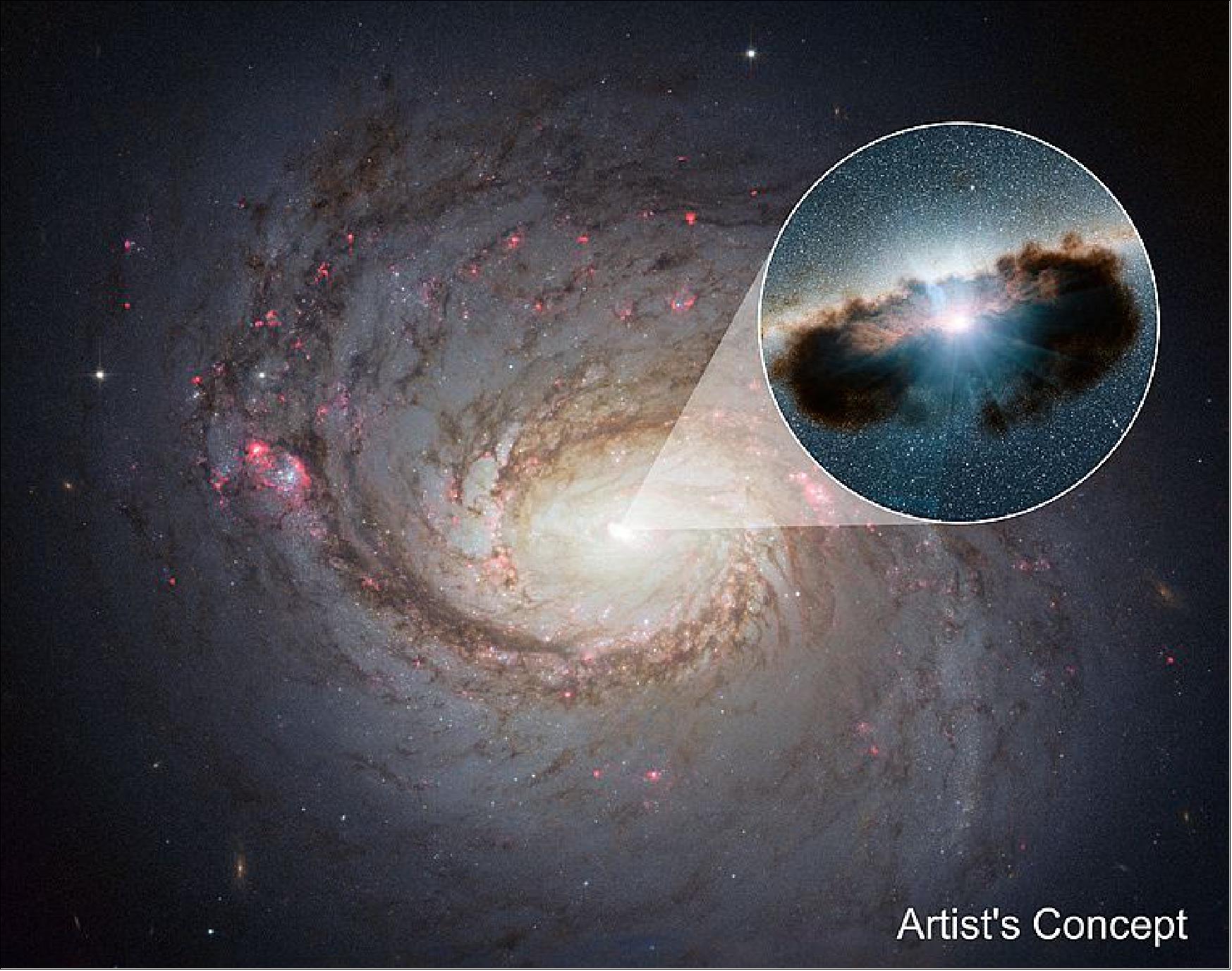
Legend to Figure 34: This active black hole — shown as an illustration in the zoomed-in inset — is one of the most obscured known, meaning that it is surrounded by extremely thick clouds of gas and dust. The NuSTAR data revealed that the torus of gas and dust surrounding the black hole, also referred to as a doughnut, is more clumpy than previously thought. doughnuts around active, supermassive black holes were originally proposed in the mid-1980s to be smooth entities. More recently, researchers have been finding that doughnuts are not so smooth but have lumps. NuSTAR's latest finding shows that this is true for even the thickest of doughnuts.
• On July 13, 2015, the NuSTAR mission was 3 years on orbit.
• July 8, 2015: X-rays light up the surface of our sun in a bouquet of colors in this new image (Figure 35) containing data from NASA's NuSTAR (Nuclear Spectroscopic Telescope Array). The high-energy X-rays seen by NuSTAR are shown in blue, while green represents lower-energy X-rays from the X-ray Telescope instrument on the Hinode spacecraft, named after the Japanese word for sunrise. The yellow and red colors show ultraviolet light from NASA's SDO (Solar Dynamics Observatory). 43)
- NuSTAR usually spends its time investigating the mysteries of black holes, supernovae, and other high-energy objects in space. But it can also look closer to home to study our sun. The active areas of the sun are filled with flares, which are giant eruptions on the surface of the sun that spew out charged particles and high-energy radiation. They occur when magnetic field lines become tangled and broken, and then reconnect. Due to its extreme sensitivity, NuSTAR's telescope cannot view the larger flares. But it can help measure the energy of smaller microflares, which produce only one-millionth the energy of the larger flares.
- NuSTAR may also be able to directly detect hypothesized nanoflares, which would be only one-billionth the energy of flares. Nanoflares — which may help explain why the sun's atmosphere, or corona, is much hotter than expected — would be hard to spot due to their small size. However, nanoflares may emit high-energy X-rays that NuSTAR has the sensitivity to detect. Astronomers suspect that these tiny flares, like their larger brethren, can send electrons flying at tremendous velocities. As the electrons zip around, they give off high-energy X-rays.
- Astronomers are also excited to use NuSTAR's images of the sun to pinpoint where energy from flares is released. While it is known that the energy is generally liberated in the upper solar atmosphere, the locations and detailed mechanisms are not precisely known.
- Cosmologists are looking forward to using NuSTAR's solar observations, too. There is a slim chance the telescope could detect a hypothesized dark matter particle called the axion. Dark matter is a mysterious substance in our universe that is about five times more abundant than the regular matter that makes up everyday objects and anything that gives off light. NuSTAR might be able to address this and other mysteries of the sun.
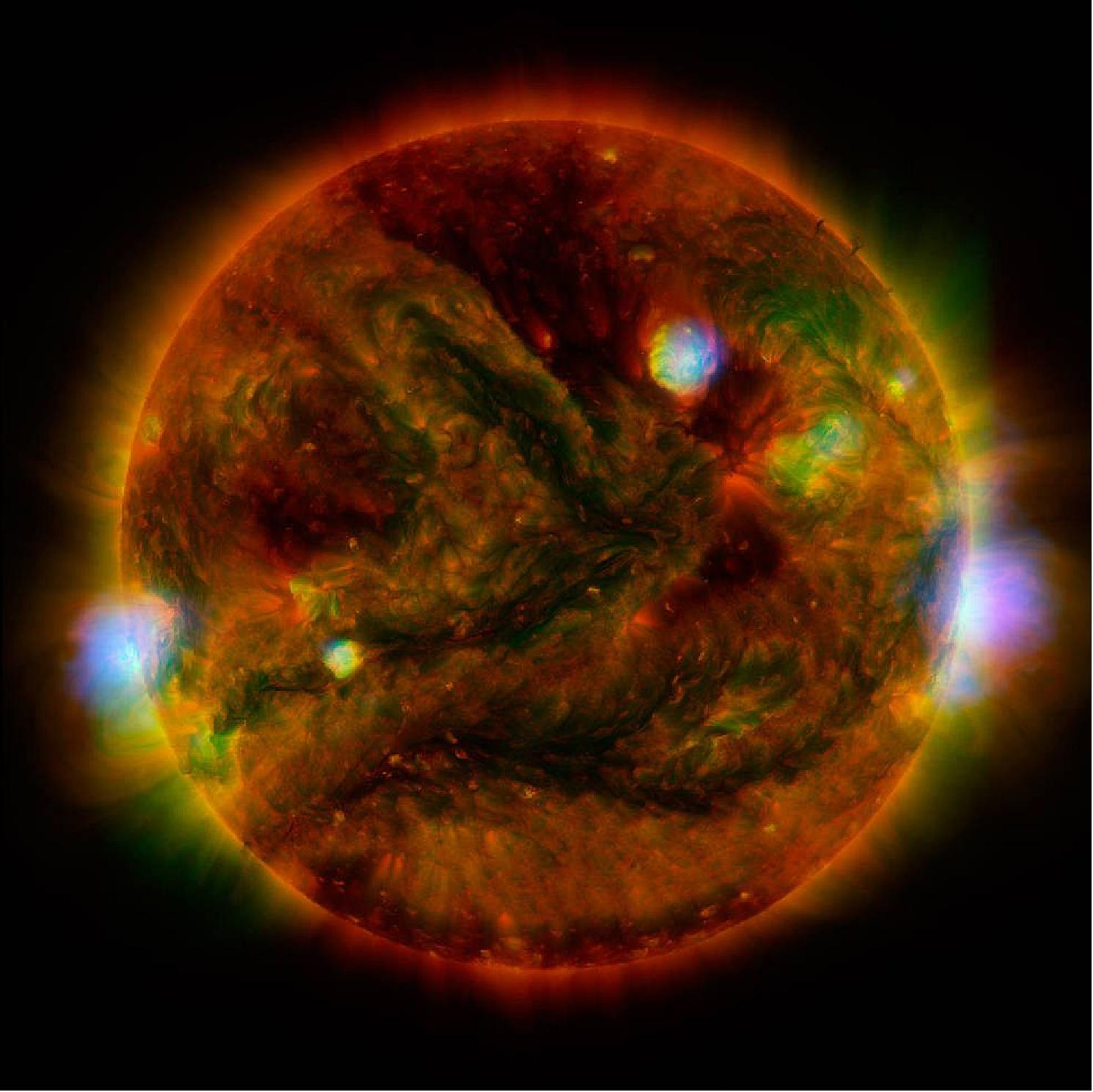
• April 29, 2015: Peering into the heart of the Milky Way galaxy, NASA's NuSTAR has spotted a mysterious glow of high-energy X-rays that, according to scientists, could be the "howls" of dead stars as they feed on stellar companions. The project scientists see a completely new component of the center of our galaxy with NuSTAR's images. The center of our Milky Way galaxy is bustling with young and old stars, smaller black holes and other varieties of stellar corpses – all swarming around a supermassive black hole called Sagittarius A. 44)
- Astronomers have four potential theories to explain the baffling X-ray glow, three of which involve different classes of stellar corpses. When stars die, they don't always go quietly into the night. Unlike stars like our sun, collapsed dead stars that belong to stellar pairs, or binaries, can siphon matter from their companions. This zombie-like "feeding" process differs depending on the nature of the normal star, but the result may be an eruption of X-rays.
- According to one theory, a type of stellar zombie called a pulsar could be at work. Pulsars are the collapsed remains of stars that exploded in supernova blasts. They can spin extremely fast and send out intense beams of radiation. As the pulsars spin, the beams sweep across the sky, sometimes intercepting the Earth, like lighthouse beacons.
- Other possible culprits include heavy-set stellar corpses called white dwarfs, which are the collapsed, burned-out remains of stars not massive enough to explode in supernovae. Our sun is such a star, and is destined to become a white dwarf in about five billion years. Because these white dwarfs are much denser than they were in their youth, they have stronger gravity and can produce higher-energy X-rays than normal. Another theory points to small black holes that slowly feed off their companion stars, radiating X-rays as material plummets down into their bottomless pits.
- Alternatively, the source of the high-energy X-rays might not be stellar corpses at all, astronomers say, but rather a diffuse haze of charged particles, called cosmic rays. The cosmic rays might originate from the supermassive black hole at the center of the galaxy as it devours material. When the cosmic rays interact with surrounding, dense gas, they emit X-rays.
- However, none of these theories match what is known from previous research, leaving the astronomers largely stumped.
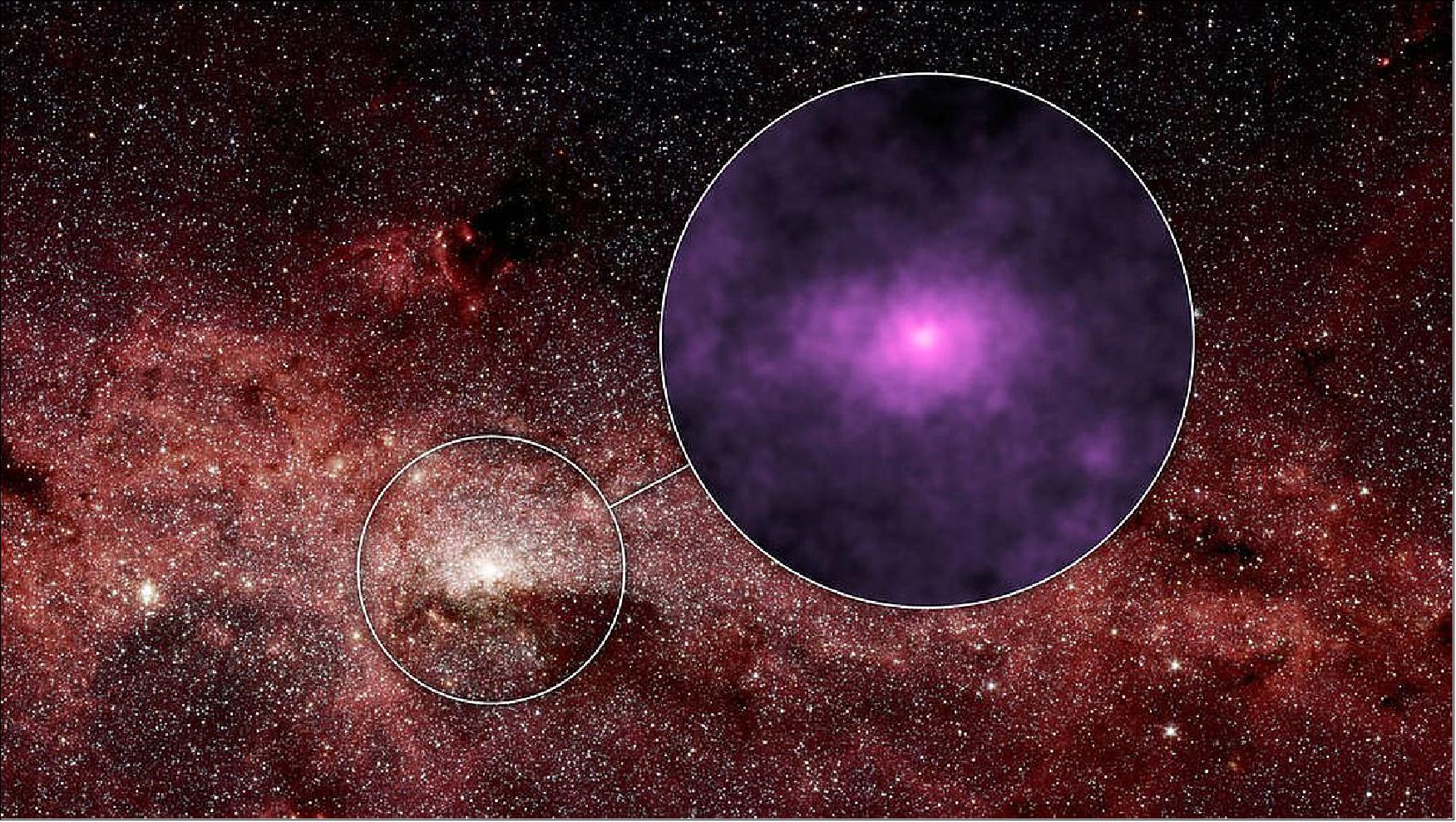
Legend to Figure 36: The NuSTAR picture is one of the most detailed ever taken of the center of our galaxy in high-energy X-rays. The X-ray light, normally invisible to our eyes, has been assigned the color magenta. The brightest point of light near the center of the X-ray picture is coming from a spinning dead star, known as a pulsar, which is near the giant black hole. While the pulsar's X-ray emissions were known before, scientists were surprised to find more high-energy X-rays than predicted in the surrounding regions, seen here as the elliptical haze. 45)
Astronomers aren't sure what the sources of the extra X-rays are, but one possibility is a population of dead stars. The background picture was captured in infrared light by NASA's Spitzer Space Telescope. The NuSTAR image has an X-ray energy range of 20 to 40 keV.
• Feb. 19, 2015: Astronomers have discovered that the NuSTAR and XMM-Newton missions of NASA and ESA, respectively, are showing that fierce winds from a supermassive black hole blow outward in all directions — a phenomenon that had been suspected, but difficult to prove until now. This discovery has given astronomers their first opportunity to measure the strength of these ultra-fast winds and prove they are powerful enough to inhibit the host galaxy’s ability to make new stars. 46) 47)
Supermassive black holes blast matter into their host galaxies, with X-ray emitting winds traveling at up to one-third the speed of light. In the new study, astronomers determined PDS 456, an extremely bright black hole known as a quasar more than 2 billion light-years away, sustains winds that carry more energy every second than is emitted by more than a trillion suns.
NuSTAR and XMM-Newton simultaneously observed PDS 456 on five separate occasions in 2013 and 2014. The space telescopes complement each other by observing different parts of the X-ray light spectrum: XMM-Newton views low-energy and NuSTAR views high-energy spectra.
Previous XMM-Newton observations had identified black hole winds blowing toward us, but could not determine whether the winds also blew in all directions. XMM-Newton had detected iron atoms, which are carried by the winds along with other matter, only directly in front of the black hole, where they block X-rays. Combining higher-energy X-ray data from NuSTAR with observations from XMM-Newton, scientists were able to find signatures of iron scattered from the sides, proving the winds emanate from the black hole not in a beam, but in a nearly spherical fashion.
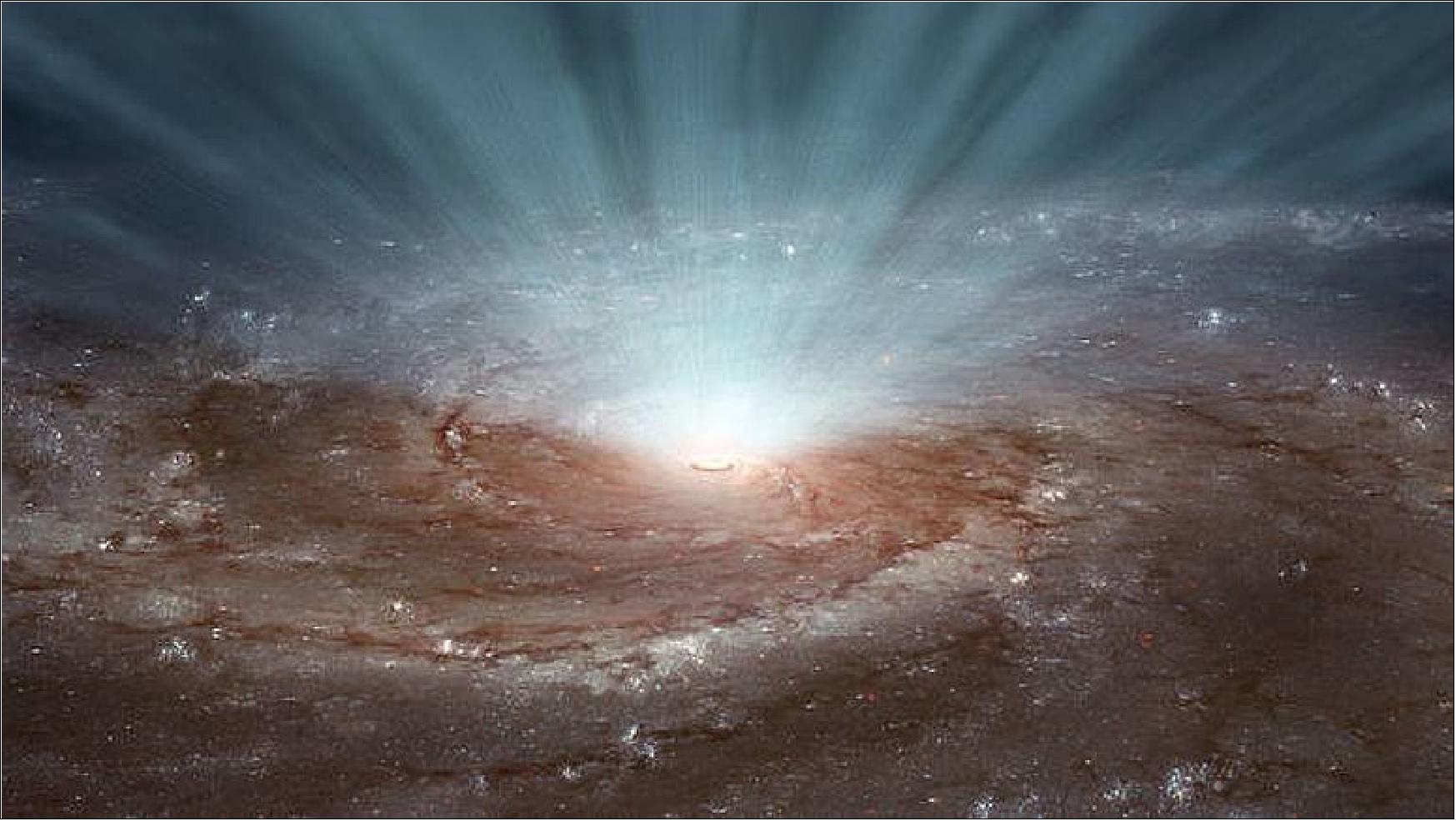
The data plot of Figure 38 from NuSTAR and XMM-Newton determines for the first time the shape of ultra-fast winds from supermassive black holes, or quasars. The winds blow in every direction, in a nearly spherical fashion, coming from both sides of a galaxy (only one side is shown in the artist's impression here). 48)
The plot shows the brightness of X-ray light from an extremely luminous quasar called PDS 456, with the highest-energy rays on the right. XMM-Newton sees the lower-energy X-rays, and NuSTAR the higher ones. XMM Newton had previously observed PDS 456 in 2001. At that time, it had measured the X-rays up to an energy level of 11 keV. From those data, researchers detected a dip in the X-ray light, called an absorption feature (see dip in plot). The dip is caused by iron atoms – which are carried by the winds along with other matter – absorbing the X-ray light of a particular energy. What's more, the absorption feature is 'blue-shifted," meaning that the winds are speeding toward us.
These data told researchers that at least some of the winds were blowing toward us – but they didn't reveal whether those winds were confined to a narrow beam along our line of sight, or were blowing in all directions. That's because XMM-Newton had only detected absorption features, which by definition occur in front of a light source, in this case, the quasar. To probe what was happening at the other sides of the quasar, the astronomers needed to find an emission feature, which would indicate that the iron was scattering X-ray light at a particular energy in all directions, not only toward the observer.
NuSTAR and XMM-Newton teamed up to observe PDS 456 simultaneously in 2013 and 2014, and the results of that campaign are shown in this plot. NuSTAR data are represented as orange circles and XMM-Newton as blue squares. The NuSTAR data reveal the baseline of the "continuum" quasar light (see gray line) – or what the quasar would look like without any winds. What stands out is the bump to the left of the dips. That is an iron emission signature, the telltale sign that the black-hole winds blow to the sides and in all directions.
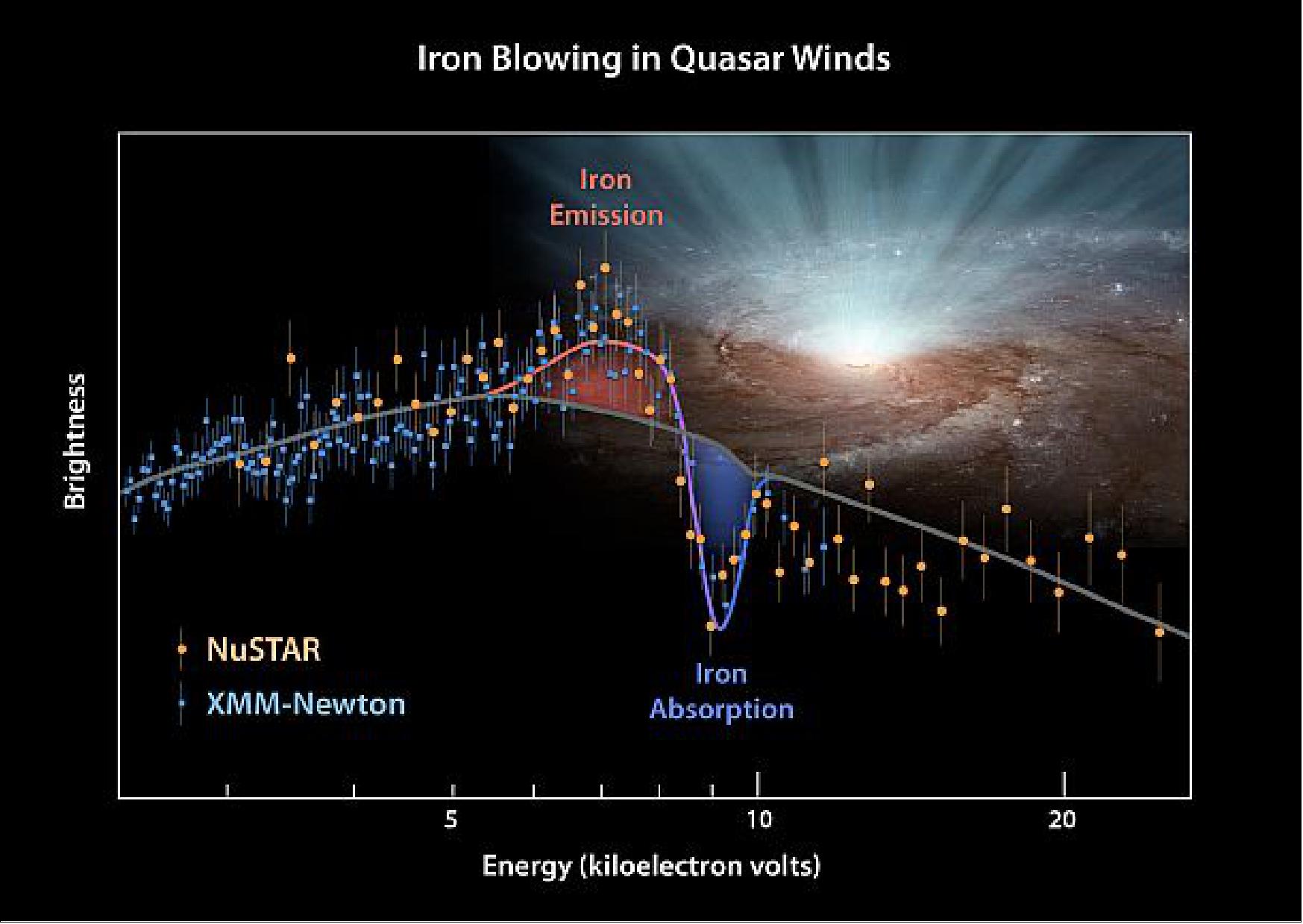
• Dec. 22, 2014: For the first time, a mission designed to set its eyes on black holes and other objects far from our solar system has turned its gaze back closer to home, capturing images of our sun. NASA's NuSTAR has taken its first picture of the sun, producing the most sensitive solar portrait ever taken in high-energy X-rays. 49) 50) 51)
- While the sun is too bright for other telescopes such as NASA's Chandra X-ray Observatory, NuSTAR can safely look at it without the risk of damaging its detectors. This first solar image from NuSTAR demonstrates that the telescope can in fact gather data about sun. And it gives insight into questions about the remarkably high temperatures that are found above sunspots — cool, dark patches on the sun. Future images will provide even better data as the sun winds down in its solar cycle.
- With NuSTAR's high-energy views, it has the potential to capture hypothesized nanoflares — smaller versions of the sun's giant flares that erupt with charged particles and high-energy radiation. Nanoflares, should they exist, may explain why the sun's outer atmosphere, called the corona, is sizzling hot, a mystery called the "coronal heating problem." The corona is, on average 1 million degrees Celsius, while the surface of the sun is relatively cooler at 6,000 degrees Celsius. It is like a flame coming out of an ice cube. Nanoflares, in combination with flares, may be sources of the intense heat.
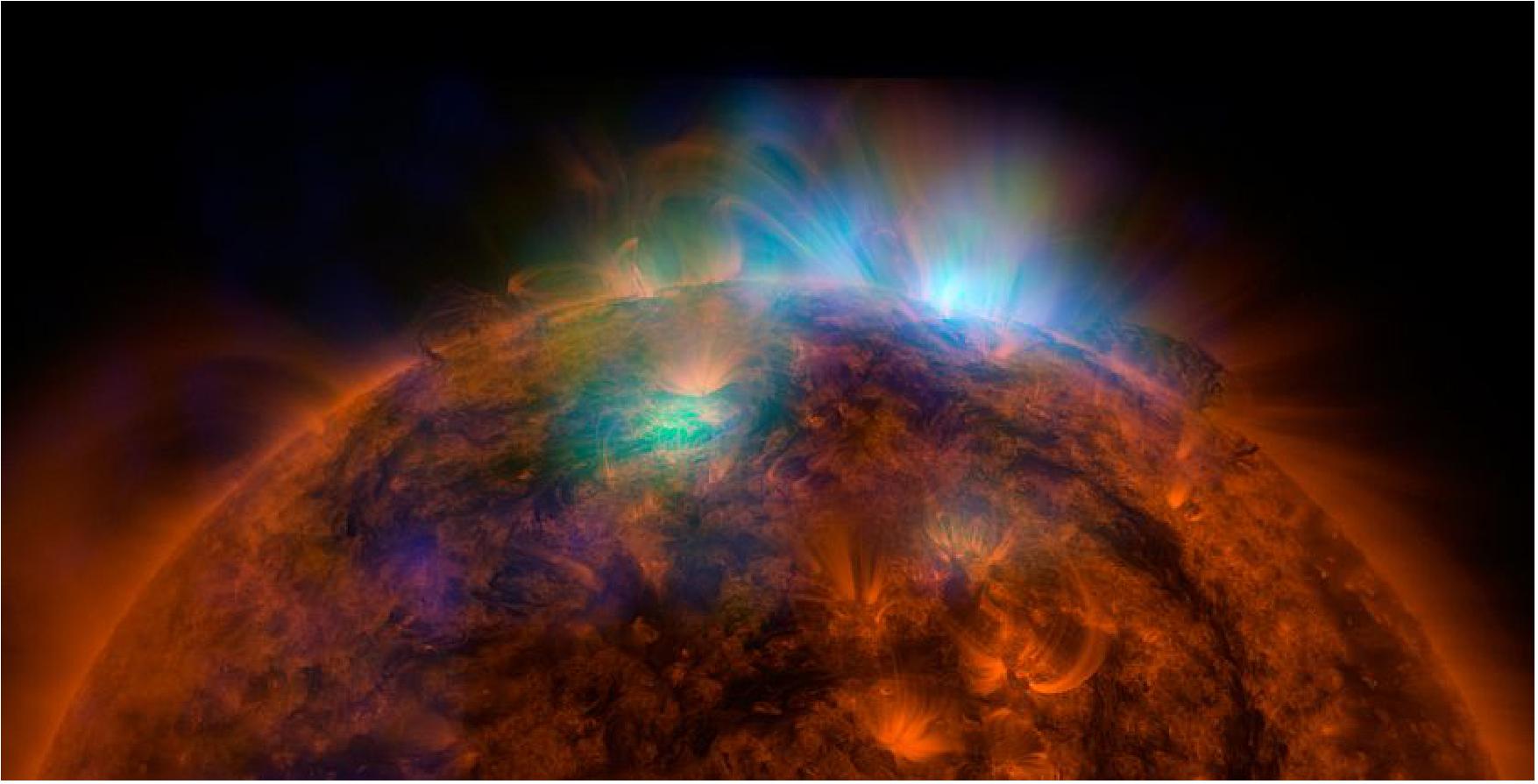
Legend to Figure 39: This is the first picture of the sun taken by NuSTAR. The field of view covers the west limb of the sun. The NuSTAR data, seen in green and blue, reveal solar high-energy emission (green shows energies between 2 and 3 keV volts, and blue shows energies between 3 and 5 keV). The high-energy X-rays come from gas heated to above 3 million degrees. The red channel represents ultraviolet light captured by SDO at wavelengths of 171 Å, and shows the presence of lower-temperature material in the solar atmosphere at 1 million degrees. - This image shows that some of the hotter emission tracked by NuSTAR is coming from different locations in the active regions and the coronal loops than the cooler emission shown in the SDO image.
• October 8, 2014: A research team led by Caltech astronomers of Pasadena California have found a pulsating, dead star beaming with the energy of about 10 million suns. This is the brightest pulsar – a dense stellar remnant left over from a supernova explosion – ever recorded. The discovery was made with NASA's NuSTAR (Nuclear Spectroscopic Telescope Array). 52) 53) 54) 55)
- The surprising find is helping astronomers better understand mysterious sources of blinding X-rays, called ULXs (Ultraluminous X-ray sources). Until now, all ULXs were thought to be black holes. The new data from NuSTAR show at least one ULX, about 12 million light years away in the galaxy Messier 82 (M82), is actually a pulsar.
ULXs are generally thought to be black holes feeding off companion stars — a process called accretion. They also are suspected to be the long-sought after "medium-size" black holes – missing links between smaller, stellar-size black holes and the gargantuan ones that dominate the hearts of most galaxies. But research into the true nature of ULXs continues toward more definitive answers.
NuSTAR did not initially set out to study the two ULXs in M82. Astronomers had been observing a recent supernova in the galaxy when they serendipitously noticed pulses of bright X-rays coming from the ULX known as M82 X-2. Black holes do not pulse, but pulsars do.
- The key to NuSTAR's discovery was its sensitivity to high-energy X-rays, as well as its ability to precisely measure the timing of the signals, which allowed astronomers to measure a pulse rate of 1.37 seconds. They also measured its energy output at the equivalent of 10 million suns, or 10 times more than that observed from other X-ray pulsars. This is a big punch for something about the mass of our sun and the size of Pasadena.
Astronomers are planning follow-up observations with NASA's NuSTAR, Swift and Chandra spacecraft to find an explanation for the pulsar's bizarre behavior. The NuSTAR team also will look at more ULXs, meaning they could turn up more pulsars. At this point, it is not clear whether M82 X-2 is an oddball or whether more ULXs beat with the pulse of dead stars. NuSTAR, a relatively small telescope, has thrown a big loop into the mystery of black holes.
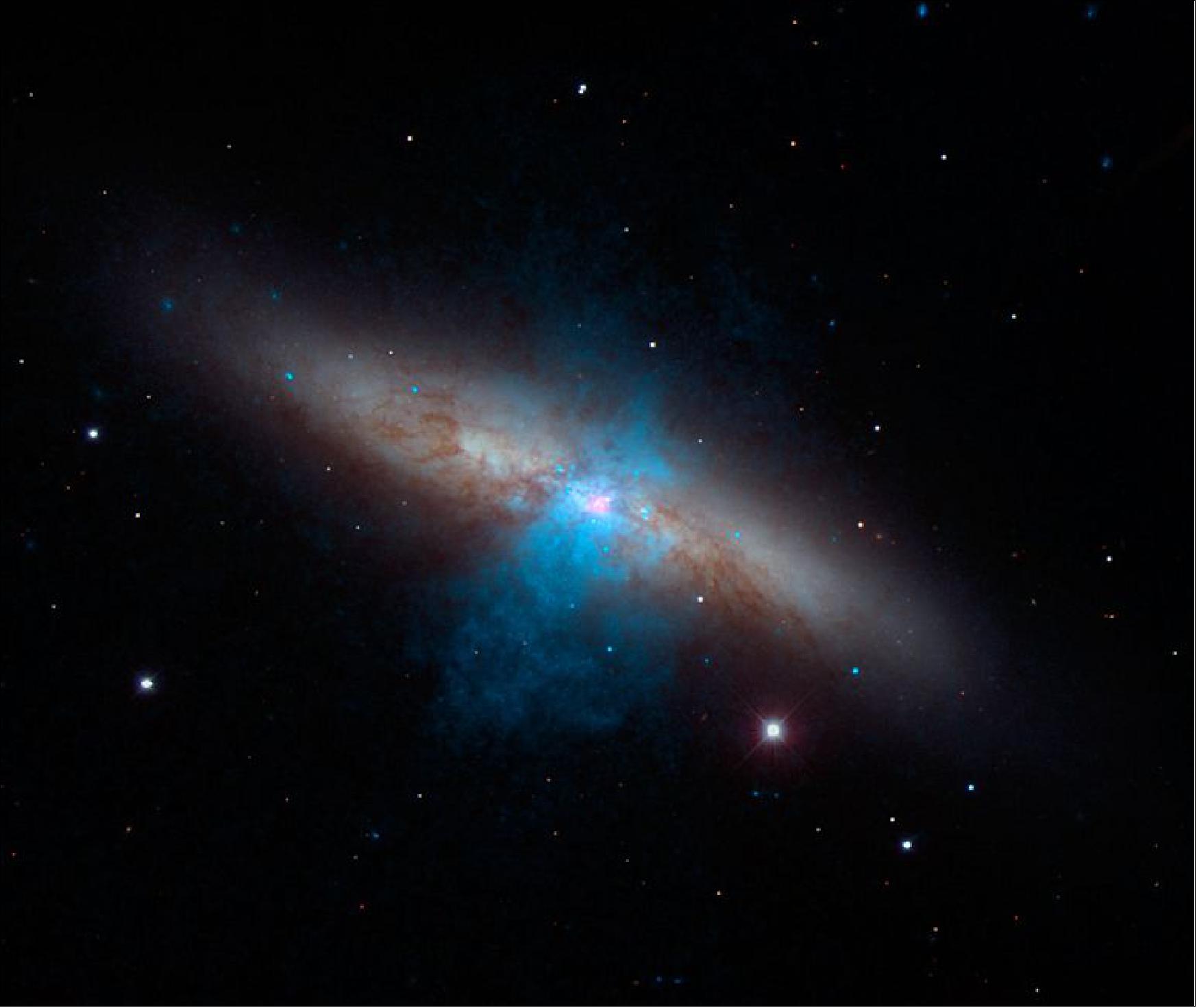
• August 12, 2014: NuSTAR has captured an extreme and rare event in the regions immediately surrounding a supermassive black hole. A compact source of X-rays that sits near the black hole, called the corona, has moved closer to the black hole over a period of just days. The corona recently collapsed in toward the black hole, with the result that the black hole's intense gravity pulled all the light down onto its surrounding disk, where material is spiraling inward. 56)
- As the corona shifted closer to the black hole, the gravity of the black hole exerted a stronger tug on the X-rays emitted by it. The result was an extreme blurring and stretching of the X-ray light. Such events had been observed previously, but never to this degree and in such detail. Supermassive black holes are thought to reside in the centers of all galaxies. Some are more massive and rotate faster than others. The black hole in this new study, referred to as Markarian 335, or Mrk 335, is about 324 million light-years from Earth in the direction of the Pegasus constellation. It is one of the most extreme of the systems for which the mass and spin rate have ever been measured. The black hole squeezes about 10 million times the mass of our sun into a region only 30 times the diameter of the sun, and it spins so rapidly that space and time are dragged around with it.
- The data plot of Figure 41, captured by NuSTAR, shows X-ray light streaming from regions near a supermassive black hole known as Markarian 335. The light is coming from two areas: a superheated disk of material feeding the black hole, called the accretion disk; and a cloud of particles traveling near the speed of light, called the corona. The exact shape and nature of coronas are not clear, but researchers know that X-ray light from the corona is reflected off the accretion disk.
That reflected light, and the corona's direct light, are mapped in this plot over a range of X-ray energies. (This is the highest range of X-rays, which NuSTAR was specially designed to see.) The yellow line is a model that shows what the data are predicted to look like if X-ray light has been stretched, or blurred. The blue line shows what the plot would look like without the blurring effects. The white dots show the actual NuSTAR data, indicating the light is extremely blurred.
What's blurring the light? It's a combination of factors. First, there is a Doppler shift happening due to the spinning disk. As one side of the disk moves toward us and the other side away, the light is squeezed or stretched. A second effect has to do with the enormous speeds of the spinning black hole, which approach the speed of light. A final effect is from the enormous gravity of the black hole, which pulls on the light, making it harder to escape its grasp. The light loses energy in this process. All of these factors contribute to the smeared look of the data as seen in the plot.
These data were taken after a dramatic dip in brightness had first been observed by NASA's Swift satellite. NuSTAR's high-energy X-ray data pointed to the cause for the observed change: Markarian 335's corona had shifted closer to the black hole itself — and this closer proximity meant that the black hole's gravity could yank harder on the corona's light, stretching it to lower energies than observed before. The astronomers say that the corona moved over a period of days, and is still in the close configuration. They don't know if and when it would move back to where it was previously, or why the corona moved. NuSTAR and other high-energy telescopes are busy trying to crack these mysteries (Ref. 56).
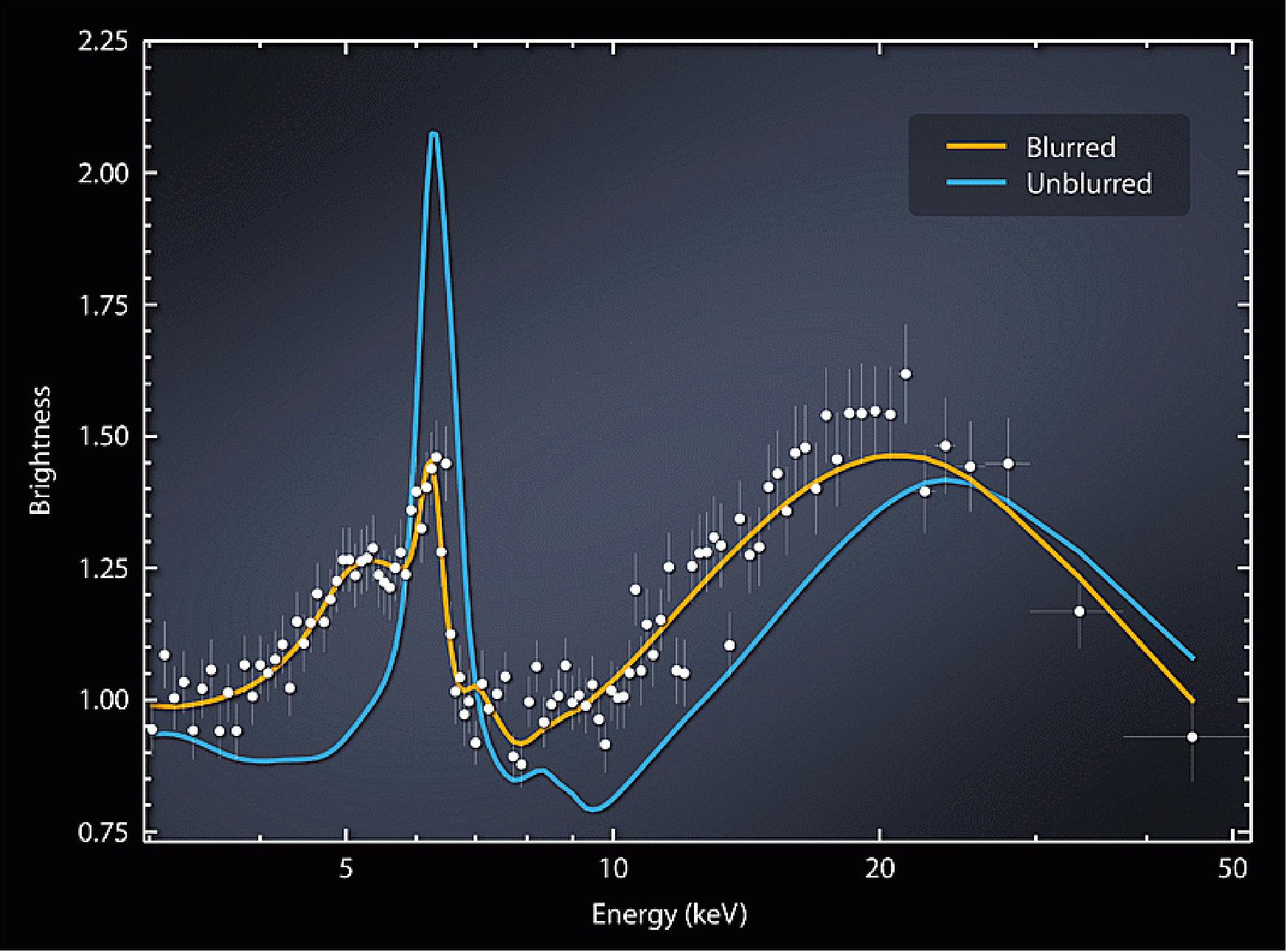
• February 19, 2014: NuSTAR has created the first map of radioactive material in a supernova remnant. The results, from a remnant named Cassiopeia A (Cas A), reveal how shock waves likely rip apart massive dying stars. 57) 58) 59)
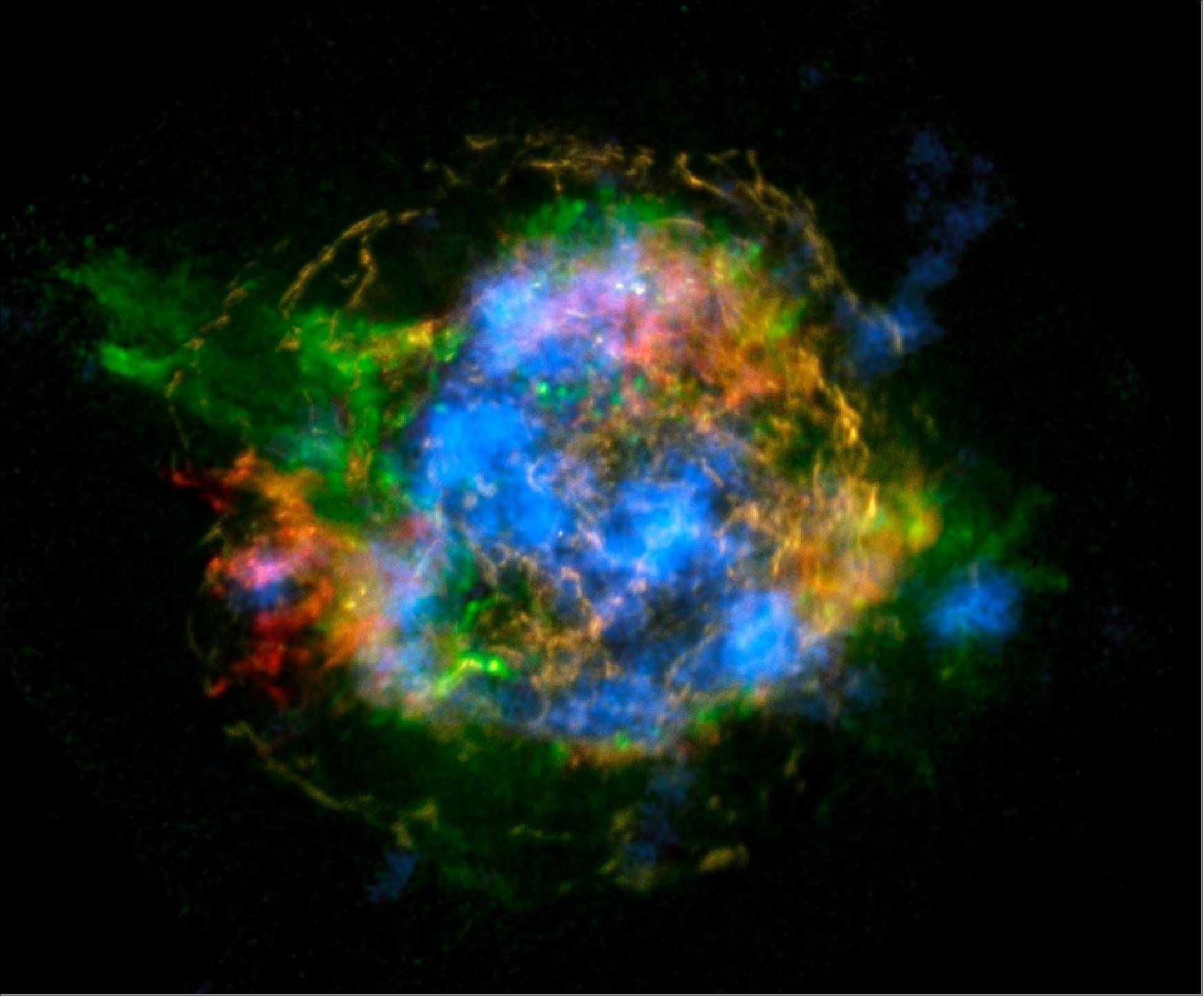
Legend to Figure 42: The mystery of how Cassiopeia A exploded is unraveling thanks to new data from NASA's NuSTAR. In this image, NuSTAR data, which show high-energy X-rays from radioactive material, are colored blue. Lower-energy X-rays from non-radioactive material, imaged previously with NASA's Chandra X-ray Observatory, are shown in red, yellow and green. The new view shows a more complete picture of Cassiopeia A, the remains of a star that blew up in a supernova event whose light reached Earth about 350 years ago, when it could have appeared to observers as a star that suddenly brightened. The remnant is located 11,000 light-years away from Earth.
NuSTAR is the first telescope capable of taking detailed pictures of the radioactive material in the Cassiopeia A supernova remnant. While other telescopes have detected radioactivity in these objects before, NuSTAR is the first capable of pinpointing the location of the radioactivity, creating maps. When massive star explode, they create many elements: non-radioactive ones like iron and calcium found in your blood and bones; and radioactive elements like titanium-44, the decay of which sends out high-energy X-ray light that NuSTAR can see.
By mapping titanium-44 in Cassiopeia A, astronomers get a direct look at what happened in the core of the star when it was blasted to smithereens. These NuSTAR data complement previous observations made by Chandra, which show elements, such as iron, that were heated by shock waves farther out from the remnant's center.
In this image, the red, yellow and green data were collected by Chandra at energies ranging from 1 to 7 keV. The red color shows heated iron, and green represents heated silicon and magnesium. The yellow is what astronomers call continuum emission, and represents a range of X-ray energies. The titanium-44, shown in blue, was detected by NuSTAR at energies ranging between 68 and 78 keV (Ref. 57).
• January 2014: NuSTAR is now executing its primary science mission, and with an expected orbit lifetime of 10 years, the project anticipates proposing a guest investigator program, to begin in late 2014 (Ref. 79).
• January 2014: NuSTAR's unique viewpoint, in seeing the highest-energy X-rays, is showing the project well-studied objects and regions in a whole new light. Figure 43of NuSTAR shows the energized remains of a dead star, a structure nicknamed the "Hand of God" after its resemblance to a hand. 60) 61)
- The new "Hand of God" image shows a nebula 17,000 light years away, powered by a dead, spinning star called PSR B1509-58, or B1509 for short. The dead star, called a pulsar, is the leftover core of a star that exploded in a supernova. The pulsar is only about 19 km in diameter but packs a big punch: it is spinning around nearly seven times every second, spewing particles into material that was upheaved during the star's violent death. These particles are interacting with magnetic fields around the ejected material, causing it to glow with X-rays. The result is a cloud that, in previous images, looked like an open hand. - One of the big mysteries of this object, called a pulsar wind nebula, is whether the pulsar's particles are interacting with the material in a specific way to make it appear as a hand, or if the material is in fact shaped like a hand.
- With approximately 10 times greater spatial resolution and more than 100 times greater sensitivity than previous missions in this energy band, NuSTAR has opened the high-energy sky to sensitive study. Over the first year of the mission, NuSTAR has undertaken a range of studies, from observations of energetic events towards the center of the Milky Way galaxy to detailed studies of distant supermassive black holes. 62)
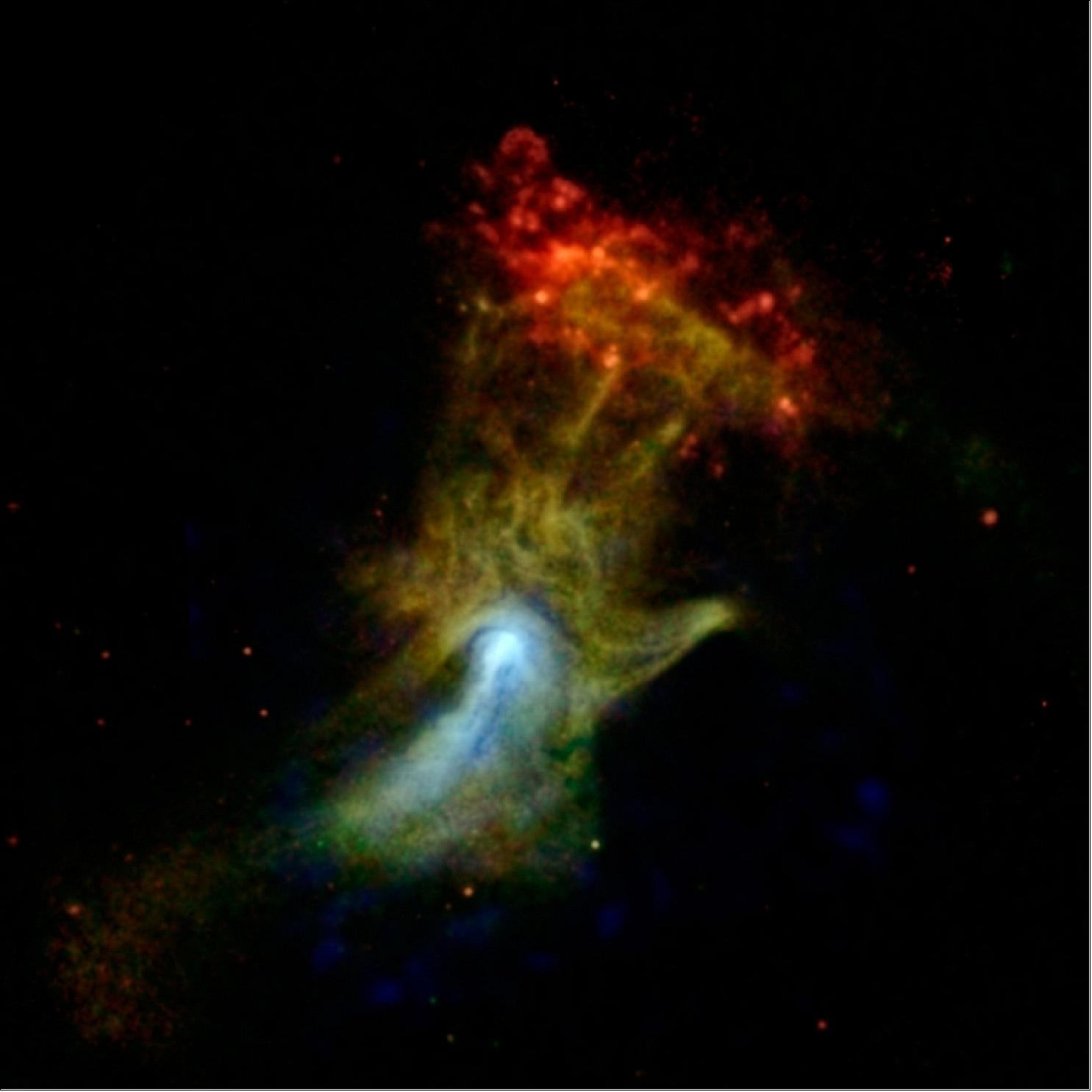
Legend to Figure 43: NuSTAR has imaged the structure in high-energy X-rays for the first time, shown in blue. Lower-energy X-ray light, previously detected by NASA's Chandra X-ray Observatory, is shown in green and red. NuSTAR's view is providing new clues to the puzzle. The hand actually shrinks in the NuSTAR image, looking more like a fist, as indicated by the blue color. The northern region, where the fingers are located, shrinks more than the southern part, where a jet lies, implying the two areas are physically different. The red cloud at the end of the finger region is a different structure, called RCW 89. Astronomers think the pulsar's wind is heating the cloud, causing it to glow with lower-energy X-ray light.
In this image, X-ray light seen by Chandra with energy ranges of 0.5 to 2 keV and 2 to 4 keV is shown in red and green, respectively, while X-ray light detected by NuSTAR in the higher-energy range of 7 to 25 keV is blue.
• August 29, 2013: NuSTAR is giving the wider astronomical community a first look at its unique X-ray images of the cosmos. The first batch of data from the black-hole hunting telescope is publicly available today, Aug. 29, via NASA's HEASARC (High Energy Astrophysics Science Archive Research Center). 63)
- The images, taken from July to August 2012, shortly after the spacecraft launched, comprise an assortment of extreme objects, including black holes near and far. The more distant black holes are some of the most luminous objects in the universe, radiating X-rays as they ferociously consume surrounding gas. One type of black hole in the new batch of data is a blazar, which is an active, supermassive black hole pointing a jet toward Earth. Systems known as X-ray binaries, in which a compact object such as a neutron star or black hole feeds off a stellar companion, are also in the mix, along with the remnants of stellar blasts called supernovas.
• Feb. 27, 2013: Two X-ray space observatories, NASA's NuSTAR and the ESA's XMM-Newton missions, have teamed up to measure definitively, for the first time, the spin rate of a black hole with a mass 2 million times that of our sun. 64)
The supermassive black hole lies at the dust- and gas-filled heart of a galaxy called NGC 1365, and it is spinning almost as fast as Einstein's theory of gravity will allow. The observations also are a powerful test of Einstein's theory of general relativity, which says gravity can bend space-time, the fabric that shapes our universe, and the light that travels through it.
NuSTAR is designed to detect the highest-energy X-ray light in great detail. It complements telescopes that observe lower-energy X-ray light, such as XMM-Newton and NASA's Chandra X-ray Observatory. Scientists use these and other telescopes to estimate the rates at which black holes spin (Figure 45).
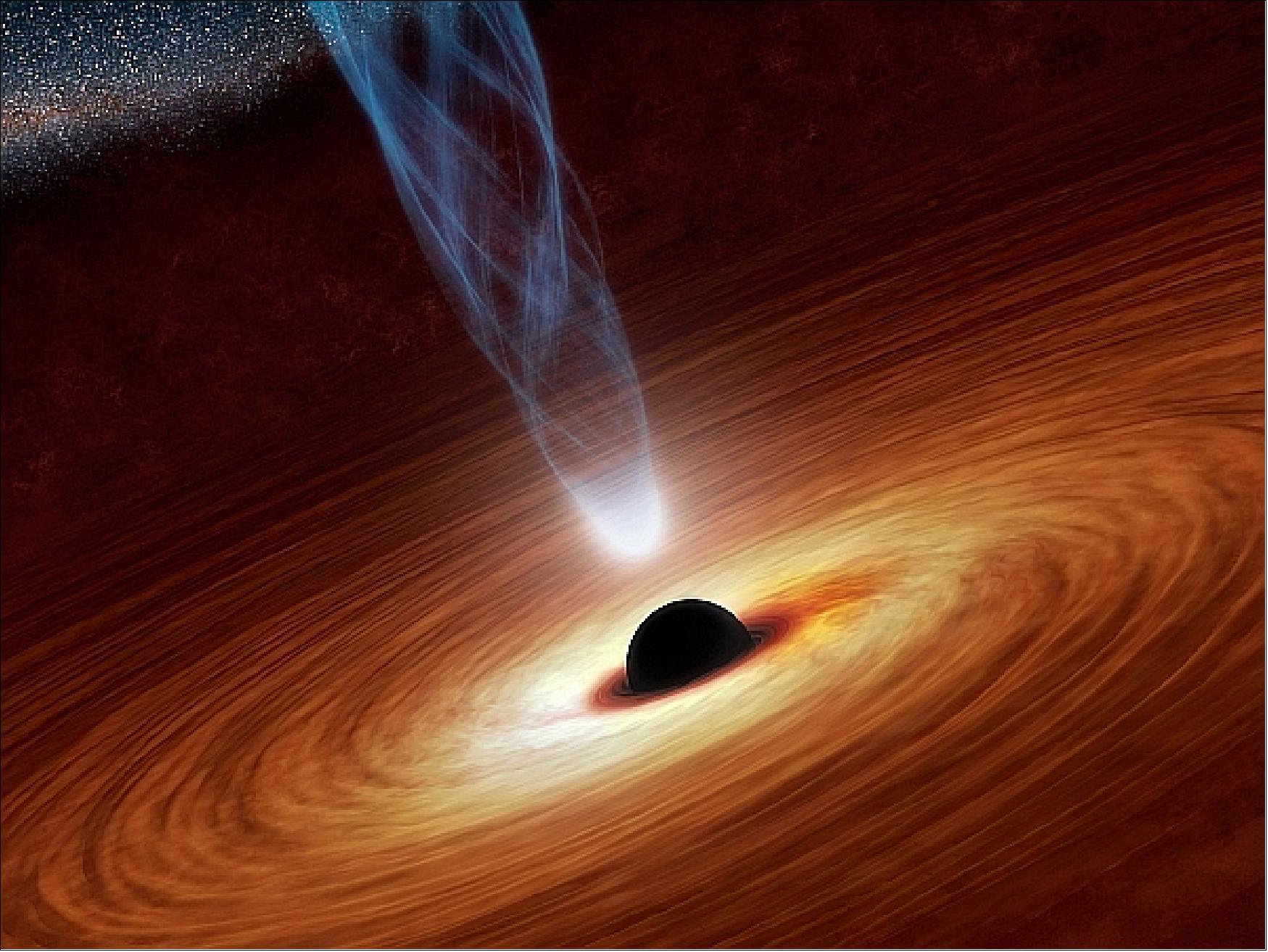
Until now, these measurements were not certain because clouds of gas could have been obscuring the black holes and confusing the results. With help from XMM-Newton, NuSTAR was able to see a broader range of X-ray energies and penetrate deeper into the region around the black hole. The new data demonstrate that X-rays are not being warped by the clouds, but by the tremendous gravity of the black hole. This proves that spin rates of supermassive black holes can be determined conclusively. Measuring the spin of a supermassive black hole is fundamental to understanding its past history and that of its host galaxy.
Supermassive black holes are surrounded by pancake-like accretion disks, formed as their gravity pulls matter inward. Einstein's theory predicts the faster a black hole spins, the closer the accretion disk lies to the black hole. The closer the accretion disk is, the more gravity from the black hole will warp X-ray light streaming off the disk (Ref. 64).
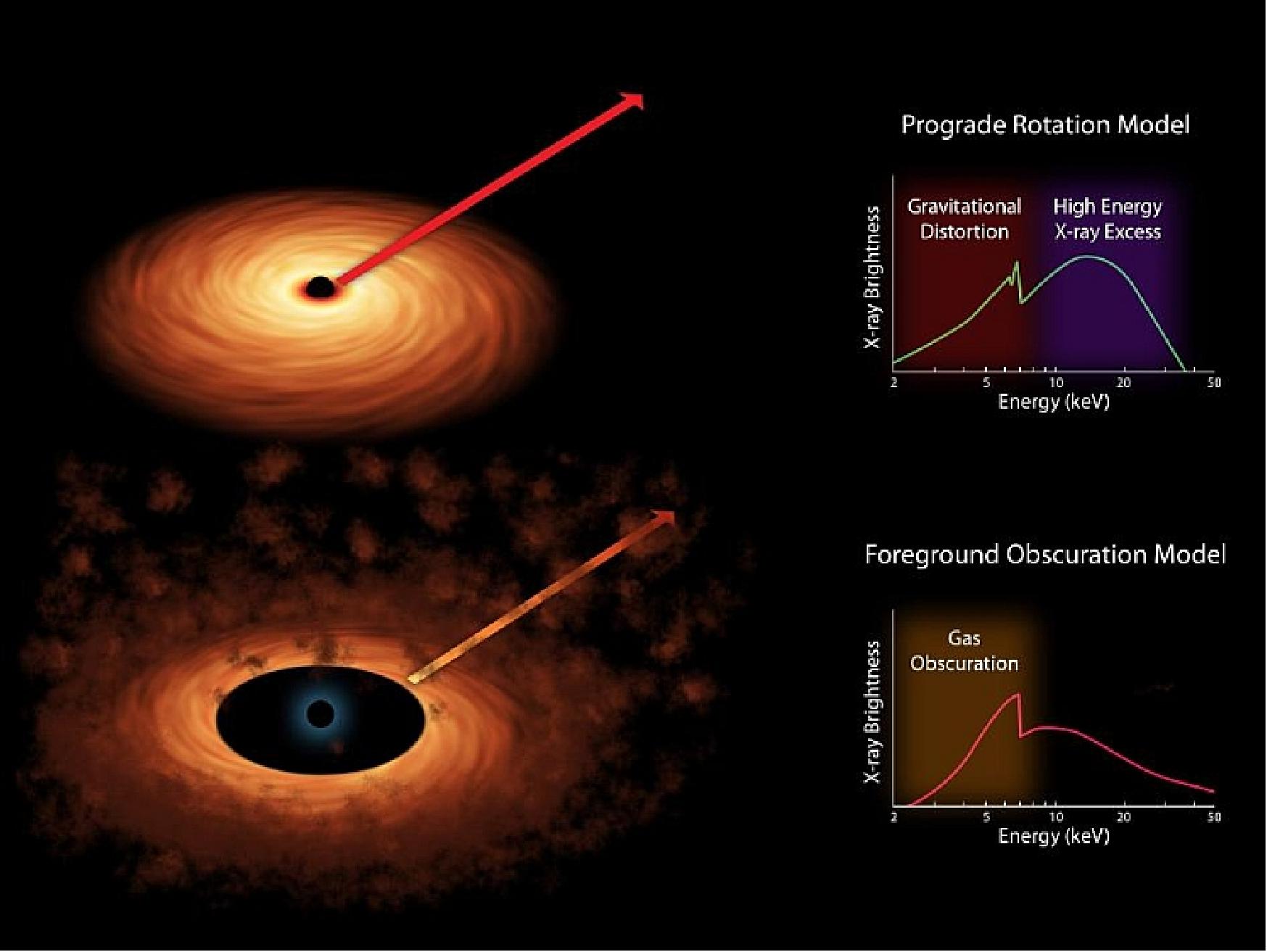
Legend to Figure 45: Scientists measure the spin rates of supermassive black holes by spreading the X-ray light into different colors. The light comes from accretion disks that swirl around black holes, as shown in both of the artist's concepts. They use X-ray space telescopes to study these colors, and, in particular, look for a "fingerprint" of iron — the peak shown in both graphs, or spectra — to see how sharp it is. Prior to observations with NASA's NuSTAR (Spectroscopic Telescope Array), and the European Space Agency's XMM-Newton telescope, there were two competing models to explain why this peak might not appear to be sharp.
The "rotation" model shown at top of Figure 45 held that the iron feature was being spread out by distorting effects caused by the immense gravity of the black hole. If this model were correct, then the amount of distortion seen in the iron feature should reveal the spin rate of the black hole.
The alternate model held (bottom of Figure 45) that obscuring clouds lying near the black hole were making the iron line appear artificially distorted. If this model were correct, the data could not be used to measure black hole spin.
NuSTAR helped to solve the case, ruling out the alternate "obscuring cloud" model. Its high-energy X-ray data — shown at top as green bump to the right of the peak — revealed that features in the X-ray spectrum are in fact coming from the accretion disk and not from the obscuring clouds. Together with XMM-Newton, the space observatories were able to make the first conclusive measurement of a black hole's spin rate, and more generally, confirm that the "gravitational distortion" model is accurate (Ref. 64). 65)
The solid lines of Figure 46 show two theoretical models that explain low-energy X-ray emission seen previously from the spiral galaxy NGC 1365 by XMM-Newton. The red line explains the emission using a model where clouds of dust and gas partially block the X-ray light, and the green line represents a model in which the emission is reflected off the inner edge of the accretion disk, very close to the black hole. 66)
The blue circles show the latest measurements from XMM-Newton, and the yellow circles show the data from NuSTAR. While both models fit the XMM-Newton data equally well, only the disk reflection model fits the NuSTAR data.
The results show that the iron feature, the sharp peak at left, is being affected black hole's immense gravity and not intervening clouds. The degree to which the iron feature is spread out reveals the spin rate of the black hole.
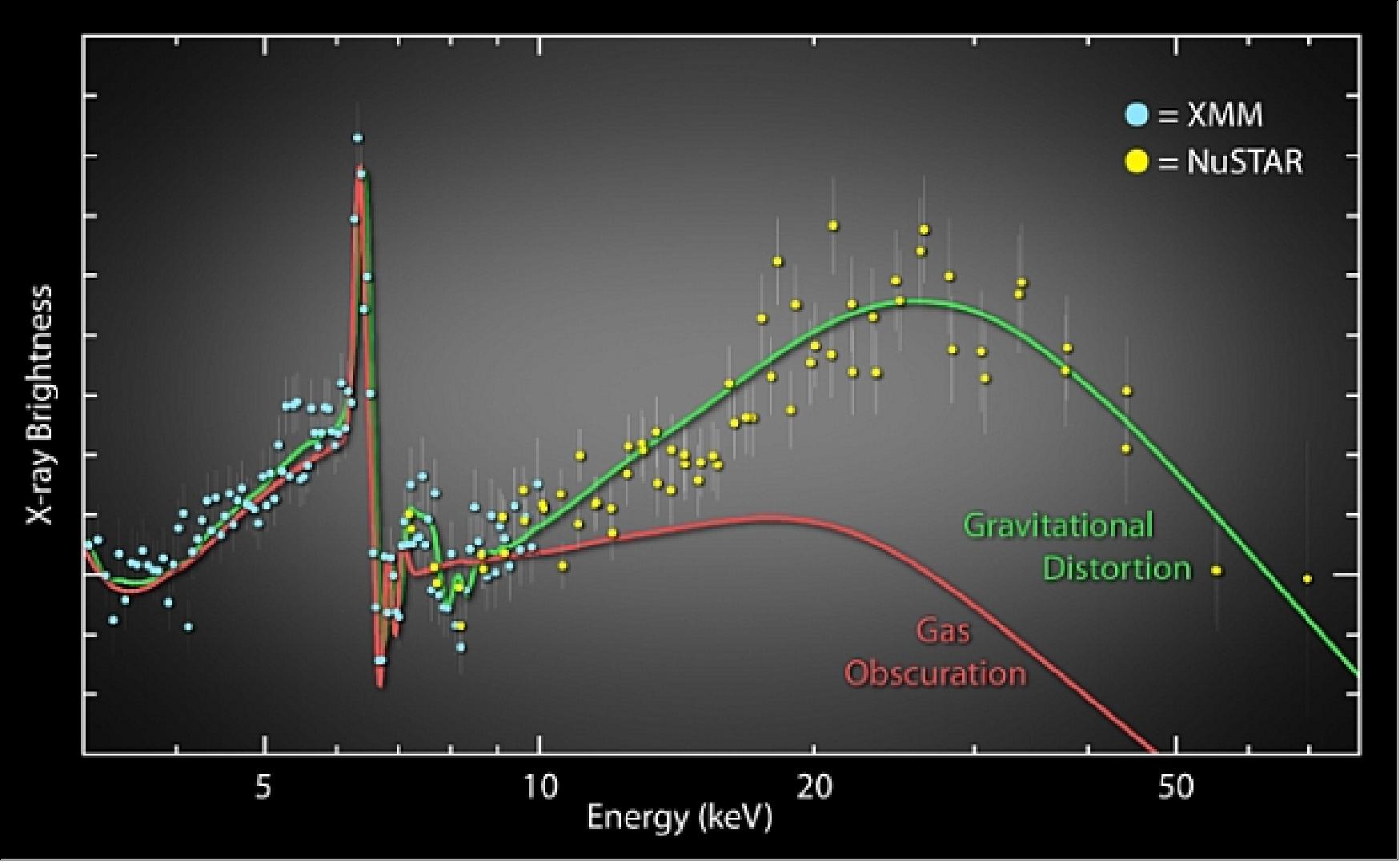
• Feb. 21, 2013: NuSTAR has been in orbit around Earth for more than eight months since its launch in June 2012, studying black holes and probing the nature of the high-energy X-ray universe. Mission and science operations have settled down into a mostly predictable daily routine, and the science team is making good progress toward achieving the primary, or "Level 1," science goals. Examples of some of the key NuSTAR observations performed to date include mapping of the central regions of our Milky Way galaxy, studying the remnants of exploded stars in our galaxy, and surveys of several well-studied extragalactic fields. 67)
• January 2013: Since launch, the NuSTAR team has been fine-tuning the telescope. The mission has looked at a range of extreme, high-energy objects already, including black holes near and far, and the incredibly dense cores of dead stars. In addition, NuSTAR has begun black-hole searches in the inner region of the Milky Way galaxy and in distant galaxies in the universe. 68) 69)
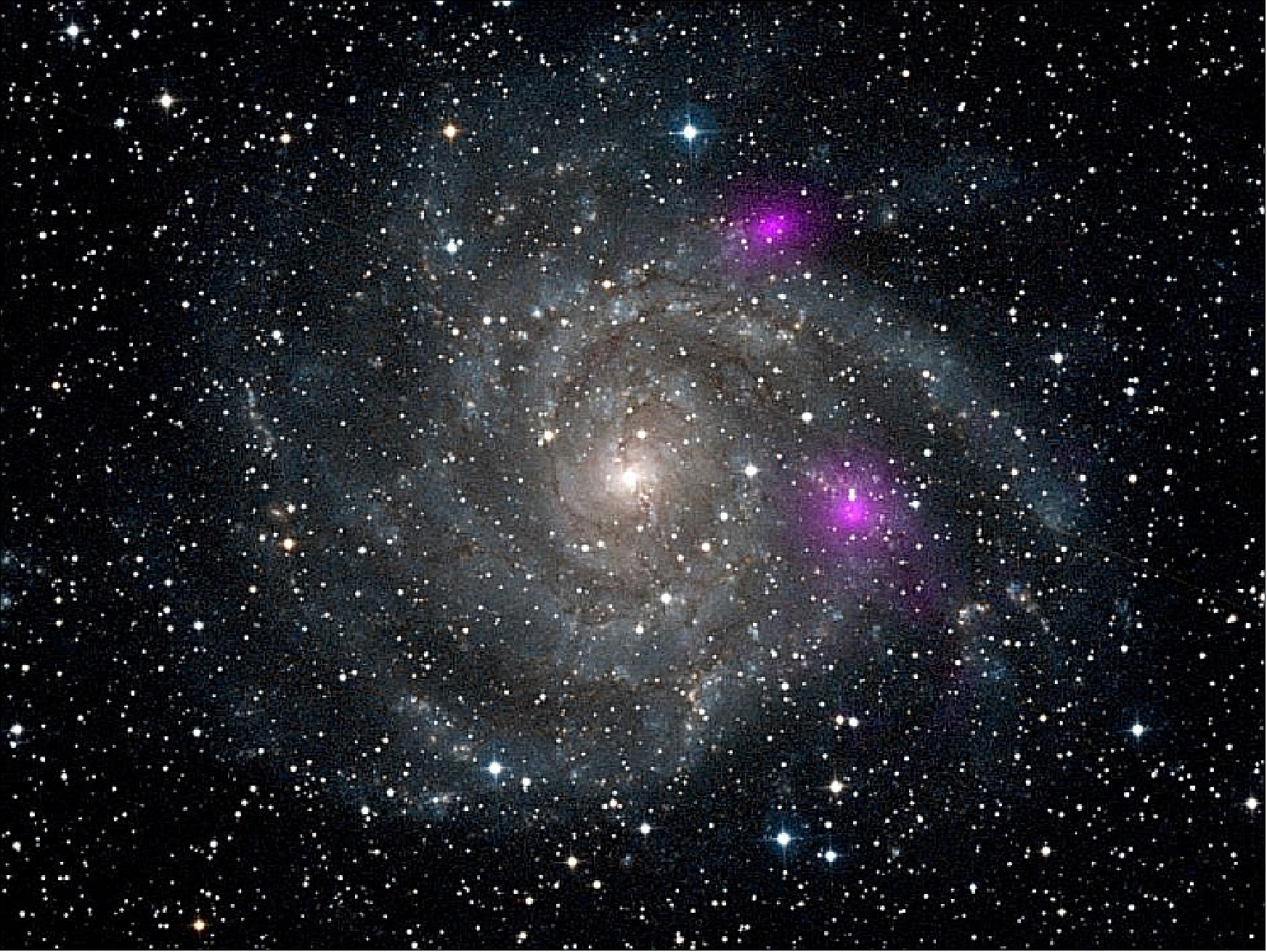
Legend to Figure 47: This new view of spiral galaxy IC 342, also known as Caldwell 5, includes data from NASA's NuSTAR spacecraft. High-energy X-ray data from NuSTAR have been translated to the color magenta, and superimposed on a visible-light view highlighting the galaxy and its star-studded arms. NuSTAR is the first orbiting telescope to take focused pictures of the cosmos in high-energy X-ray light; previous observations of this same galaxy taken at similar wavelengths blurred the entire object into one pixel.
The two magenta spots are blazing black holes first detected at lower-energy X-ray wavelengths by NASA's Chandra X-ray Observatory. With NuSTAR's complementary data, astronomers can start to home in on the black holes' mysterious properties. The black holes appear much brighter than typical stellar-mass black holes, such as those that pepper our own galaxy, yet they cannot be supermassive black holes or they would have sunk to the galaxy’s center. Instead, they may be intermediate in mass, or there may be something else going on to explain their extremely energetic state. NuSTAR will help solve this puzzle.
The image (Figure 47) shows NuSTAR X-ray data taken at 10 to 35 keV. The visible-light image is from the Digitized Sky Survey.
• November 2012: The first three months of science, or "Phase E," operations have been a busy time for NASA's NuSTAR. Since the science operations began on August 1, 2012, the NuSTAR team has wrestled with learning to point the telescope's flexible system of optics, mast, spacecraft bus and solar array. Characterization of the behavior of NuSTAR in space took an additional six weeks, but has now been completed. Several adjustments to attitude control parameters — factors in pointing the telescope — were necessary to bring the spacecraft into the required specifications, and the satellite's slew rate, or the speed at which it points to new targets, has recently been enhanced by a factor of two. 70)
Calibrating the telescope is now a primary focus for the science team. NuSTAR has made a number of coordinated observations of famous, bright X-ray sources like the Crab nebula, Hercules X-1, 3C 273 and IC 4329A. The first two are neutron stars in our Milky Way galaxy, and the latter two are accreting black holes in the centers of nearby galaxies. These coordinated calibration campaigns have been done with many of the low- and high-energy X-ray astronomical satellites currently in orbit: NASA's Chandra X-ray and Swift observatories, ESA's (European Space Agency's) XMM-Newton and INTEGRAL telescopes, and JAXA's (Japan Aerospace Exploration Agency's) Suzaku.
• On June 28, 2012, NuSTAR has taken its first snapshots of the highest energy X-rays in the cosmos. The first images from the observatory show Cygnus X-1, a black hole in our galaxy that is siphoning gas off a giant-star companion. This particular black hole was chosen as a first target because it is extremely bright in X-rays, allowing the NuSTAR team to easily see where the telescope's focused X-rays are falling on the detectors. 71)
• On June 21, 2012 (9 days after launch), NuSTAR successfully deployed its lengthy mast, giving it the ability to see the highest energy X-rays in the universe. 72)
The NuSTAR team will now begin to verify the pointing and motion capabilities of the satellite, and fine-tune the alignment of the mast. In about five days, the team will instruct NuSTAR to take its "first light" pictures, which are used to calibrate the telescope.
• Confirmation of the successful deployment of NuSTAR's solar arrays has been received. All systems are nominal. 73)
Sensor Complement
The instrument has the same name as the spacecraft. NuSTAR is based in large part on the technologies developed for the HEFT (High-Energy Focusing Telescope) balloon experiment. The NuSTAR instrument team is from the following institutions: Caltech, Columbia University, DTU (Danish Technical University), LLNL (Lawrence Livermore National Laboratory),NASA/GSFC (Goddard Space Flight Center), and UCB (University of California, Berkeley). 74) 75) 76) 77) 78)
NuSTAR operates in the band from 3 to 79 keV, extending the sensitivity of focusing far beyond the ~10 keV high-energy cutoff achieved by all previous X-ray satellites. The inherently low background associated with concentrating the X-ray light enables NuSTAR to probe the hard X-ray sky with a more than 100-fold improvement in sensitivity over the collimated or coded mask instruments that have operated in this bandpass. Using its unprecedented combination of sensitivity and spatial and spectral resolution, NuSTAR will pursue five primary scientific objectives: 79)
1) probe the obscured AGN (Active Galactic Ncleus) activity out to the peak epoch of galaxy assembly in the universe (at z <~ 2) by surveying selected regions of the sky
2) study the population of hard X-ray-emitting compact objects in the Galaxy by mapping the central regions of the Milky Way
3) study the non-thermal radiation in young supernova remnants, both the hard X-ray continuum and the emission from the radioactive element 44 Ti
4) observe blazars contemporaneously with ground-based radio, optical, and TeV telescopes, as well as with Fermi and Swift, to constrain the structure of AGN jets
5) observe line and continuum emission from core-collapse supernovae in the Local Group, and from nearby Type Ia events, to constrain explosion models. During its baseline two-year mission, NuSTAR will also undertake a broad program of targeted observations.
The NuSTAR instrument
Instrument: The NuSTAR instrument is the first astronomical telescope in orbit to utilize the new generation of hard X-ray optics and solid-state detector technologies to carry out high-sensitivity observations at X-ray energies significantly greater than 10 keV. It consists of two co-aligned depth-graded multilayer coated grazing incidence optics focused onto solid state CdZnTe pixel detectors with a focal length of 10.15 m. Figure 49 shows the total effective area for both telescopes as a function of energy, with a comparison to Chandra and XMM. The energy band extends from about 5 - 79 keV, being limited at the low-energy end by the optics thermal cover and shield entrance window, and at the high energy end by the K-edge (at 78.4 keV) in the Platinum mirror coatings.
For (focusing) X-ray telescopes, the standard metric for specifying angular resolution is the HPD (Half-Power Diameter), which is also called the HEW (Half-Energy Width). This is the angular diameter of the image of a point source, which contains half the flux (at a given energy) focused by the telescope. From the standpoint of detecting and measuring sources with an X-ray telescope, the HPD proves more useful than other imaging metrics—e.g., full width at FWHM (Full Width Half maximum) and RMS (Root-Mean-of Squares) image blur. However, the RMS is useful in formulating imaging error budgets for the geometric-optics terms that govern the PSF (Point Spread Function) core. 80)
Energy range | 5-79 keV |
Angular resolution (HPD) | 45 arcsec |
Angular resolution (FWHM) | 9.5 arcsec |
FOV (50% resp.) at 10 keV | 10 arcmin |
FOV (50% resp.) at 68 keV | 6 arcmin |
Sensitivity (6 - 10 keV) [106 s, 3σ, ΔE/E = 0.5] | 2 x 10-15 erg/cm2/s |
Sensitivity (10 - 30 keV) [106 s, 3σ, ΔE/E = 0.5] | 1 x 10-14 erg/cm2/s |
Background in HPD (10 - 30 keV) | 6:8 x 10-4 cts/s |
Background in HPD (30 - 60 keV) | 4.0 x 10-4 cts/s |
Spectral resolution (FWHM) | 500 eV at 10 keV, 1.2 keV at 80 keV |
Strong source (> 10σ) positioning | 1.5 arcsec (1σ) |
Temporal resolution | 2 µs |
Target of Opportunity (ToO) response | < 24 hours |
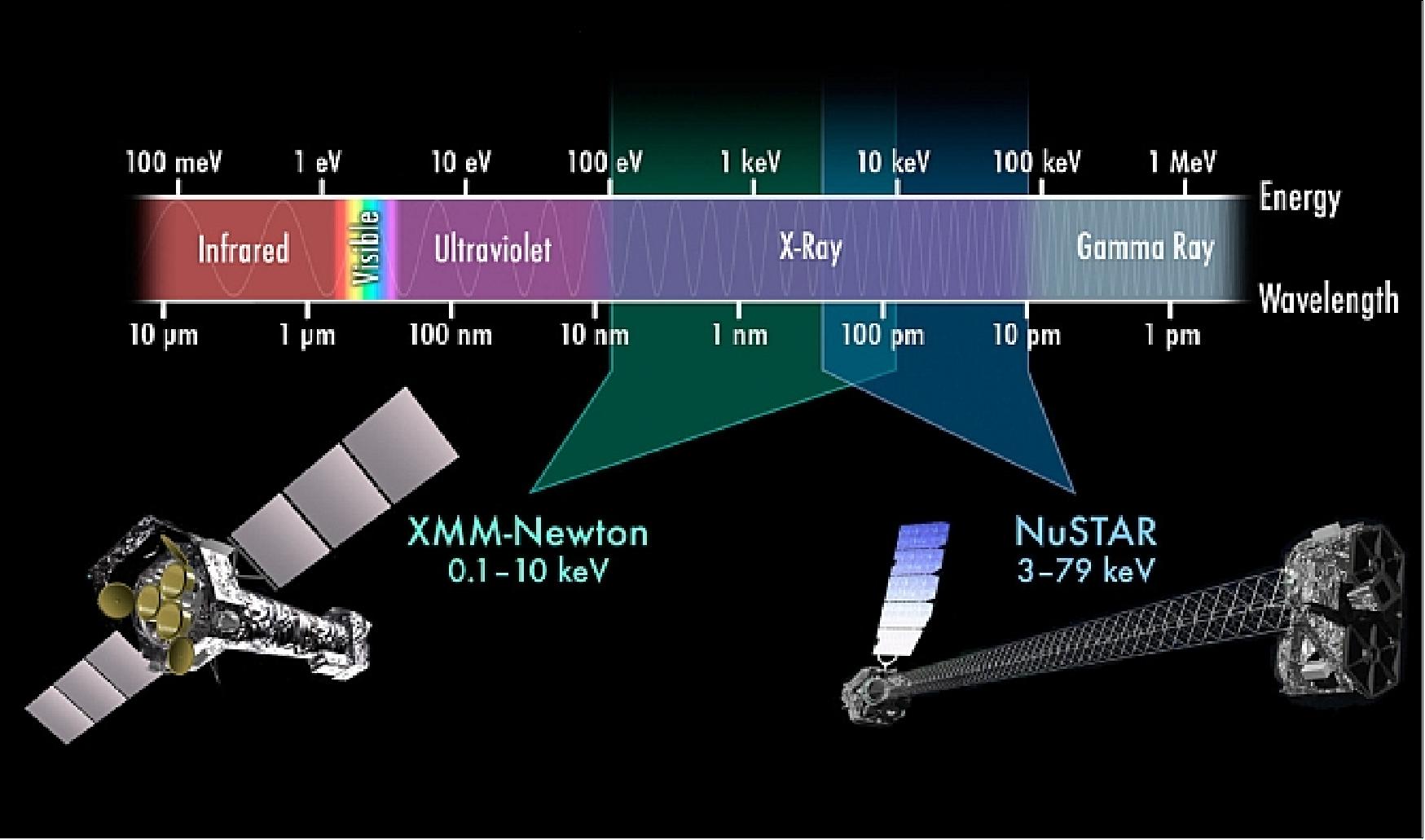
The instrument FOV is energy-dependent due to changes in multilayer reflectance as a function of energy and optics shell radius, which results in overall loss of reflectance and more vignetting at high energy (Figure 50). The spectral resolution is 500 eV at energies below ~30 keV, and increases to 1.2 keV at the upper end of the energy range. The 2 µs temporal resolution, determined by the bit rate allocated in the telemetry stream for time tags, is more than adequate to meet the scientific requirements. The intrinsic temporal resolution of the detector is better than 1 µs. The target of opportunity (ToO) response time is required to be less than 24 hours; however, on average the turnaround will be faster, with targets typically acquired within 6 hours.
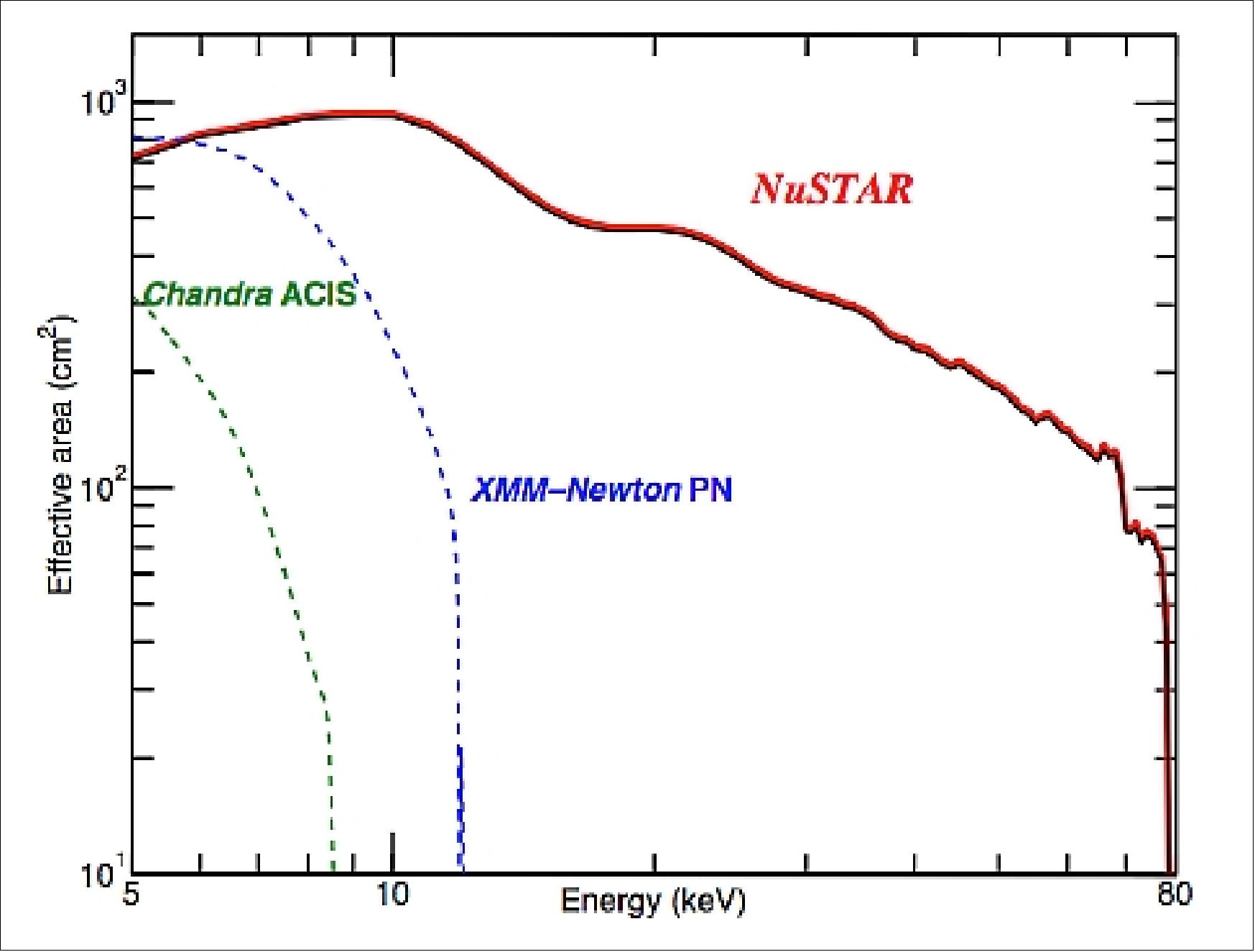
Key science goal | Observations |
Locate massive black holes | Deep and wide-field surveys in GOODS, COSMOS, XBootes |
Study the population of compact objects in the Galaxy | Galactic survey centered on Sgr A* |
Understand explosion dynamics and nucleosynthesis in core collapse and Type Ia SNe | Pointed observations of Cas A, SN1987A, Tycho ToO observations of Ia SNe |
Constrain particle acceleration in relativistic jets in supermassive black holes | Contemporaneous multiwavelength observations of GeV and TeV |
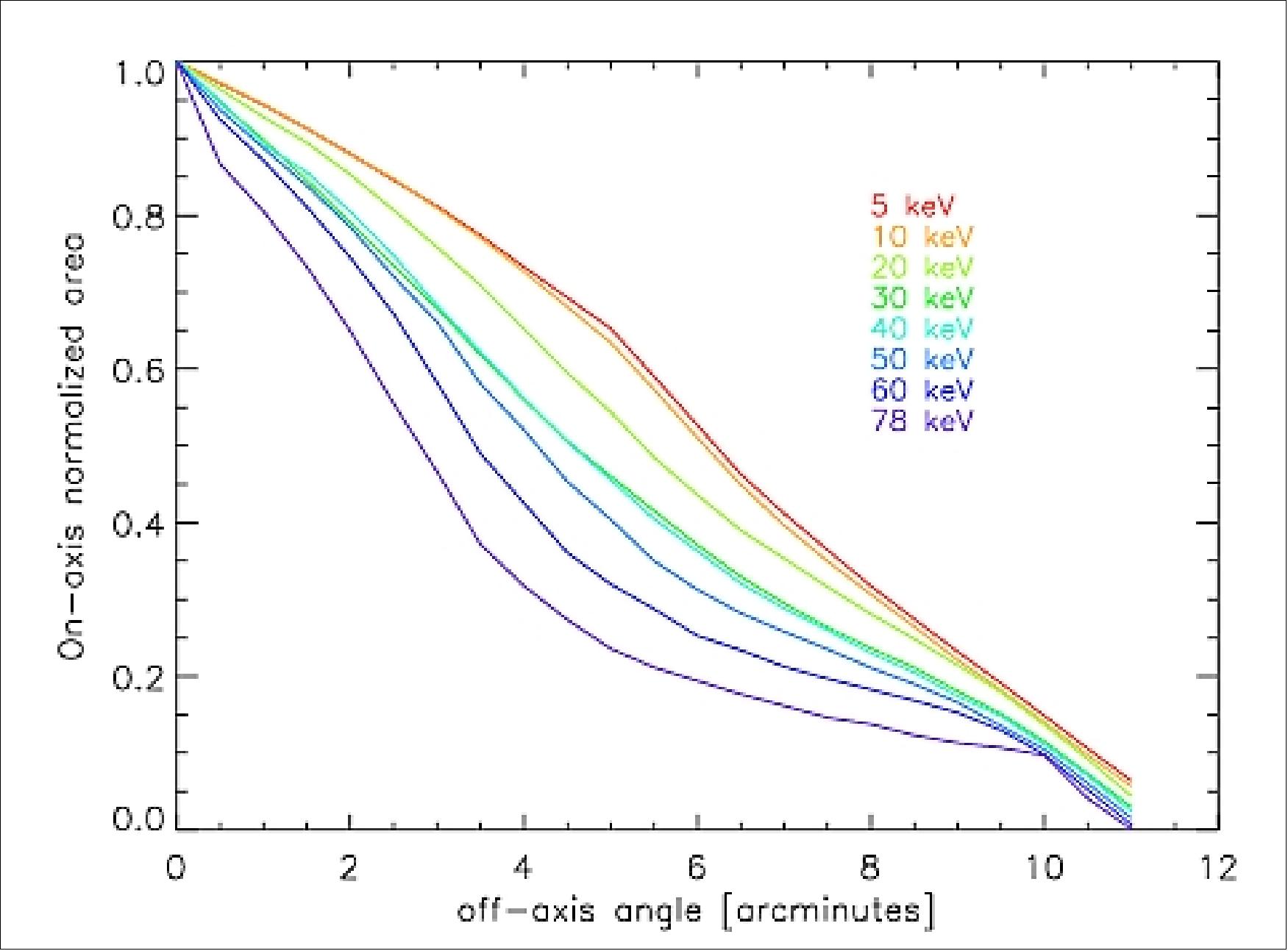
The NuSTAR instrument is launched in a compact, stowed configuration, and after launch a 10 m mast is deployed to achieve a focal length of 10.15 m. Since the absolute deployment location of the mast is difficult to measure on the ground, due to complications associated with complete gravity off-loading, an adjustment mechanism is built into the last section of the mast to enable a one-time alignment to optimize the location of the optical axes on the focal plane. This mechanism provides two angular adjustments as well as rotation. The mast is not perfectly rigid, it is being subjected to thermal distortions particularly when going in and out of Earth's shadow which translate into changes in telescope alignment of 1 -2 arcmin. These mast alignment changes are measured by the combination of an optics bench-mounted star tracker and a laser metrology system.
The same combination of sensors also provides the absolute instrument aspect. In order to limit the FOV open to the detectors, and therefore the diffuse cosmic background, an aperture stop consisting of three rings deploys with the mast. The aperture stop is shown in the deployed configuration in Figure 51. In the stowed configuration, the top will be 0.83 m above the focal plane surface.
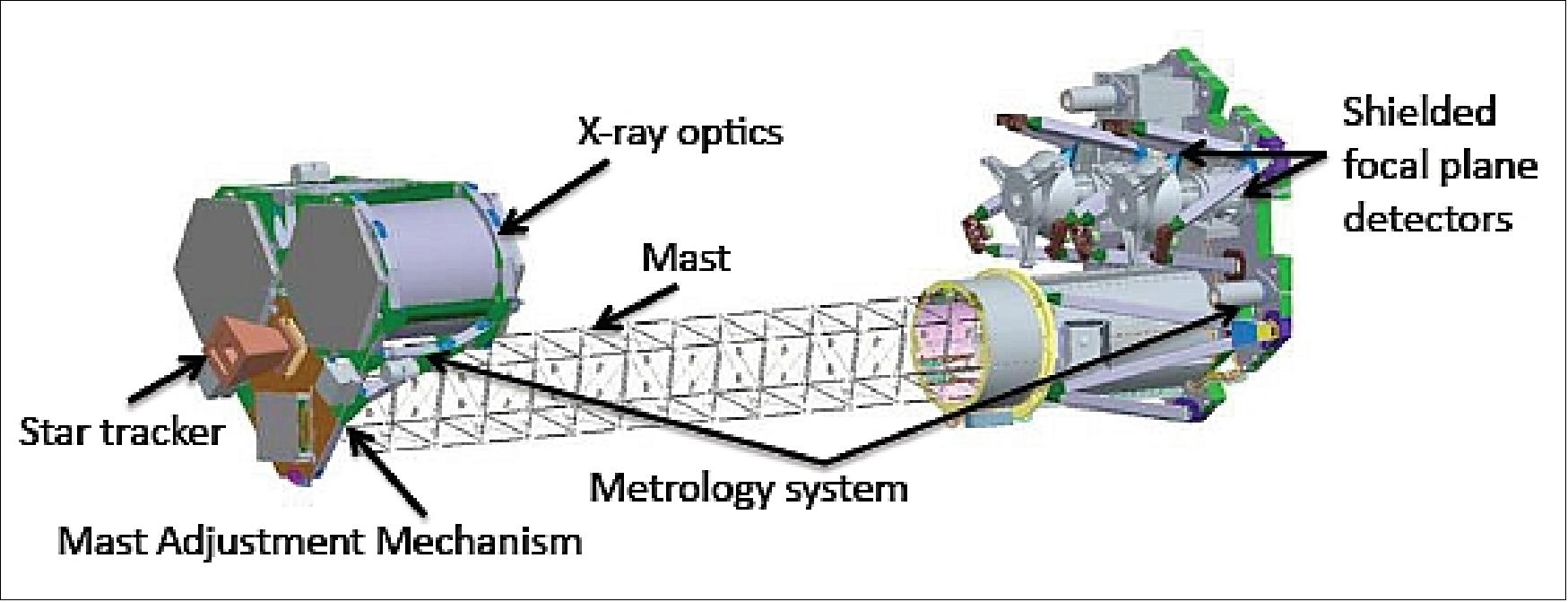
NuSTAR Optics
A blowup of an individual optics module is also shown in Figure 53. Each layer of the optic has an upper and lower conic shell (equivalent to the parabola-hyperbola sections of a Wolter-I optic). Each shell is composed of multiple glass segments formed by thermal slumping. Each piece of glass is coated with a depth-graded multilayer to enhance reflectivity. The enhanced reflectivity provided by the multilayers, along with the shallow graze angles afforded by the long focal length of the optics (10.15 m) provide high effective area over the NuSTAR energy band of 6-79 keV, and a FOV of 12 arcminutes by 12 arcminutes. There are 133 concentric layers which together form each optic. 81) 82) 83)
The glass layers (a Titanium-glass-epoxy-graphite composite structure) are built up on a Titanium mandrel. Titanium support spiders located on the top and bottom of each optic connect it to the optical bench. The compliant, radially-symmetric spiders accommodate thermal expansion effects. Thermal covers (5 µm polyimide) on the entrance and exit apertures of the optic reduce thermal gradients by blocking direct view of the sun and deep space. Three flight modules (called FM0, FM1 and FM2 respectively) are being fabricated. The first two modules are the flight units, and the third module is to provide for more extensive X-ray characterization than is permitted for either of the flight modules, given the compressed delivery schedule of the optics..
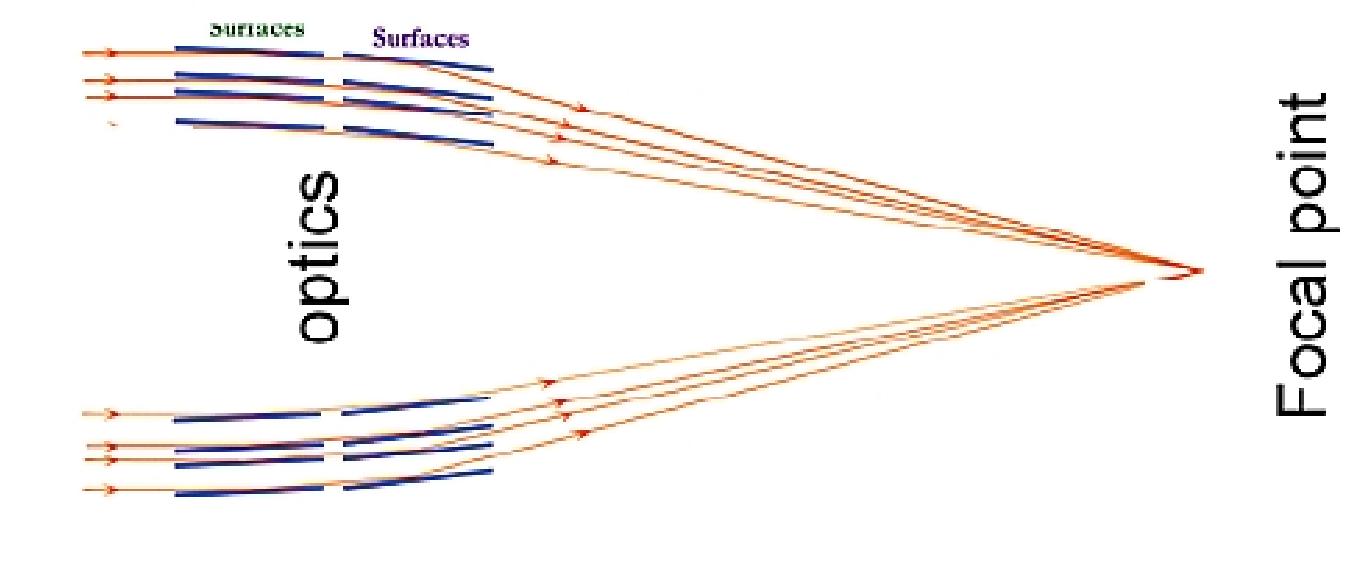
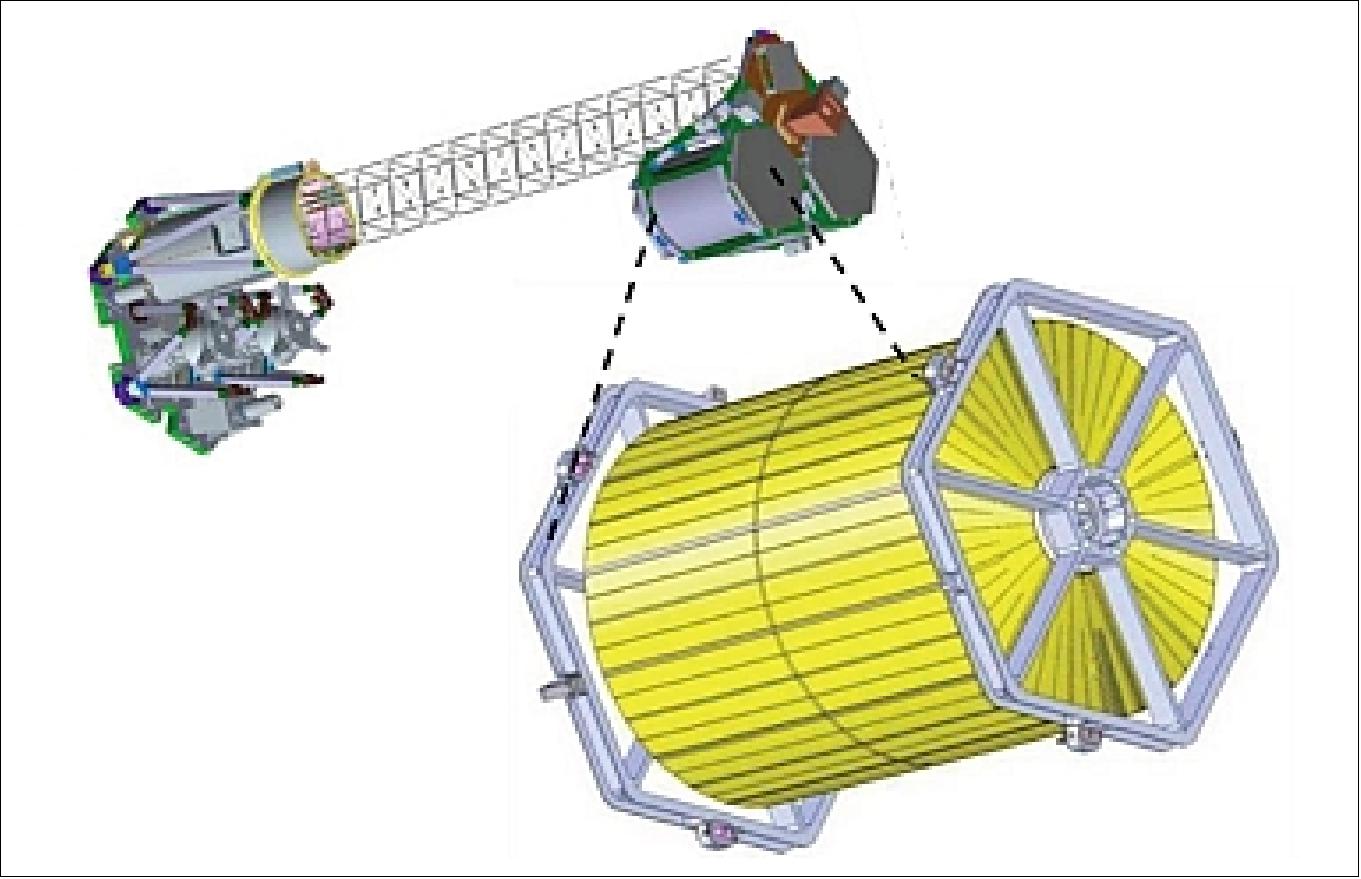
The layers of glass are physically separated from and attached to each other by means of precisely-machined graphite spacers which run lengthwise down the glass segments, and which constrain the glass to the proper conical shape of the Wolter 1 geometry. The spacers are 1.2 mm wide (except in the inner 5 layers where they are 1.6 mm wide to provide more bonding area in this high stress region) in order to minimize X-ray shadowing. The spacers are bonded to the Titanium mandrel and to the glass layers by means of a low outgassing epoxy (Henkel F131). The inner 65 layers of glass form integral shells by means of ~60º sectors, and the outer 65 layers by means of ~30º sectors (dodecants), see Figure 54 (left). The number of graphite spacers is fixed at 5 per glass segment for fabrication simplicity. The transition from sextants to dodecants provides for a reduction in the spacer span between glass segments as the radius of the layers grows, thus maintaining good control of the glass figure. Figure 54 (right) shows the details of the 3 sextant layers of glass that serve as an “intermediate mandrel” for transitioning from sextant to dodecant layers.

The right side image of Figure 54 shows the details of the 3 sextant layers of glass that serve as an “intermediate mandrel” for transitioning from sextant to dodecant layers. The mandrel, sextant and dodecant glass layers and spacers are visible. Double width spacers azimuthally tie the dodecants to the sextant glass at the intermediate mandrel, increasing torsional stiffness and providing a path for distribution of launch loads. The glass segments are coated with depth-graded multilayers. All three flight modules use W/Si for the outer layers. FM0 uses Pt/SiC for its inner layers, while FM1 and FM2 use Pt/C for the inner layers. In order to optimize multilayer reflectivity, the optic’s layers are divided into 10 groups, with a different multilayer recipe for each group.
The Platinum-based multilayers are applied to the first 7 groups (comprising about 2/3 of the optics area), where they are more efficient at reflecting high energy X-rays. The entire assembly is built on, and aligned to, the central Titanium mandrel. After construction, support spiders are attached to the optic for instrument integration. During fabrication, glass and graphite layers are built outward from the central mandrel and all ground handling and alignment activities use the inner mandrel as a support and reference axis. Once the optics are mounted to the optics bench, each is supported and aligned from attachment points on the spider supports.
Focal length | 10.15 m |
Shell radii | 51 - 191 mm (inner, outer) |
Graze angles | 1.3 - 4.7 mrad |
Mirror thickness | 0.21 mm |
Total shells per module | 130 (plus 3 intermediate mandrel shells) |
Total mirror segments | 4680 |
Multilayer (layer 1-89) | FM0 (Flight Module 0): Pt/SiC ~0.7 µm |
Multilayer (layer 90-133) | FM0 : W/Si |
Composite structure | D263 glass; DS-4 graphite; F131 epoxy |
Mandrel/Spider | Titanium |
Mass per optics module | 37.5 kg |
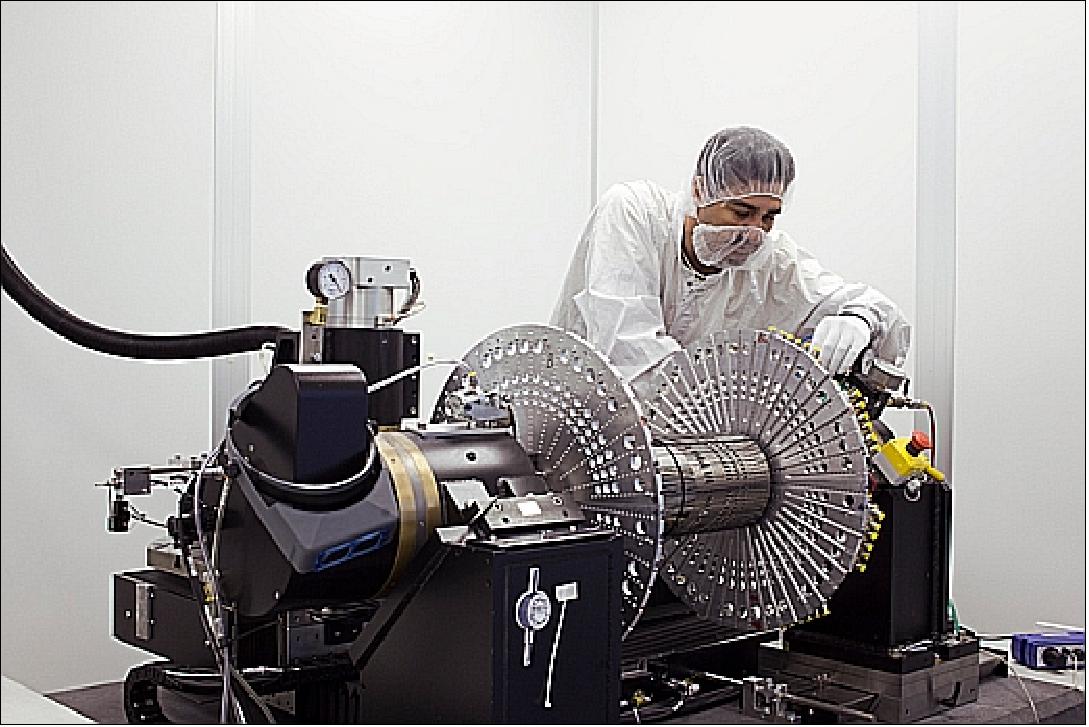
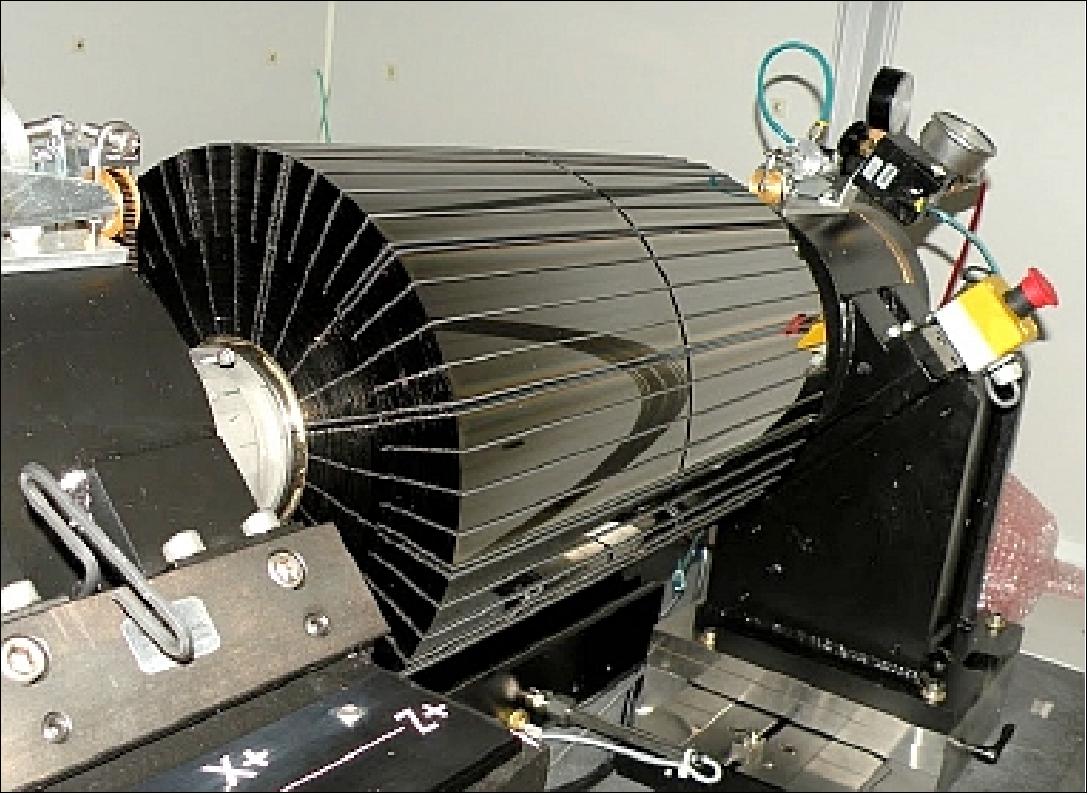
Focal plane modules: Each focal plane consists of four CdZnTe pixel sensors coupled to a custom low-noise ASIC (Application Specific Integrated Circuit). Each hybrid contains a 32 x 32 array of 600 µm pixels with a resulting plate scale of 12.300/pixel, so that the mirror point spread function is over-sampled. The sensors are placed in a 2 x 2 array with a minimal (~ 500 µm) gap between them to fill a total subtended FOV of 13 arcmin on a side (Figure 57). Table 6 summarizes the primary characteristics of the focal plane.
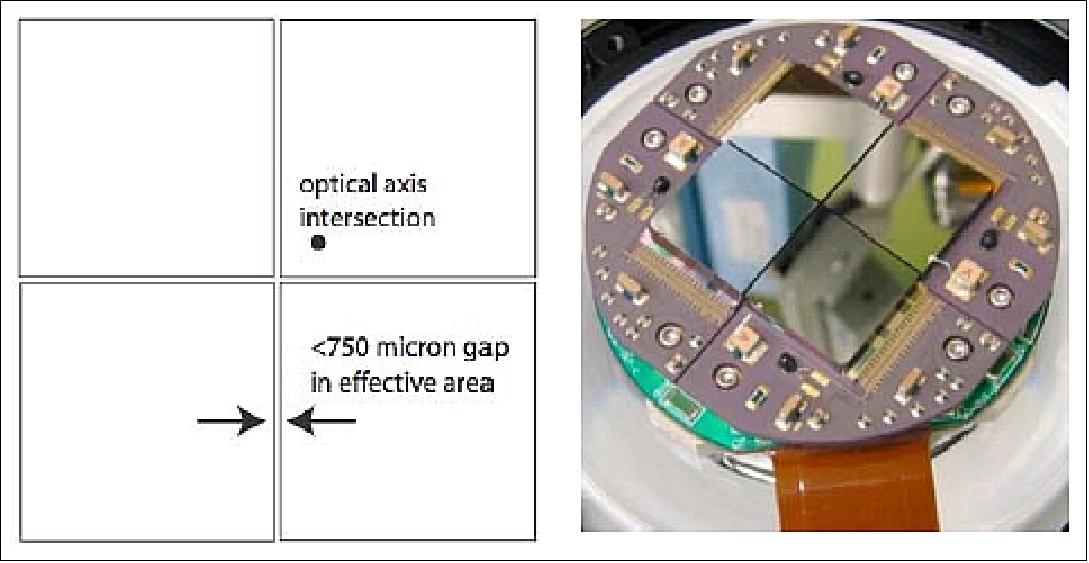
Pixel size | 0.6 mm / 12.3 arcsec |
Focal plane size | 13 arcmin x 13 arcmin |
Pixel format | 32 x 32 CdZnTe (or CZT) detectors |
Threshold | 2.5 keV (each pixel) |
Maximum processing rate | 400 events/s |
Maximum flux measurement rate | 104 s-1 |
Time resolution | 2 µs |
Dead time fraction (weak source) | 2% |
To achieve a low energy threshold and good spectral performance, the detector readout is designed for very low noise. The electronic noise contribution (including detector leakage current) to the energy resolution is 400 eV, and the low-energy threshold is 2.5 keV for an event registering in a single pixel. Over most of the energy range the detector spectral resolution is limited by charge collection uniformity in the CdZnTe crystal. At low energies, between 5 and 30 keV, the average spectral resolution for a typical flight detector is 500 eV FWHM (Full Width Half Maximum), while at 60 keV it is 1.0 keV, and at 86 keV it is 1.2 keV.
The focal plane will be passively cooled in flight to between 0-5ºC. The passive cooling is enabled by the low-power dissipation of the detector readout chip (50 µW/pixel). At in-flight operating temperatures, the detector leakage current is a negligible contributor to the resolution. In addition to measuring the deposited energy and arrival time for each event, the readout architecture enables a depth of interaction measurement which can be used both to maximize photo peak efficiency at high energy, where charge trapping effects can lead to a low-energy `tail' on the energy resolution, and in addition reject background from the back portion of the detector.
The readout of each focal plane module is controlled by an FPGA-embedded microprocessor. Because each pixel triggers independently, and the electronics shaping time is short, there are no pile-up issues equivalent to the CCD focal planes on XMM and Chandra. The maximum rate that events can be processed is 400 cps (cycles per second) in each telescope; however, pulse pileup does not occur until substantially higher rates (~ 105 cps). The readout system is designed so that source fluxes can be measured up to count rates of 104 cps. At the nominal faint-source count rates, the readout dead time is < 2%.
The focal plane is surrounded by an active 2 cm thick CsI(Na) shield and incorporates a deployable aperture stop. The CsI shield extends 20 cm above the detector, and has an opening angle of 16º, while the passive aperture stop defines a much narrower opening of 4º diameter. Figure 58 shows the expected background counts per unit detector area. At low energies the background is dominated by diffuse leakage through the portion of the aperture stop FOV not blocked by the optics bench. The spectral features between 25 and 35 keV are fluorescence from the CsI shield. The background level shown in Figure 58 assumes the use of the depth-of-interaction measurement to reject interactions in the back of the detector, which results in about a factor two background reduction at 60 keV (Ref. 81).
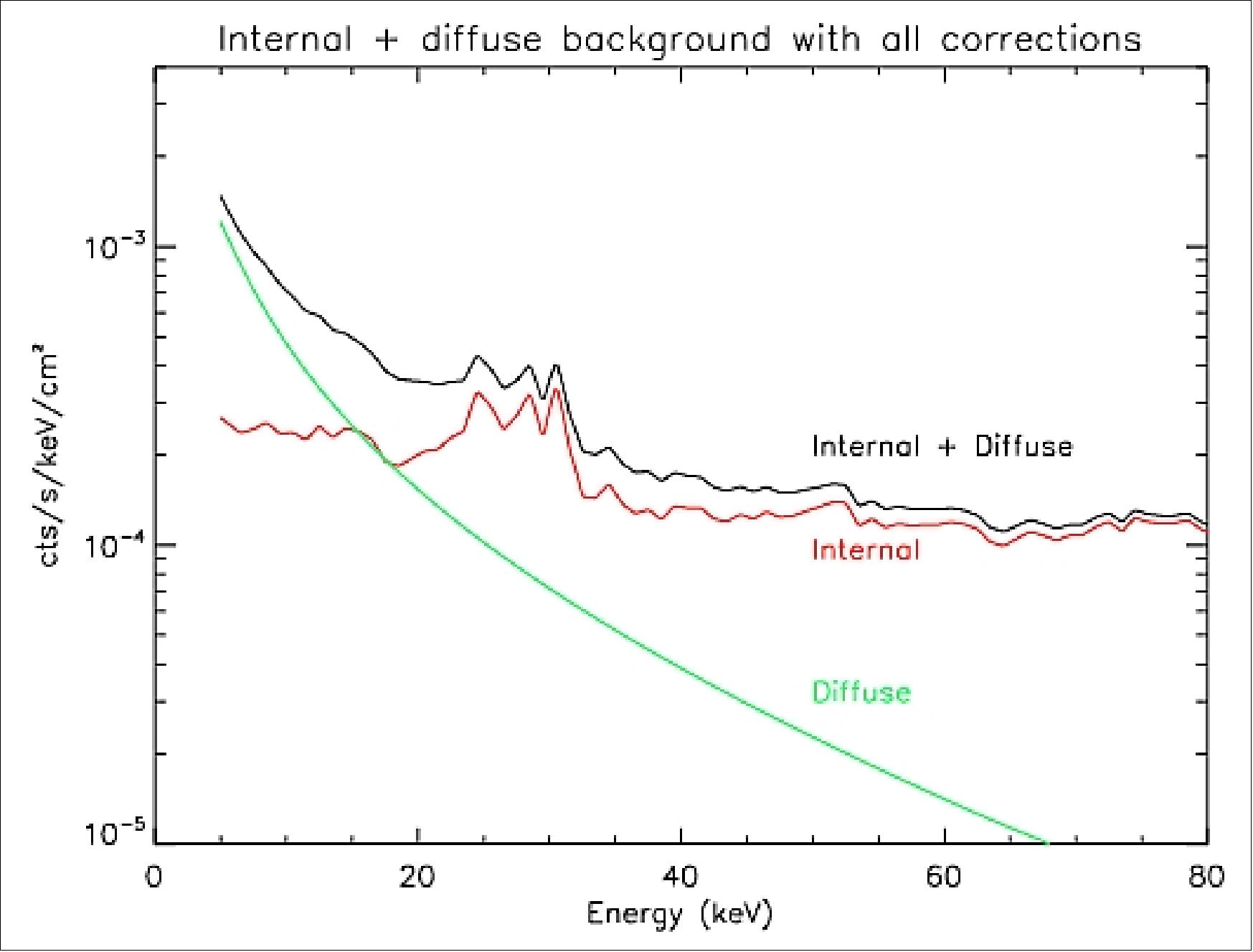
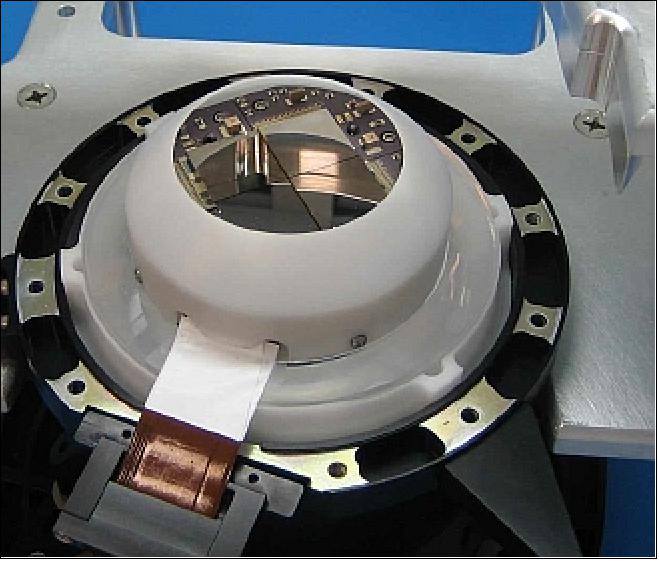
Ground Segment
Data will be publicly available at HEASARC (High Energy Astrophysics Science Archive Research Center) of NASA/GSFC following validation at the science operations center located at Caltech.
The MOC (Mission Operations Center) is located at UCB/SSL. Command uplinks and data downlinks will be through a ground station, operated by ASI (Agenzia Spaziale Italiana), located in Malindi, Kenya. Most science targets will be viewed for a week or more, so that after a 30-day in-orbit checkout and commissioning period, commanding will be rare. The turnaround time for ToO (Target of Opportunity) observations depends largely on timing relative to the ground station passes. The Malindi station is visible once per 90 minute orbit, but commands can take up to 12 hours to prepare given that the MOC is not staffed 24 hours/day.
The science data will be transferred from the MOC to the SOC (Science Operations Center). The SOC is in charge to process and validate the data, and distribute products to the science team. All science data will be converted to FITS (Flexible Image Transport System) format conforming to OGIP (Office of Guest Investigator Programs) standards, and analysis software will adopt the FTOOLS approach and environment. The NuSTAR science data has no proprietary period, and after a six-month interval during which the instrument calibration will be understood and the performance verified, data will enter the public science archive, located at the HEASARC.
NuSTAR Mission System: 85)
• Core components:
- MOC (Mission Operations Center)
- FDC (Flight Dynamics Center)
- SOC (Science Operations Center)
- Remote ground stations
• Interfaces:
- Secure network links to remote ground stations
- Acquisition data upload via secure circuits
- Post-pass telemetry file delivery via Open Internet
- Standardized data flows between MOC, FDC, SOC
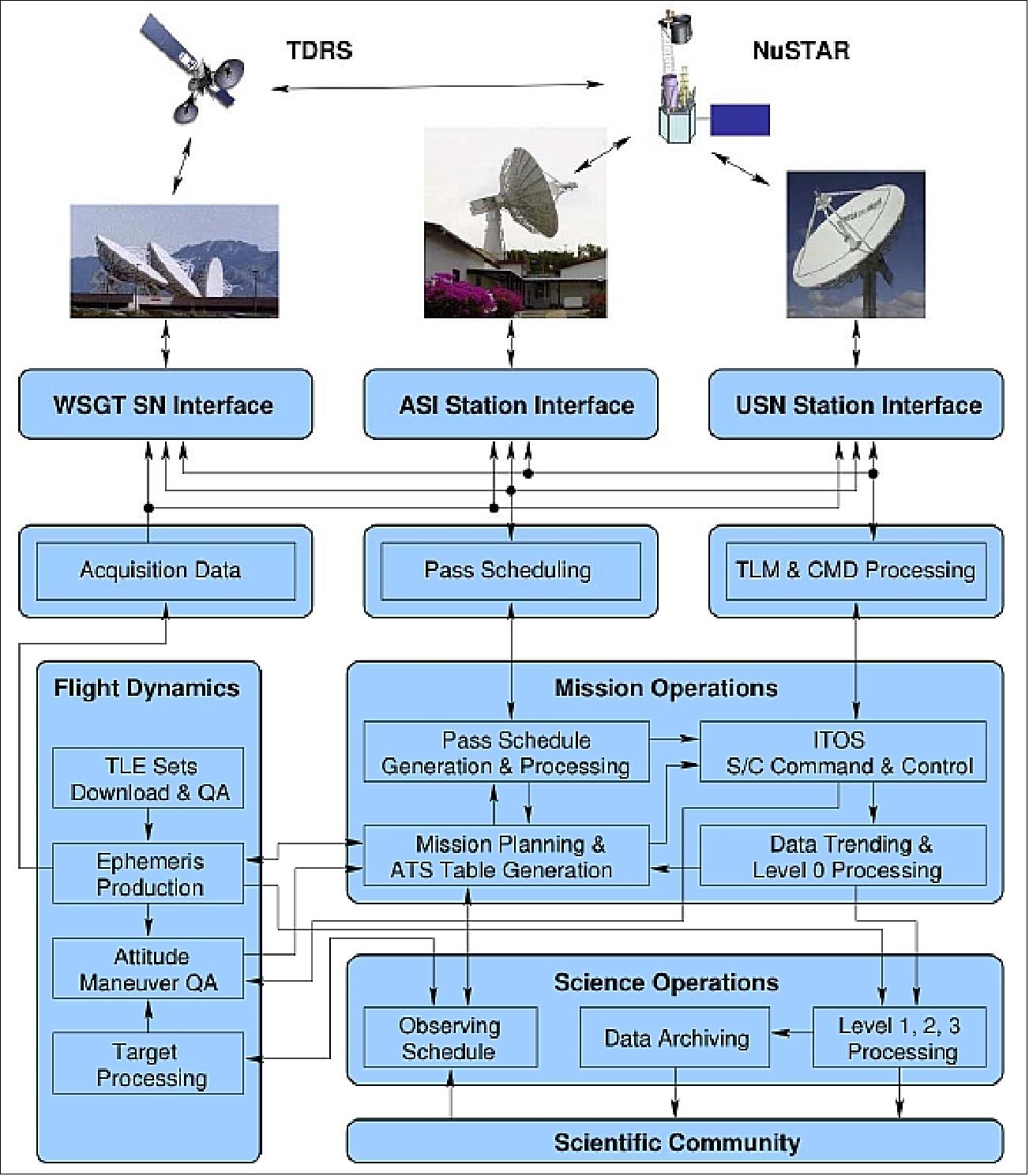
References
1) Fiona A. Harrison, Steven Boggs, Finn Christensen, William Craig, Charles Hailey, Daniel Stern, William Zhang, Lorella Angelini, HongJun An, Varun Bhalereo, Nicolai Brejnholt, Lynn Cominsky, W. Rick Cook, Melania Doll, Paolo Giommi, Brian Grefenstette, Allan Hornstrup, Victoria M. Kaspi, Yunjin Kim, Takao Kitaguchi, Jason Koglin, Carl Christian Liebe, Greg Madejski, Kristin Kruse Madsen, Peter Mao, David Meier, Hiromasa Miyasaka, Kaya Mori, Matteo Perri, Michael Pivovaroff, Simonetta Puccetti, Vikram Rana, Andreas Zoglauer, “The Nuclear Spectroscopic Telescope Array (NuSTAR),” Proceedings of SPIE, Vol. 7732, 2010, URL: http://www.nustar.caltech.edu/uploads/files/harrison_spie2010_7732_27.pdf
2) http://www.nustar.caltech.edu/home
3) Daniel Stern, “NuSTAR: the Nuclear Spectroscopic Telescope Array,” 7th INTEGRAL Workshop, Copenhagen, Denmark, Sept. 8.-11, 2008, URL: http://www.nustar.caltech.edu/uploads/files/copenhagen_08sep.pdf
4) Kristin Kruse Madsen, Brian Grefenstette, Fiona A. Harrison, “The Nuclear Spectroscopic Telescope Array,” IACHEC (International Astronomical Consortium for High Energy Calibration), Woods, Hole, MA, USA, April 12-15, 2010, URL: http://web.mit.edu/iachec/meetings/2010/Presentations/Madsen_NuSTAR.pdf
5) “Mission Overview,” NASA, Dec. 7, 2012, URL: http://www.nasa.gov/mission_pages/nustar/overview/index.html#.UtEG3_uFf_o
6) Finn Christensen, “NuSTAR - Overview and Status,” URL: http://www.rssd.esa.int/SD/ESACFACULTY/docs/seminars/110610_Christensen.pdf
7) F. Harrison, Y. Kim, NuSTAR update,” Oct. 2009, URL: http://www.nustar.caltech.edu/uploads/updates/NuSTAR_2009oct_update.pdf
8) “Nuclear Spectroscopic Telescope Array (NuSTAR),” OSC, URL: http://www.orbital.com/newsinfo/publications/NuStar_Fact.pdf
9) Carl Christian Liebe, Jill Burnham, Rick Cook, Bill Craig, Todd Decker, D. Isaiah Harp, Branislav Kecman, Patrick Meras, Mike Raffanti, Christopher Scholz, Christopher Smith, Jeff Waldman, James Wu, “Metrology System For Measuring Mast Motions On The NuSTAR Mission,” Proceedings of the 2010 IEEE Aerospace Conference, Big Sky, MT, USA, March 6-13, 2010, URL: http://www.nustar.caltech.edu/uploads/files/liebe2010.pdf
10) Patrick Meras Jr., Mark Cooper, R. Peter Dillon, Siamak Forouhar, Ivair Gontijo, Carl Christian Liebe, Andrew Shapiro, “Qualification and Selection of Flight Diode Lasers for the NuSTAR Space Mission,” 2011 IEEE Aerospace Conference, Big Sky, MT, USA, March 5-12, 2011
11) Whitney Calvin, J. D. Harrington, “NASA's NuSTAR Mission Lifts Off,” NASA, June 13, 2012, URL: http://www.nasa.gov/mission_pages/nustar/news/nustar20120613.html
12) Don Cohen, “Learning from the NuSTAR Launch Delay -The story of that delay, why it happened and what both NASA and Orbital Sciences learned from the experience ,” Caltech, Nov. 27, 2012, URL: http://www.nustar.caltech.edu/news/98/62/Learning-from-the-NuSTAR-Launch-Delay/d,news-detail
13) ”NASA’s NuSTAR Mission Celebrates 10 Years Studying the X-Ray Universe,” NASA/JPL News, 9 June 2022, URL: https://www.jpl.nasa.gov/news/nasas-nustar-mission-celebrates-10-years-studying-the-x-ray-universe
14) ”NASA’s NuSTAR Makes Illuminating Discoveries With ‘Nuisance’ Light,” NASA/JPL, 1 March 2022, URL: https://www.jpl.nasa.gov/news/nasas-nustar-makes-illuminating-discoveries-with-nuisance-light?utm_source=iContact&utm_medium=email&utm_campaign=nasajpl&utm_content=daily20220301-1
15) McKinley C. Brumback, Brian W. Grefenstette, Douglas J. K. Buisson, Matteo Bachetti, Riley Connors, Javier A. García, Amruta Jaodand, Roman Krivonos, Renee Ludlam, Kristin K. Madsen, Guglielmo Mastroserio, John A. Tomsick, and Daniel Wik, ” Extending the Baseline for SMC X-1's Spin and Orbital Behavior with NuSTAR Stray Light,” The Astrophysical Journal, Volume 926, Number 2, Published: 24 February 2022, https://doi.org/10.3847/1538-4357/ac4d24, URL: https://iopscience.iop.org/article/10.3847/1538-4357/ac4d24/pdf
16) ”NASA Telescope Spots Highest-Energy Light Ever Detected From Jupiter,” NASA News, 10 February 2022, URL: https://www.jpl.nasa.gov/news/nasa-telescope-spots-highest-energy-light-ever-detected-from-jupiter
17) Kaya Mori, Charles Hailey, Gabriel Bridges, Shifra Mandel, Amani Garvin, Brian Grefenstette, William Dunn, Benjamin J. Hord, Graziella Branduardi-Raymont, John Clarke, Caitriona Jackman, Melania Nynka & Licia Ray, ”Observation and origin of non-thermal hard X-rays from Jupiter,” Nature Astronomy, Published: 10 February 2022, https://doi.org/10.1038/s41550-021-01594-8
18) Calla Cofield, Naomi Hartono, ”Seeing Some Cosmic X-Ray Emitters Might Be a Matter of Perspective,” NASA Feature, 09 July 2021, URL: https://www.nasa.gov/feature/jpl/seeing-some-cosmic-x-ray-emitters-might-be-a-matter-of-perspective
19) ”A Cosmic Baby Is Discovered, and It's Brilliant,” NASA Feature, 17 June 2020, URL: https://www.nasa.gov/feature/jpl/a-cosmic-baby-is-discovered-and-its-brilliant
20) ”NASA Satellite Spots a Mystery That's Gone in a Flash,” NASA/JPL, 4 September 2019, URL: https://www.jpl.nasa.gov/news/news.php?release=2019-182
21) ”In Colliding Galaxies, a Pipsqueak Shines Bright,” NASA/JPL News, 20 February 2019, URL: https://www.jpl.nasa.gov/news/news.php?release=2019-028
22) Benjamin Fleury, Murthy S. Gudipati, Bryana L. Henderson, and Mark Swain, ”Photochemistry in Hot H2-dominated Exoplanet Atmospheres,” The Astrophysical Journal, Volume 871, Number 2, Published: 29 January 2019, https://doi.org/10.3847/1538-4357/aaf79f
23) Francis Reddy, Rob Garner, ”NASA's NuSTAR Mission Proves Superstar Eta Carinae Shoots Cosmic Rays,” NASA, 3 July 2018, URL: https://www.nasa.gov/feature/goddard/2018/nasas-nustar-mission-proves-superstar-eta-carinae-shoots-cosmic-rays
24) Kenji Hamaguchi, Michael F. Corcoran, Julian M. Pittard, Neetika Sharma, Hiromitsu Takahashi, Christopher M. P. Russell, Brian W. Grefenstette, Daniel R. Wik, Theodore R. Gull, Noel D. Richardson, Thomas I. Madura & Anthony F. J. Moffat,”Non-thermal X-rays from colliding wind shock acceleration in the massive binary Eta Carinae,” Nature Astronomy, published 02 July 2018, URL of abstract: https://www.nature.com/articles/s41550-018-0505-1
25) ”NuSTAR Probes Black Hole Jet Mystery,” NASA/JPL News, October 30, 2017, URL: https://www.jpl.nasa.gov/news/news.php?release=2017-281
26) P. Gandhi, M. Bachetti, V. S. Dhillon, R. P. Fender, L. K. Hardy, F. A. Harrison, S. P. Littlefair, J. Malzac, S. Markoff, T. R. Marsh, K. Mooley, D. Stern, J. A. Tomsick, D. J. Walton, P. Casella, F. Vincentelli, D. Altamirano, J. Casares, C. Ceccobello, P. A. Charles, C. Ferrigno, R. I. Hynes, C. Knigge, E. Kuulkers, M. Pahari, F. Rahoui, D. M. Russell, A. W. Shaw, ”An elevation of 0.1 light-seconds for the optical jet base in an accreting Galactic black hole system,” Nature Astronomy (2017), doi:10.1038/s41550-017-0273-3, Published online: 30 October 2017, URL of abstract: https://www.nature.com/articles/s41550-017-0273-3
27) ”NuSTAR's First Five Years in Space,” NASA, June 13, 2017, URL: https://www.nasa.gov/feature/jpl/nustars-first-five-years-in-space
28) ”Merging Galaxies Have Enshrouded Black Holes,” NASA/JPL, May 9, 2017, URL: https://www.jpl.nasa.gov/news/news.php?release=2017-136
29) C. Ricci, F. E. Bauer, E. Treister, K. Schawinski, G. C. Privon, L. Blecha, P. Arevalo, L. Armus, F. Harrison, L. C. Ho,K. Iwasawa, D. B. Sanders, D. Stern, ”Growing supermassive black holes in the late stages of galaxy mergers are heavily obscured,” Monthly Notices of the Royal Astronomical Society, Vol. 468, Issue 2, June 2017, pp: 1273-1299, DOI: https://doi.org/10.1093/mnras/stx173, published on 23 January 2017
30) ”NuSTAR Probes Puzzling Galaxy Merger,” NASA/JPL News Release, March 27, 2017, URL: https://www.jpl.nasa.gov/news/news.php?release=2017-088
31) Elizabeth Landau,”Andromeda's Bright X-Ray Mystery Solved by NuSTAR,” NASA, March 23, 2017, URL: https://www.nasa.gov/feature/jpl/andromedas-bright-x-ray-mystery-solved-by-nustar
32) M. Yukita, A. Ptak, A. E. Hornschemeier, D. Wik, T. J. Maccarone, K. Pottschmidt, A. Zezas, V. Antoniou, R. Ballhausen, B. D. Lehmer, A. Lien, B. Williams, F. Baganoff, P. T. Boyd, T. Enoto, J. Kennea, K. L. Page, Y. Choi, ”Identification of the Hard X-ray Source Dominating the E > 25 keV Emission of the Nearby Galaxy M31,” The Astrophysical Journal, Draft version March 22, 2017, URL: https://arxiv.org/pdf/1703.07318.pdf
33) Elizabeth Landau, Markus Bauer, ”NuSTAR Helps Find Universe's Brightest Pulsars,” NASA/JPL, Feb. 28, 2017, URL: http://www.jpl.nasa.gov/news/news.php?feature=6760&utm_source=iContact&utm_medium=email&utm_campaign=NASAJPL&utm_content=daily20170228-2
34) Gian Luca Israel, Andrea Belfiore, Luigi Stella, Paolo Esposito, Piergiorgio Casella, Andrea De Luca, Martino Marelli, Alessandro Papitto, Matteo Perri, Simonetta Puccetti, Guillermo A. Rodríguez Castillo, David Salvetti, Andrea Tiengo, Luca Zampieri, Daniele D’Agostino, Jochen Greiner, Frank Haber, Giovanni Novara, Ruben Salvaterra, Roberto Turolla, Mike Watson, Joern Wilms, Anna Wolter, ”An accreting pulsar with extreme properties drives an ultraluminous x-ray source in NGC 5907,” Science, 20 Feb 2017, DOI: 10.1126/science.aai8635
35) ”NuSTAR helps solve 'Rapid Burster' mystery,” Caltech, Jan. 31, 2017, URL: http://www.nustar.caltech.edu/news/nustar170131
36) J. van den Eijnden, T. Bagnoli, N. Degenaar, A. M. Lohfink, M. L. Parker, J. J. M in ‘t Zand, A. C. Fabian, ”A strongly truncated inner accretion disc in the Rapid Burster,” MNRAS (Monthly Notices of the Royal Astronomical Society) Letters, published on 05 Dec. 2016, Vol. 466, Issue 1, March 2017, DOI: https://doi.org/10.1093/mnrasl/slw244
37) ”Mind the Gap: Rapid Burster behavior explained,” ESA, Jan. 31, 2017, URL: http://sci.esa.int/xmm-newton/58747-mind-the-gap-rapid-burster-behaviour-explained/
38) ”A supercomputer models a blinking, impossibly bright 'monster pulsar',” provided by NAOJ, Sept. 8, 2016, URL: http://phys.org/news/2016-09-supercomputer-impossibly-bright-monster-pulsar.html
39) Tomohisa Kawashima, Shin Mineshige, Ken Ohsuga, Takumi Ogawa, ”A radiation-hydrodynamic model of accretion columns for ultra-luminous X-ray pulsars,” PASJ (Publications of the Astronomical Society of Japan), September 7, 2016, doi: 10.1093/pasj/psw075, URL of abstract: http://pasj.oxfordjournals.org/content/early/2016/09/01/pasj.psw075.short?rss=1
40) Elizabeth Landau, ”Chorus of Black Holes Sings in X-Rays,” NASA, July 28, 2016, URL: http://www.nasa.gov/feature/jpl/chorus-of-black-holes-sings-in-x-rays
41) Whitney Clavin, ”Andromeda Galaxy Scanned with High-Energy X-ray Vision,” NASA, Jan. 5, 2016, URL: http://www.nasa.gov/feature/jpl/Andromeda-Galaxy-Scanned-with-High-Energy-X-ray-Vision
42) ”NuSTAR Finds Cosmic Clumpy Doughnut Around Black Hole,” NASA/JPL, Dec. 17, 2015, URL: http://www.jpl.nasa.gov/news/news.php?release=2015-379
43) “Searing Sun Seen in X-rays,” NASA, July 8, 2015, URL: http://www.nasa.gov/jpl/nustar/searing-sun-seen-in-x-rays
44) Felicia Chou, Whitney Clavin, “NASA's NuSTAR Captures Possible 'Screams' from Zombie Stars,” NASA/JPL, Release 15-077, April 29, 2015, URL: http://www.nasa.gov/press-release/nasas-nustar-captures-possible-screams-from-zombie-stars
45) Tony Greicius, “Extra X-rays at the Hub of Our Milky Way Galaxy,” NASA/JPL, April 30, 2015, URL: http://www.nasa.gov/jpl/nustar/pia19334/extra-x-rays-at-the-hub-of-our-milky-way-galaxy
46) Felicia Chou, Whitney Clavin, “NASA, ESA Telescopes Give Shape to Furious Black Hole Winds,” NASA, Release 15-21, Feb. 19, 2015, URL: http://www.nasa.gov/press/2015/february/nasa-esa-telescopes-give-shape-to-furious-black-hole-winds/
47) “Widespread wind from black hole can shape star formation,” ESA, Feb. 19, 2015, URL: http://sci.esa.int/xmm-newton/55475-widespread-wind-from-black-hole-can-shape-star-formation/
48) “XMM-Newton and NuSTAR spectrum of the quasar PDS 456,” ESA, Feb. 19, 2015, URL: http://sci.esa.int/xmm-newton/55480-xmm-newton-and-nustar-spectrum-of-the-quasar-pds-456/
49) Whitney Clavin, “Sun Sizzles in High-Energy X-Rays,” NASA/JPL, Dec. 22, 2014: URL: http://www.nasa.gov/jpl/nustar/sun-sizzles-in-high-energy-x-rays/
50) Tony Phillips, “The Mystery of Nanoflares,” NASA Scince News, March 19, 2015, URL: http://science.nasa.gov/science-news/science-at-nasa/2015/19mar_nanoflares/
51) “Sun shines in high-energy X-rays,” Caltech, URL: http://www.nustar.caltech.edu/image/nustar141222a
52) Felicia Chou, Whitney Calvin, “NASA’s NuSTAR Telescope Discovers Shockingly Bright Dead Star,” NASA, Release 14-270, Oct. 8, 2014, URL: http://www.nasa.gov/press/2014/october/nasa-s-nustar-telescope-discovers-shockingly-bright-dead-star/
53) “NASA’s NuSTAR Telescope Discovers Shockingly Bright Dead Star,” News Release, Oct. 8, 2014, URL: http://www.nustar.caltech.edu/news/nustar141008
54) Tim Reyes, “Nearby Galaxy Holds First Ultraluminous X-Ray Source that is a Pulsar,” Universe Today, Oct. 10, 2014, URL: http://www.universetoday.com/115172/nearby-galaxy-holds-first-ultraluminous-x-ray-source-that-is-a-pulsar/
55) M. Bachetti1, F. A. Harrison, D. J. Walton, B. W. Grefenstette, D. Chakrabarty, F. Fürst, D. Barret, A. Beloborodov, S. E. Boggs, F. E. Christensen, W. W. Craig, A. C. Fabian, C. J. Hailey, A. Hornschemeier, V. Kaspi, S. R. Kulkarni, T. Maccarone, J. M. Miller, V. Rana, D. Stern, S. P. Tendulkar, J. Tomsick, N. A. Webb, W. W. Zhang, “An ultraluminous X-ray source powered by an accreting neutron star,” Nature, Vol. 514, 202-204, October 9, 2014, doi:10.1038/nature13791
56) J. D. Harrington, Whitney Clavin, “NASA's NuSTAR Sees Rare Blurring of Black Hole Light,” NASA, Release 14-210, Aug. 12, 2014, URL: http://www.nasa.gov/press/2014/august/nasas-nustar-sees-rare-blurring-of-black-hole-light/
57) Whitney Clavin, J. D. Harrington, “NASA's NuSTAR Untangles Mystery of How Stars Explode,” NASA Release14-050, Feb. 19, 2014, URL: http://www.nasa.gov/jpl/nustar/supernova-explosion-20140219/#.UwWV3M7ihqN
58) B. W. Grefenstette, F. A. Harrison, S. E. Boggs, S. P. Reynolds, C. L. Fryer, K. K. Madsen, D. R. Wik, A. Zoglauer, C. I. Ellinger, D. M. Alexander, H. An, D. Barret, F. E. Christensen, W. W. Craig, K. Forster, P. Giommi, C. J. Hailey, A. Hornstrup, V. M. Kaspi, T. Kitaguchi, J. E. Koglin, P. H. Mao, H. Miyasaka, K. Mori, M. Perri, M. J. Pivovaroff, S. Puccetti, V. Rana, D. Stern, N. J. Westergaard, W. W. Zhang, “Asymmetries in core-collapse supernovae from maps of radioactive 44Ti in Cassiopeia A,“ Nature, 2014; Vol. 506 (7488): 339, DOI: 10.1038/nature12997
59) UCB, “Astronomers get first peek into core of supernova, using NuSTAR telescope,” ScienceDaily, Feb. 19, 2014, URL: http://www.sciencedaily.com/releases/2014/02/140219133333.htm
60) Whitney Clavin, “Dead Star and Distant Black Holes Dazzle in X-Rays,” NASA/JPL, Jan. 09, 2014, URL: http://www.nasa.gov/jpl/nustar/dead-star-black-holes-20140109/#.UtD-jfuFf_r
61) http://www.nustar.caltech.edu/multimedia-gallery
62) Daniel Stern and NuSTAR Team, “The Nuclear Spectroscopic Telescope Array (NuSTAR),” 223rd Meeting of AAS (American Astronomical Society), Washington, D.C. USA, Jan. 5-9, 2014
63) “NuSTAR Delivers the X-Ray Goods,” Caltech, Aug. 29, 2013, URL: http://www.nustar.caltech.edu/news/109/62/NuSTAR-Delivers-the-X-Ray-Goods
64) Whitney Clavin, J. D. Harrington, “NASA's NuSTAR Helps Solve Riddle of Black Hole Spin,” NASA/JPL, Feb. 27, 2013, URL: http://www.nasa.gov/mission_pages/nustar/news/nustar20130227.html
65) http://www.nasa.gov/mission_pages/nustar/multimedia/pia16697.html
66) “Two X-Ray Observatories are Better Than One,” NASA/JPL, Feb. 27, 2013, URL: http://photojournal.jpl.nasa.gov/catalog/PIA16870
67) “NuSTAR Status Update,” Caltech, Feb. 21, 2013, URL: http://www.nustar.caltech.edu/news/102/62/NuSTAR-Status-Update
68) Whitney Clavin, J.D. Harrington, “NASA's NuSTAR Catches Black Holes in Galaxy Web,” NASA, January 7, 2013, URL: http://www.nasa.gov/mission_pages/nustar/news/nustar20130107.html
69) http://www.nustar.caltech.edu/news/99/62/NASA-s-NuSTAR-Catches-Black-Holes-in-Galaxy-Web/d,news-detail
70) Whitney Clavin, “Pointing the Telescope and Probing the X-ray Sky,” NASA, Nov. 20, 2012, URL: http://www.nasa.gov/mission_pages/nustar/news/nustar20121120.html
71) Whitney Clavin, “Space Telescope Opens Its X-Ray Eyes,” NASA/JPL, June 28, 2012, URL: http://www.nasa.gov/mission_pages/nustar/news/nustar20120628.html
72) Whitney Calvin, “NuSTAR Mission Status Report: Observatory Unfurls its Unique Mast,” NASA/JPL, June 21, 2012, URL: http://www.jpl.nasa.gov/news/news.cfm?release=2012-183
73) Whitney Calvin, J. D. Harrigton, “NASA's NuSTAR Mission Lifts Off,” NASA/JPL, June 13, 2012, URL: http://www.jpl.nasa.gov/news/news.cfm?release=2012-170
74) Fiona A. Harrison, Finn E. Christensen, William Craig, Charles Hailey,· Wayne Baumgartner,· C. M. H. Chen, James Chonko, W. Rick Cook, Jason Koglin, Kristin-Kruse Madsen, Michael Pivavoroff, Steven Boggs, David Smith, “Development of the HEFT and NuSTAR focusing telescopes,” Experimental Astronomy, Vol. 20, pp. 131-137, 2005, DOI 10.1007/s10686-006-9072-z, URL: http://www.nustar.caltech.edu/uploads/files/harrison2005.pdf
75) Chuck Hailey, “Nuclear Spectroscopic Telescope Array (NuSTAR),” NuSTAR PDR, June 9-10, 2009, URL: http://www.nustar.caltech.edu/uploads/files/suzaku_09jul.pdf
76) C. J. Hailey, S. Boggs, F. E. Christensen, W. W. Craig, F. A. Harrison, D. Stern, W. Zhang, for the NuSTAR Science Team, “The Nuclear Spectroscopic Telescope Array (NuSTAR),” JAXA Special Publication, JAXA-SP-09-008E, URL: http://airex.tksc.jaxa.jp/dr/prc/japan/contents/AA0064574157/64574157.pdf
77) Fiona Harrison, Charles J. Hailey, “X-Ray Vision: NASA's NuSTAR Telescope,” Scientific American Magazine, January 26, 2011
78) David M. Smith, Säm Krucker, Gordon Hurford, Hugh Hudson, Stephen White, Fiona Harrison, Daniel Stern, “The HighEnergy Sun at High Sensitivity: a NuSTAR Solar Guest Investigation Program,” URL: http://www.nustar.caltech.edu/uploads/files/helio_decadal_WP_10nov.pdf
79) Fiona A. Harrison, William W. Craig, Finn E. Christensen, Charles J. Hailey, William W. Zhang, Steven E. Boggs, Daniel Stern, W. Rick Cook, Karl Forster, Paolo Giommi, Brian W. Grefenstette, Yunjin Kim, Takao Kitaguchi, Jason E. Koglin, Kristin K. Madsen, Peter H. Mao, Hiromasa Miyasaka, Kaya Mori, Matteo Perri, Michael J. Pivovaroff, Simonetta Puccetti, Vikram R. Rana, Niels J. Westergaard, Jason Willis, Andreas Zoglauer, Hongjun An, Matteo Bachetti, Nicolas M. Barrière, Eric C. Bellm, Varun Bhalerao, Nicolai F. Brejnholt, Felix Fuerst, Carl C. Liebe, Craig B. Markwardt, Melania Nynka, Julia K. Vogel, Dominic J. Walton, Daniel R. Wik, David M. Alexander, Lynn R. Cominsky, Ann E. Hornschemeier, Allan Hornstrup, Victoria M. Kaspi, Greg M. Madejski, Giorgio Matt, Silvano Molendi, David M. Smith, John A. Tomsick, Marco Ajello, David R. Ballantyne, Mislav Baloković, Didier Barret, Franz E. Bauer, Roger D. Blandford, W. Niel Brandt, Laura W. Brenneman, James Chiang, Deepto Chakrabarty, Jerome Chenevez, Andrea Comastri, Francois Dufour, Martin Elvis, Andrew C. Fabian, Duncan Farrah, Chris L. Fryer, Eric V. Gotthelf, Jonathan E. Grindlay, David J. Helfand, Roman Krivonos, David L. Meier, Jon M. Miller, Lorenzo Natalucci, Patrick Ogle, Eran O. Ofek, Andrew Ptak, Stephen P. Reynolds, Jane R. Rigby, Gianpiero Tagliaferri, Stephen E. Thorsett, Ezequiel Treister, C. Megan Urry, “The Nuclear Spectroscopic Telescope Array (NuSTAR) High-energy X-Ray Mission,” The Astrophysica Journal. Vol. 2, No 2, May 13, 2013, p. 103, doi:10.1088/0004-637X/770/2/103.
A shortened version of 19 pages is provided at: URL: http://dro.dur.ac.uk/11385/1/11385.pdf?DDD25+cqjd36
80) Stephen L. O'Dell, Roger J. Brissenden, William N. Davis, Ronald F. Elsner, Martin Elvis, Mark Freeman, Terry Gaetz, Paul Gorenstein, Mikhail V. Gubarev, Diab Jerius, Michael Juda, Jeffery J. Kolodziejczak, Stephen S. Murray, Robert Petre, William Podgorski, Brian D. Ramsey, Paul B. Reid, Timo Saha, Daniel A. Schwartz, Susan Trolier-McKinstry, Martin C. Weisskopf, Rudeger H. T. Wilke, Scott Wolk, William W. Zhang, “High-resolution x-ray telescopes,” 2010, URL: http://constellation.gsfc.nasa.gov/resources/Published_Papers/HighResolutionXrayTelescopes2010.pdf
81) Charles J. Hailey, HongJun An, Kenneth L. Blaedel, Nicolai F. Brejnholt, Finn E. Christensen, William W. Craig, Todd A. Decker, Melanie Doll, Jeff Gum, Jason E. Koglin, Carsten P. Jensen, Layton Hale, Kaya Mori, Michael J. Pivovaroff, Marton Sharpe, Marcela Stern, Gordon Tajiri, William W. Zhang, “The Nuclear Spectroscopic Telescope Array (NuSTAR): Optics Overview and Current Status”, Proceedings of. SPIE, Vol. 7732, 28, 2010, URL: http://www.nustar.caltech.edu/uploads/files/hailey_spie2010_7732_28.pdf
82) F. Harrison, Y. Kim, “NuSTAR update,” May 2010, URL:http://www.nustar.caltech.edu/uploads/updates/NuSTAR_2010may_update.pdf
83) ”Mirror-Making Extraordinaire Advances Silicon X-ray Optics to A New Level-Astrophysicist Receives NASA Funding to Mature Cutting-Edge Fabrication Technique,” Cutting edge, Volume 13, Issue 2, Winter 2017, pp: 3-4, URL: https://gsfctechnology.gsfc.nasa.gov/Current.pdf
84) F. Harrison, Y. Kim, “NuSTAR update,” Dec. 2010, URL: http://www.nustar.caltech.edu/uploads/updates/NuSTAR_2010dec_update.pdf
85) Manfred Bester, Bryce Roberts, Mark Lewis, William Marchant, “NuSTAR Ground Systems and Operations Approach – Lessons Learned,” Proceedings of the GSAW 2013 (Ground System Architecture Workshop), Los Angeles, CA, USA, March 18-21, 2013, URL: http://csse.usc.edu/GSAW/gsaw2013/s3/bester.pdf
The information compiled and edited in this article was provided by Herbert J. Kramer from his documentation of: ”Observation of the Earth and Its Environment: Survey of Missions and Sensors” (Springer Verlag) as well as many other sources after the publication of the 4th edition in 2002. Comments and corrections to this article are always welcome for further updates (eoportal@symbios.space).
Spacecraft Launch Mission Status Sensor Complement Ground Segment References Back to top